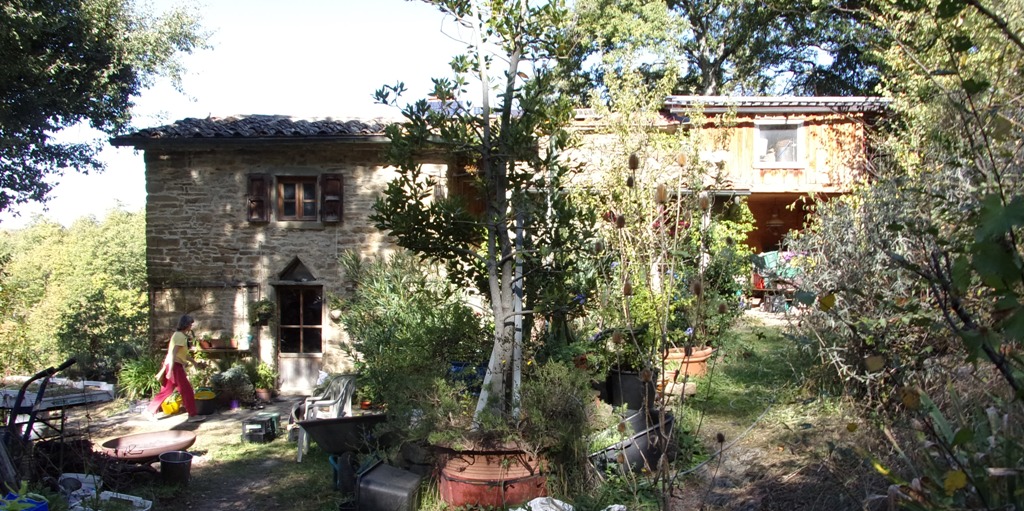
A Work and Culinary Holiday from October 4th to November 1st, 2023
Also see ‘Marroncello’ in February 2023 for some more background info.
This is all about my stay at ‘Marroncello’ with my friend Esther, who I’ve known for nearly 30 years. She and her partner Thomas look after the land surrounding a 300 year old traditional Tuscan farm house. The land on which they live and work amounts to about 5 Hectares and the vegetable crops as well as the herbs for their business are grown on terraces or in the valley. Many different sorts of useful ‘fruit’ trees are also grown. The house is located at 530 m and can be reached by a 700 m long track on foot or by tractor!
Native trees consist mainly of Oak along with Ash, Lime, ‘Sorbo’ and Juniper.
Marroncello means: a small orchard with Sweet Chestnut trees. Apparently there is still a small stand of them much higher above the house.
When Thomas ‘found’ the property it had been derelict for 50 years!
I stayed for 4 weeks helping along with all the jobs to be done at this time of the year and enjoying the much more natural and simple way of life in very beautiful surroundings!
I love all the plants including the ‘weeds’ that grow everywhere. It has been a bit of a puzzle to identify some of them without flower, so I will have to go back at some point in spring or early summer to see those flowering, as it will make identifying a bit easier!
I have used mainly my own pictures, but I have also used several from Wikipedia Commons with much gratitude.
Follow the links in my contents page for easier reading, the different colour backgrounds are ‘blue’ for general interesting information, ‘green’ for different uses and ‘pink’ for medicinal uses.
Introduction
‘Wurdies’ and Hildegard von Bingen
Day 1: Thursday 5th October
Weeding in the potato terrace; burning of plum branches; lunch and peach leaves.
Day 2: Friday 6th October
Violas in the valley; Noticable weeds; Caprese and ‘East’
Day 3: Saturday 7th October
Spelt bread, International Market in Arezzo and Chantarelles.
Day 4: Sunday 8thth October with temperatures to 30C!
‘Chiesa di Sant`Agata alle terrine’; Perennial Pepperweed or Dittander; Fennel tea and Rue
Day 5: Monday 9th October (with temperatures to 25C at 2pm)
Weeding viola; ‘Alsem’ or Wormwood; Spelt coffee; Lesser Galangal; Parasol Mushroom; Grass snake; Perpetual Spinach; Buckwheat.
Day 6: Tuesday 10th October (with temperatures to 28C)
to Arezzo; Orzo; Peach leaves and Drying shed; Dormouse or ‘Zevenslaper’
Day 7, Wednesday 11th October (21 C at 12.35pm)
Semolina; Cornelian cherries; Sweet chestnuts
Day 8, Thursday 12th October (24 C at 14.30)
Florence Fennel;
Day 9, Friday 13th October (20 C at 13.00)
Rocket or Rucola; visit to Arezzo.
Day 10, Saturday 14th October (22 C at 4pm)
Visit from a friend and some weeds around Marroncello
Three wildflowers from the Deadnettle or Mint family:
- Lesser Calamint
- Wild Basil
- Red Hemp-nettle
Day 11, Sunday 15th October (my brother Ber would have been 64 today..)
Ankle problem; Church visit; truffles…
Day 12, Monday 16th October 14C and cloud + sun!
Sila
Day 13, Tuesday 17th October (12C at 9.45)
Homemade pizza; Bermuda grass; Green Bristle-grass; St John’s-wort
Day 14, Wednesday 18th October (15 C and rain today!)
Egg-white treatment; lavender bags.
Day 15, Thursday 19th October (15 C and a bit of sun as well as rain)
Kaki or Persimmon
Day 16, Friday 20th October (22 C and a very stormy night!)
Bay berries picking and cleaning, a Praying Mantis and a Violet Carpenter Bee.
Day 17, Saturday 21st October (15 C at 9 am and lots of rain in the night!)
Rain is finally here!
Day 18, Sunday 22nd October (only 10 C in valley this morning, 16 C at 2 pm and sun with cloud.
Visit to ‘Chiesa di Sant`Agata alle terrine’; Olive trees; Tuscan Cypress; wild boar.
Day 19, Monday 23rd October (9 C this morning, 25 C in Arezzo in the afternoon)
Day 20, Tuesday 24th October (17 C in the day and a strong south-westerly wind called Sirocco in Italy)
Day 21, Wednesday 25th October (13 C in morning and 25 C in Arezzo!)
Marrubium terras, ‘Sorbo’, to Arezzo
Day 22, Thursday 26th October (13 C in morning, rain during night)
Day 23, Friday 27th October (rain and hard wind in morning but 19 C in afternoon and sunny/windy)
3 wreaths from Clematis vitalba or Old man’s beard
Day 24, Saturday 28th October (11 C this morning but sunny day mostly. Beautiful view of Orion and nearly full moon setting in the west!)
Honesty as kindling..
Day 25, Sunday 29th October (sun and cloud today and 16 C)
An evening lift to Rome…
Day 26, Monday 30th October (sun and very warm in Rome!!)
In Rome: Jasmine, bloodletting and a long trip back to Marroncello.
Day 27, Tuesday 31st October (mixed weather: early rain, blue sky at 9am and overcast in the afternoon)
An outing to Monte Dogana.
Day 28, Wednesday 1st November: last day in Italy! (Misty and 9 C at 8 am)
Some more native weeds around Marroncello Conclusion
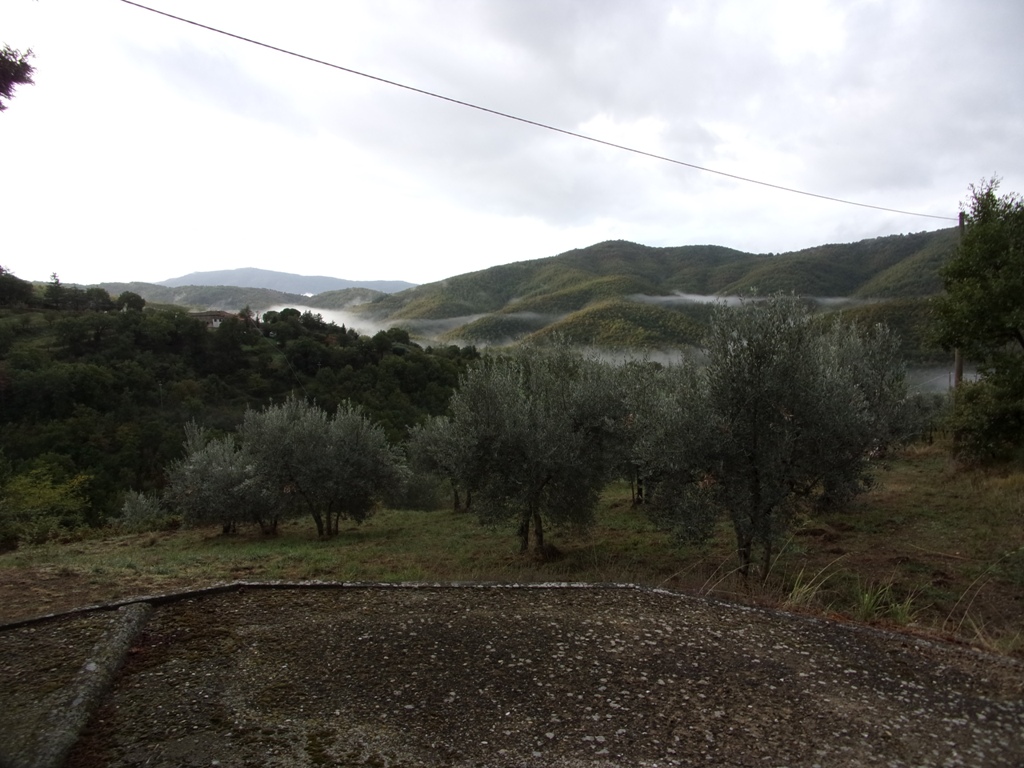
Introduction
After my 3 weeks stay back in February, I decided to return for 4 weeks to experience the autumn in Tuscany.
However, when I arrived in Arezzo on the 4th of October in mid afternoon, I was trying to stay in the shade whilst waiting for my friend Esther to pick me up, as it was more summer than autumn, being nearly 30C!!
These high temperatures more or less continued for quite some time during my stay, enabling me to use the outdoor shower on one of the terraces above the house. The long black water pipe draped along the slope warms up the water during the day, giving a lovely warm shower later in the day!
I wrote a diary every day, noting down the weather and our activities.
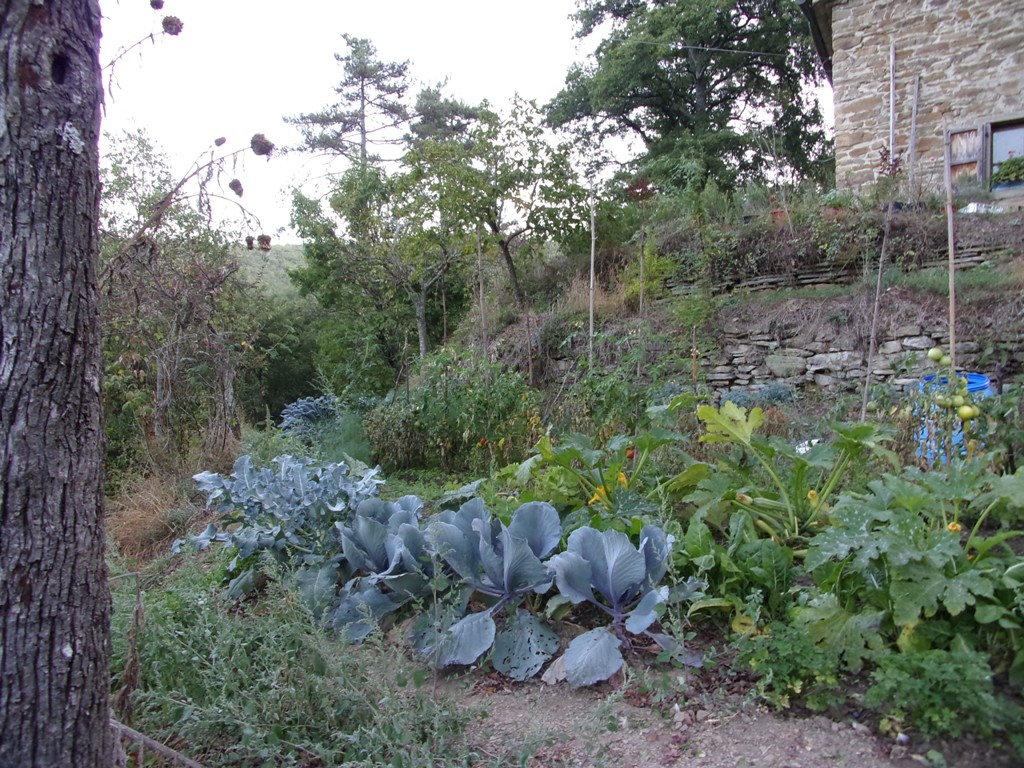
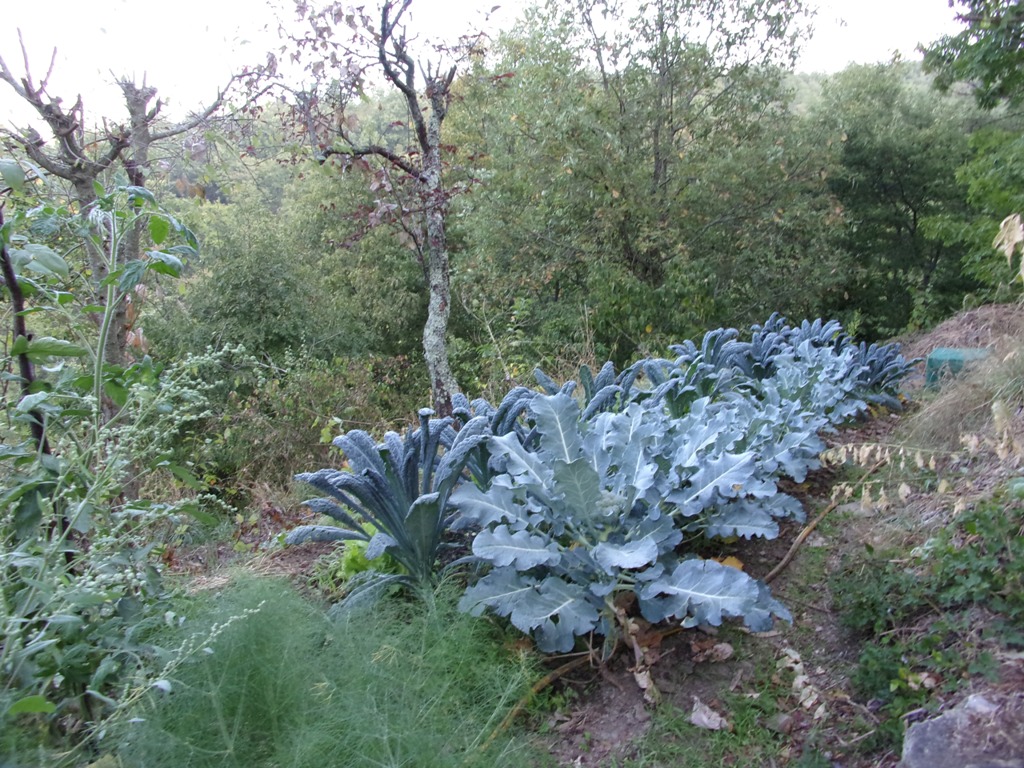
To make it more enjoyable and educational for you to read, I’d like to write a bit more about the different plants, crops, animals and anything else interesting I encountered. The crops are grown for medicinal use as well as for food. There are several terraces with a bounty of vegetables at Marroncello, most of them only sown or planted from July onwards. They provided most of the vegetables that we ate twice a day. Much of the information used is from Wikipedia, the free encyclopedia ‘online’. Also specific information about the plants and crops grown are by Esther.
‘Wurdies’ and Hildegard von Bingen
Thomas and Esther have a successful business based in Germany (see: https://www.wurdies.de ), which is growing, buying and selling herbs, spices and mixes for culinary as well as health benefit. Some of the herbs and spices they sell were also traditionally used by Hildegard von Bingen. (https://www.wurdies.de/hildegard.html )
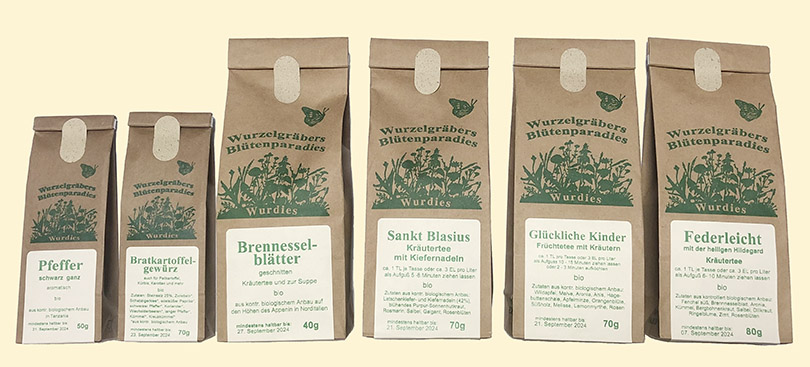
Hildegard of Bingen (c. 1098 – 17 September 1179), also known as Saint Hildegard and the Sibyl of the Rhine, was a German Benedictine abbess and polymath active as a writer, composer, philosopher, mystic, visionary, and as a medical writer and practitioner during the High Middle Ages. She is one of the best-known composers of sacred monophony, as well as the most recorded in modern history. She has been considered by scholars to be the founder of scientific natural history in Germany (from: https://en.wikipedia.org/wiki/Hildegard_of_Bingen )
More about Hildegard here.
‘Hildegard of Bingen says she was three-years old when she first saw a vision of “The Shade of the Living Light.” And she was five-years old when she grasped that others wouldn’t understand what she was experiencing. Even at this age, Hildegard knew that her visions were a gift from God.
The body of work surrounding Hildegard of Bingen writings is expansive and diverse. She was equal parts nun and scientist, theologian and philosopher, musician and poet, naturalist and doctor. Hildegard of Bingen’s historical impact results as much from her unique thinking as it does from her role in diligently recording the culmination of beliefs and practices over centuries of human experience.
Hippocrates, the father of modern medicine, declared “let food be thy medicine, and medicine be thy food.” The concept of food as medicine is ancient. What we put into our bodies is the first and most significant part of our overall health and well-being. The relationship between food and health was an essential, and easily observable, part of every healing tradition.’
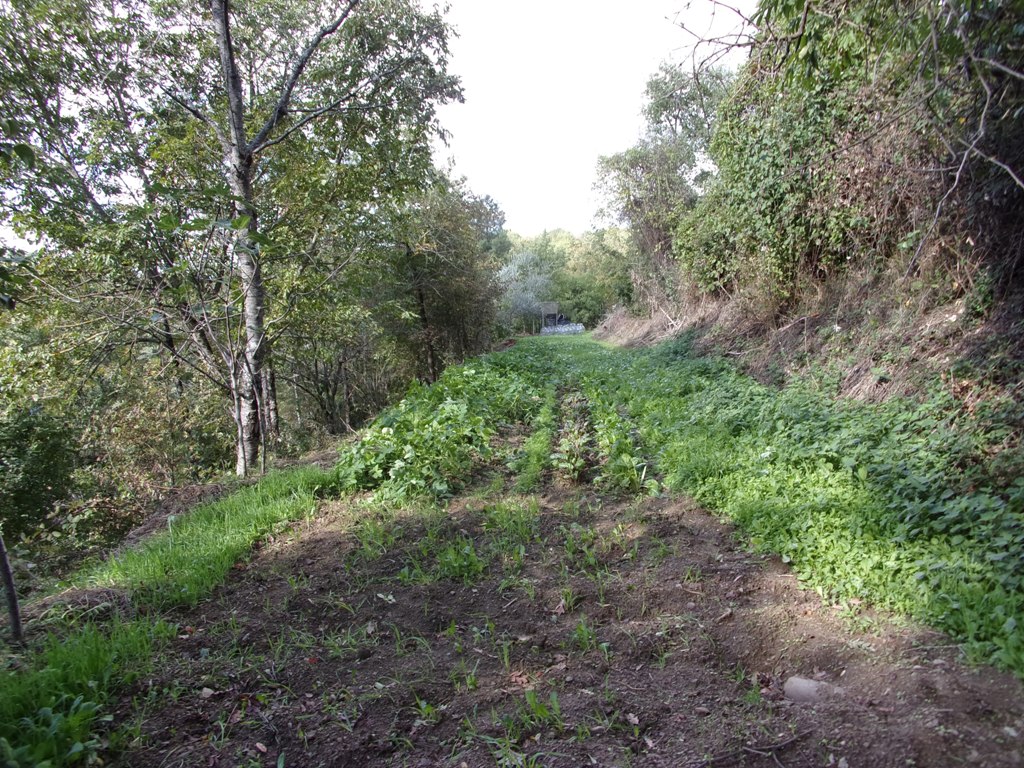
Day 1: Thursday 5th October
The first real ‘working’ day started on Thursday 5th October when we did some weeding in the ‘potato-terrace’ within the rows of carrots and beetroots.
Esther and Thomas have several areas on the terraces below and above the house where vegetables are grown from only July onwards as this is when they are having a bit more free time. They are very busy with harvesting and dealing with the commercial crops before this time in spring and early summer.
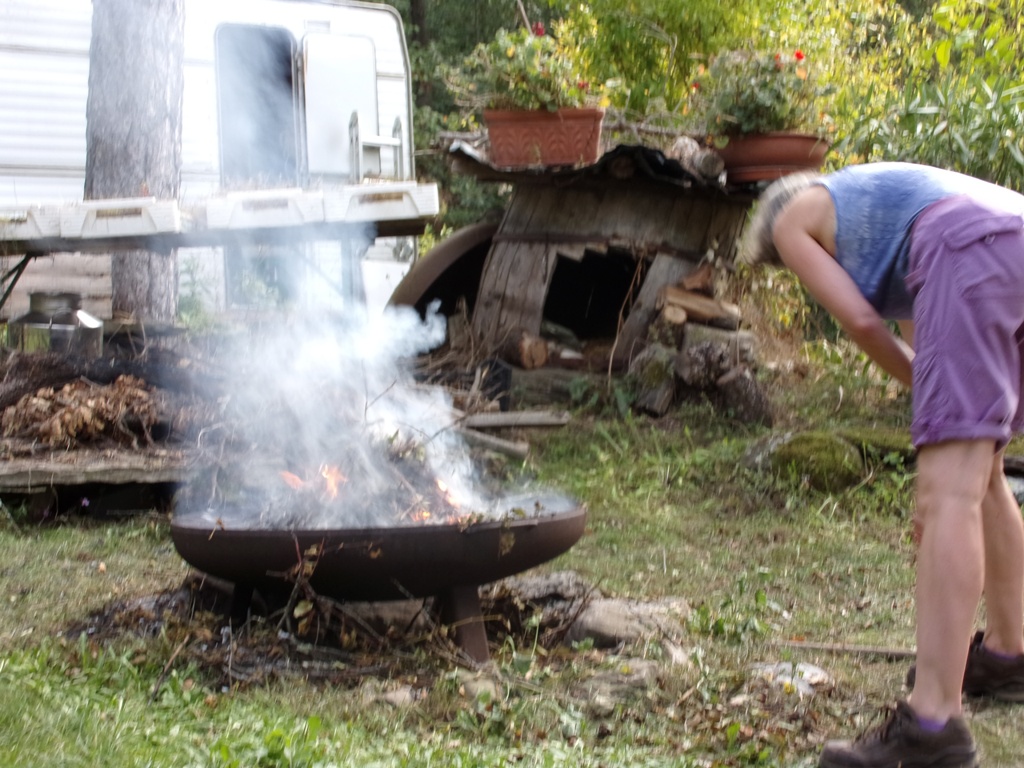
Esther made a fire with lots of plumwood. The ash is used as a remedy for hairloss, particularly for balding men.
We had a good lunch starting with a large green salad of iceberg lettuce, rocket and tomatoes as a starter, followed by French beans with Buckwheat.
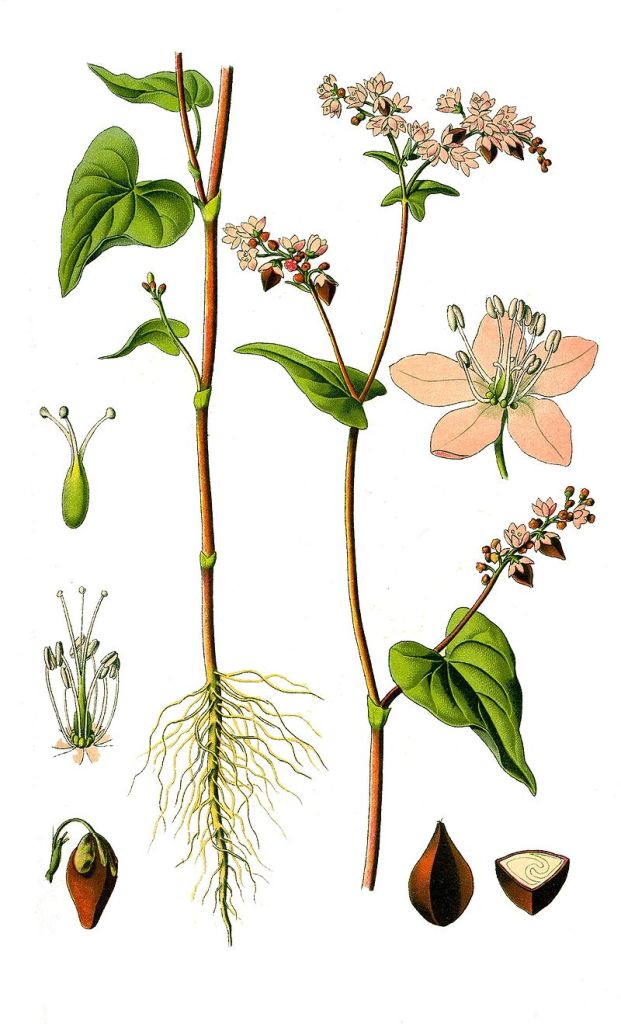
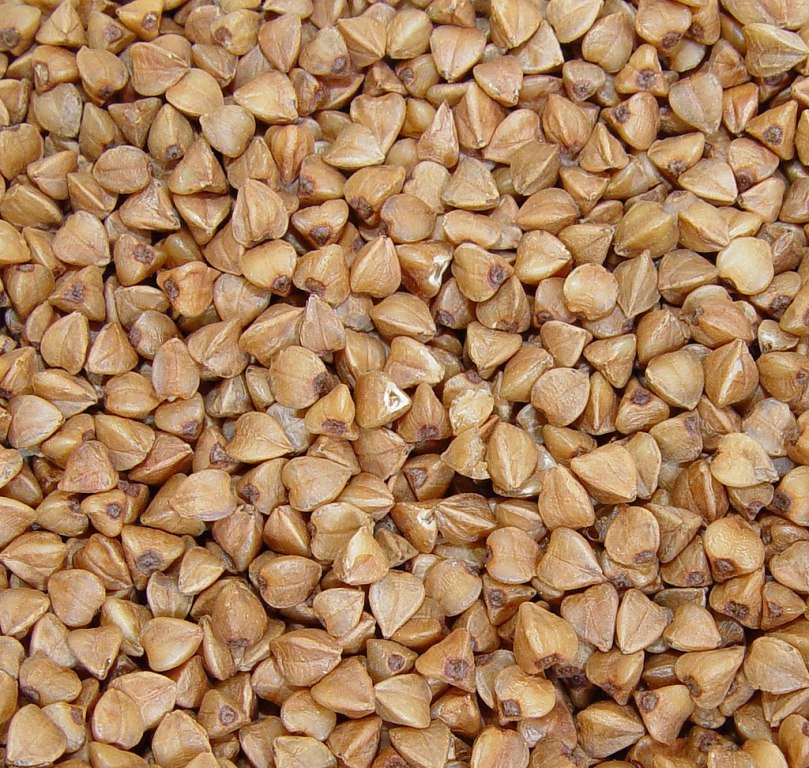
Buckwheat (Fagopyrum esculentum), or Common Buckwheat, is a flowering plant in the knotweed family Polygonaceae cultivated for its grain-like seeds and as a cover crop.
Despite its name, buckwheat is not closely related to wheat. It is not a cereal, nor is it even a member of the grass family. Buckwheat is related to sorrel, knotweed, and rhubarb, and is known as a pseudocereal because its seeds’ culinary use is the same as cereals, owing to their high starch content.
What is the best way to eat buckwheat?
Buckwheat ‘grains’ or seeds are also known as ‘groats’ and can be simmered until tender. It’s common practice to wash the grains well before use, but when soaked and then baked, they add crunch to granolas and salads. When soaked and blended before simmering, the buckwheat breaks down into porridge.
Why is buckwheat good for you?
It is gluten-free, a good source of fiber, and rich in minerals and various plant compounds, especially rutin. As a result, buckwheat consumption is linked to several health benefits, including improved blood sugar control and heart health.
We finished our meal with a semolina pudding.
Semolina is the name given to coarsely milled durum wheat mainly used in making couscous, pasta, and sweet puddings
After lunch we harvested peach leaves at a neighbour in the village. The leaves are dried in the drying shed above the house on large open wire drying racks. The racks are lined with an old sheet, which makes it easier afterwards to collect them in large sacks for taking back to Germany for processing. The peach leaves have been in high demand for several years at Wurdies.
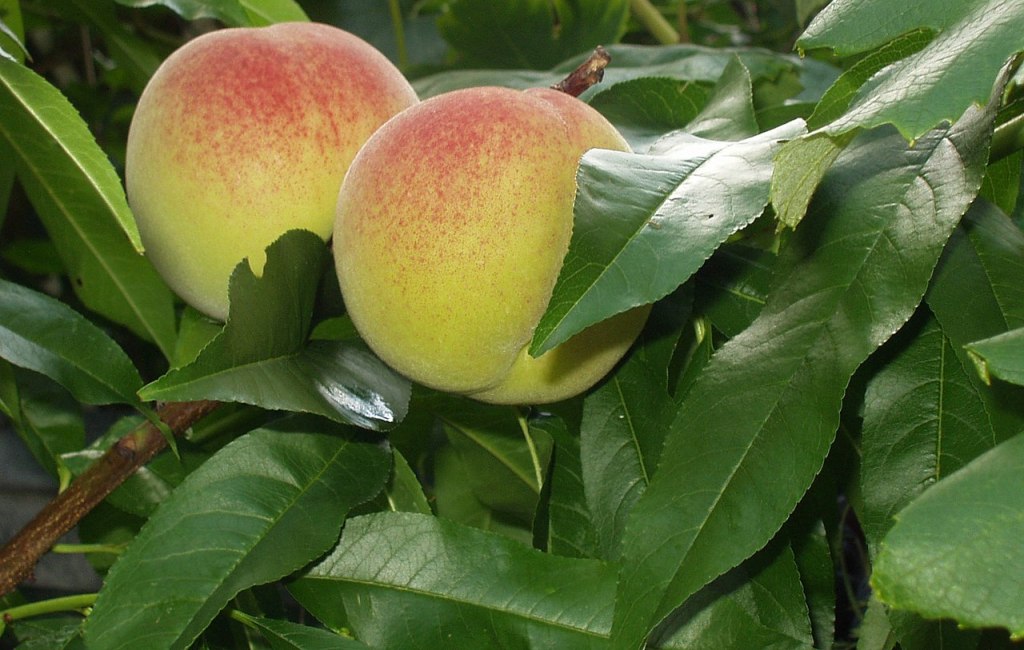
Use of Peach leaves:
These are dried and ground, adding several other ingredients and made into a mix which helps against hearing problems.
We had courgette and parsnip in the evening meal.
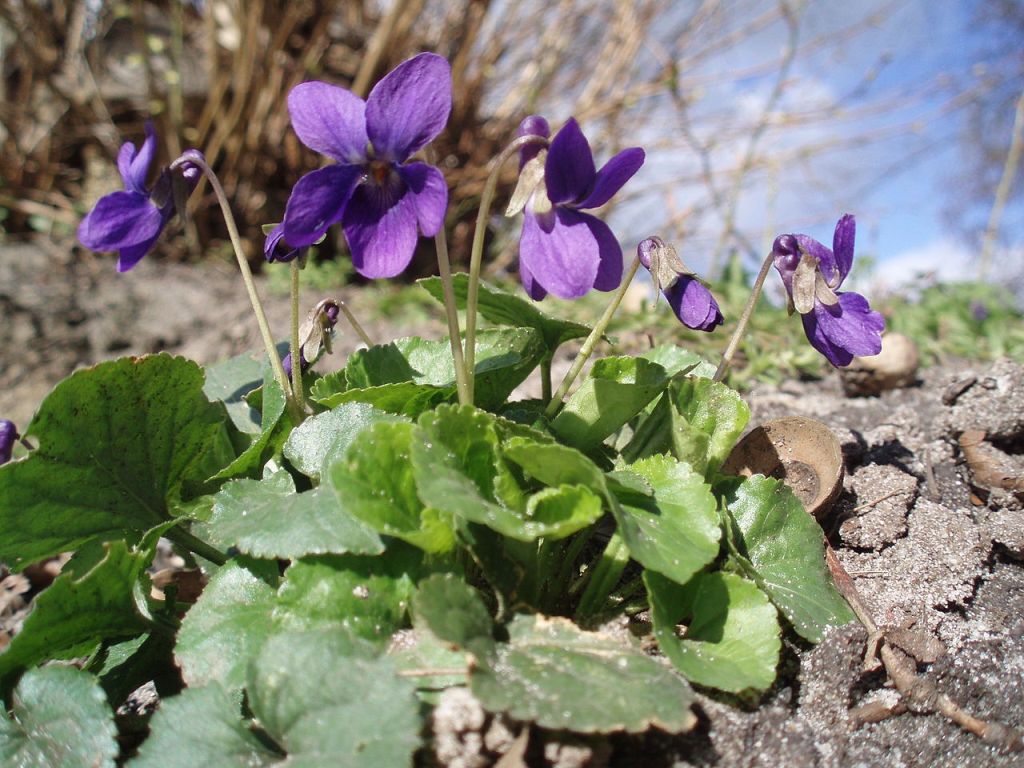
Day 2: Friday 6th October
In the morning we were weeding in the valley in between the viola crop (Viola odorata). These are grown for extracting the juice, once or twice a year. The sap is frozen and transported to Germany and sold to a firm who makes it into a cream for medicinal use.
The secondary pulp after liquidising is also used and boiled with several herbs/spices to make a special Viola wine, which helps to reduce melancholia.
The Viola odorata (Sweet Violet) and Viola tricolor (Wild Pansy, Heartsease and many other names) have a long history of use in herbalism and folk medicine and are also used as an ornamental plant as well as several other uses.
Some of the ‘weeds’ in and amongst the violas are: Oxalis, knotgrass, couch grass and great plantain, amongst several others.
One of the starters during my stay at Marroncello was ‘Caprese’.
Caprese salad is an Italian salad, made of sliced fresh mozzarella, tomatoes, and sweet basil, seasoned with salt, and olive oil.
At Marroncello there were plenty of tasty cherry and small plum-shaped tomatoes for this as well as the larger tomatoes used for sauces.
I did a bit of weeding in the Pepperweed or Lepidium latifolium, which also has many other common names. See more about this plant in Day 4.
Late afternoon we got some water from the neighbour’s outside tap to take to East later to fill his drinking water tank. See picture below of East.
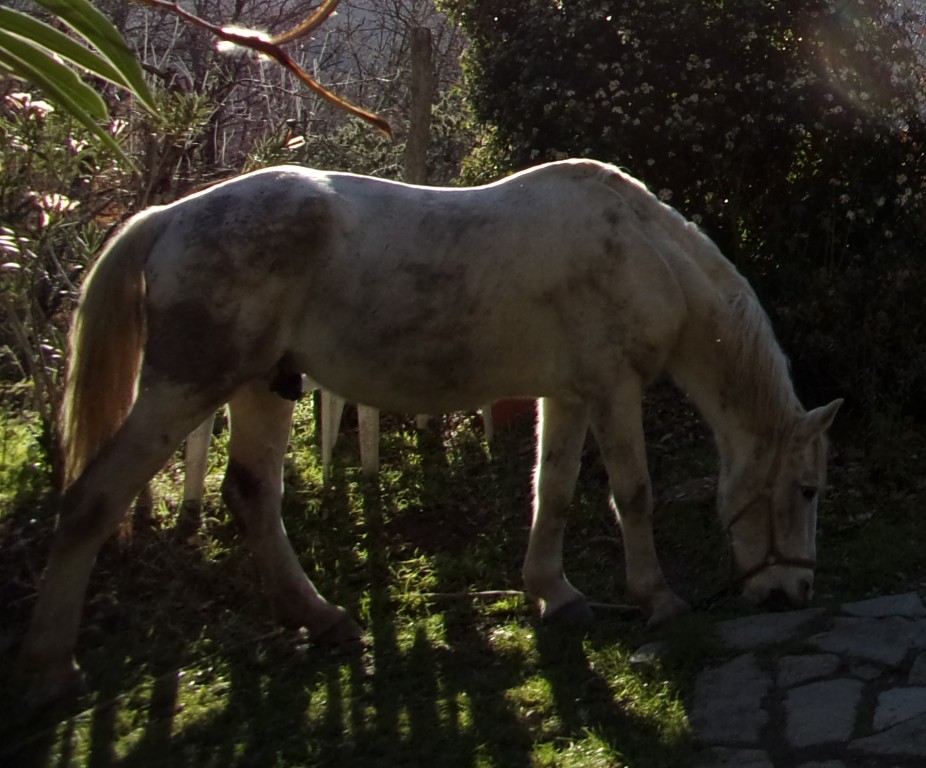
We took old paper to the recycling near Palazzo and we harvested some more peach leaves at neighbour Maria in the village.
For evening meal, we had polenta with a courgette and tomato sauce and I drank coffee made from spelt afterwards. This spelt is boiled up in water and makes a good alternative to ordinary coffee without the caffeine.
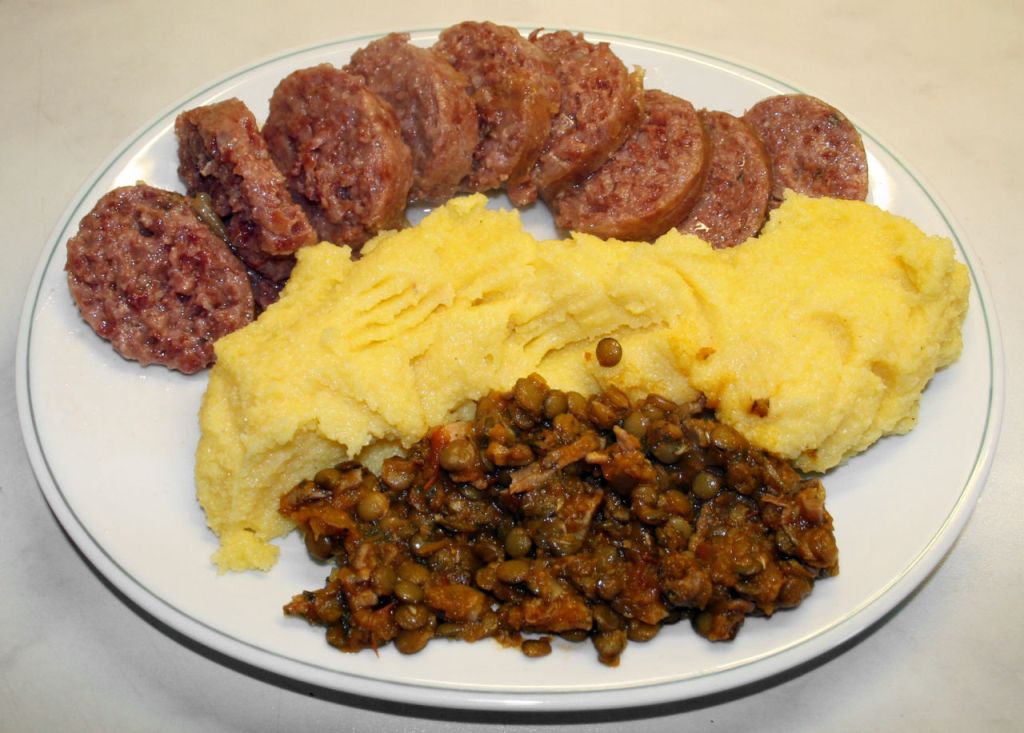
Polenta is a dish of boiled cornmeal that was historically made from other grains. The dish comes from Italy. It may be allowed to cool and solidify into a loaf that can be baked, fried, or grilled.
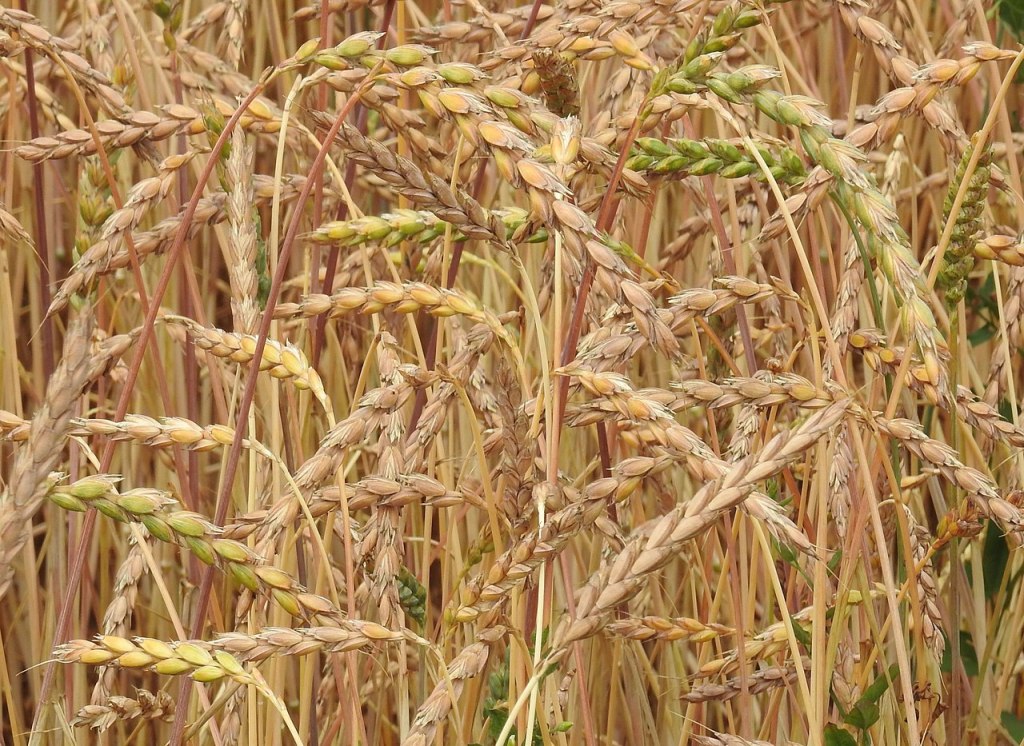
Day 3: Saturday 7th October
We had some nice slices of Spelt bread for breakfast which Esther baked yesterday!
Due to its unique qualities, spelt has gained popularity as an alternative to wheat. Both spelt and wheat belong to the Triticum genus of plants. The Triticum genus consists of grasses commonly cultivated for their seeds, otherwise known as “cereal grains.” 242 species of Triticum exist, with the most widely cultivated (by far) known as wheat or common wheat (Triticum aestivum).
Spelt, also known as dinkel wheat or hulled wheat, occupies a different subspecies (Triticum spelta) than wheat, and so spelt differs in many ways from common wheat.
Modern research has proven St. Hildegard is correct about spelt’s high nutritional value, even though she arrived at her conclusions without the benefit of our modern laboratories.
Spelt is a good source of vitamins, in particular the B Complex. B Vitamins help control the metabolism of carbohydrates, proteins and fats. Spelt contains more Vitamin B-1 (Thaimine), pantothenic acid and niacin than wheat, with comparable levels of B-12 (Riboflavin).
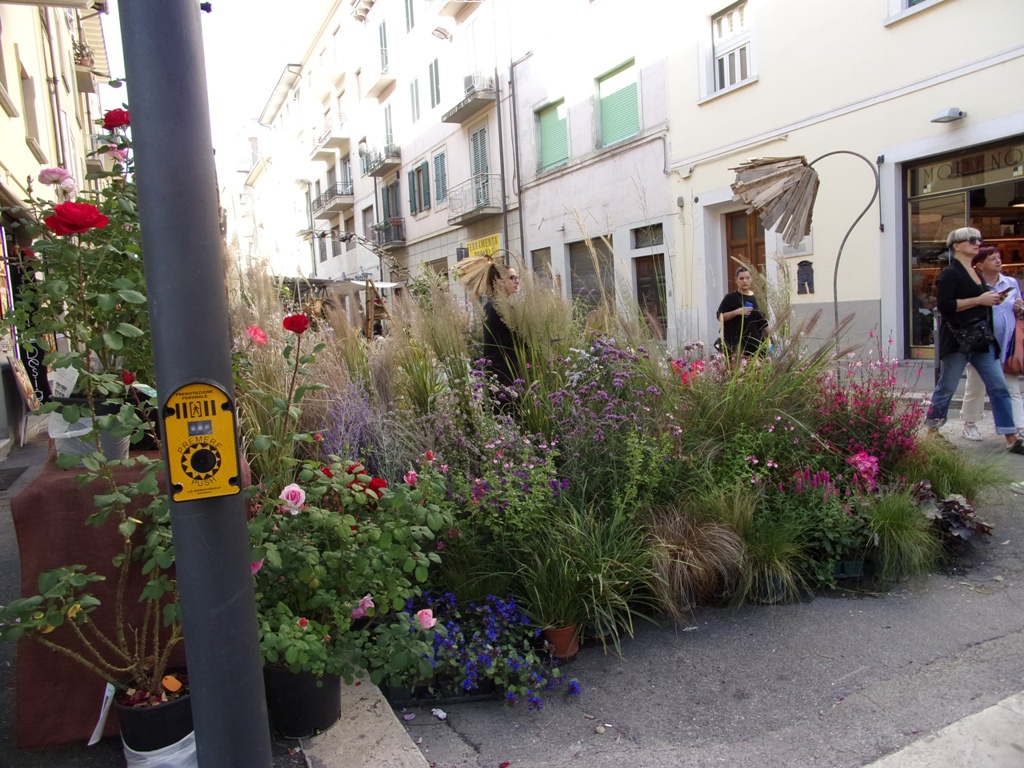
We went to the International market in Arezzo this morning, which is once a year. We managed to get all the shopping we wanted and Esther bought some chanterelle mushrooms from the ‘normal’ market, which is there every Saturday and we ate them later that evening with spaghetti!
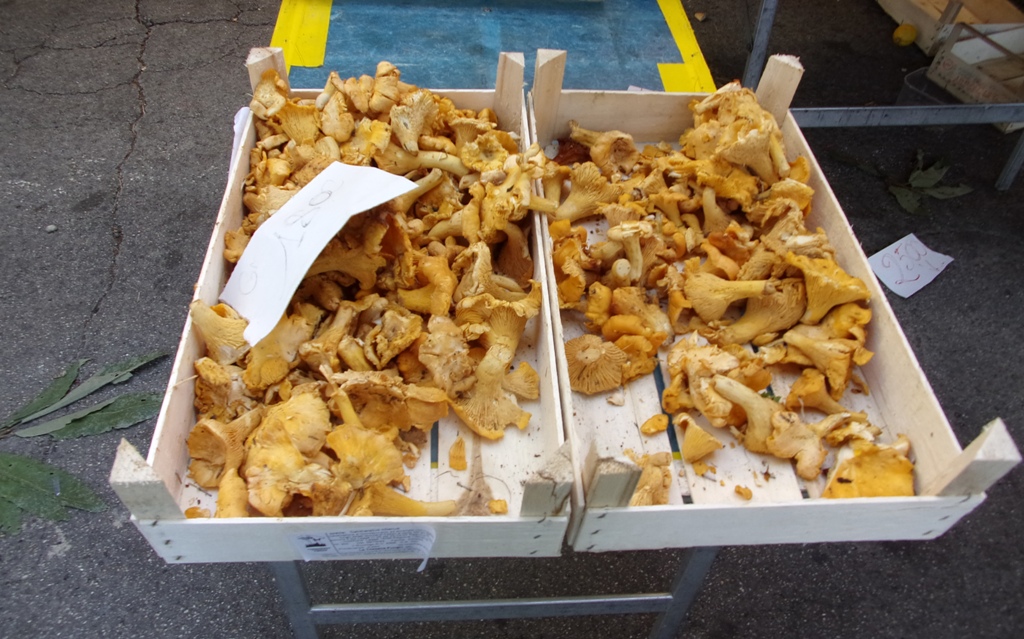
Chanterelle is the common name of several species of fungi in the genera Cantharellus, Craterellus, Gomphus, and Polyozellus. They are among the most popular of wild edible mushrooms.
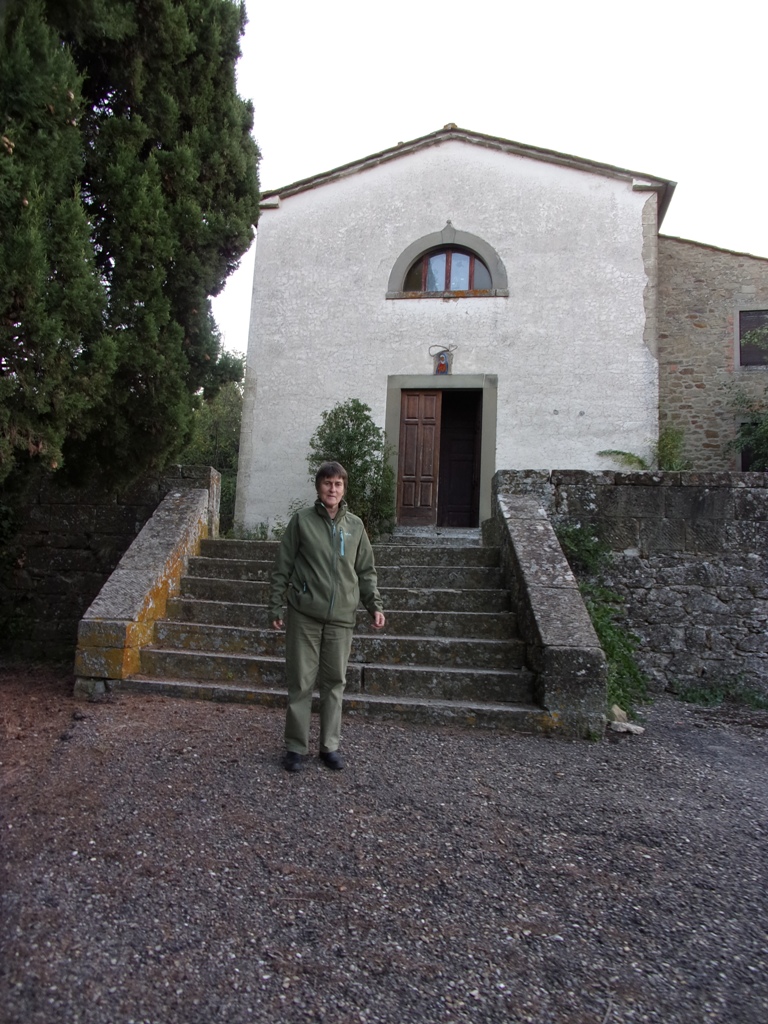
Day 4: Sunday 8thth October with temperatures to 30C!
We got up early and went to the little Church or ‘Chiesa di Sant`Agata alle terrine’ for the morning mass. I couldn’t follow anything unfortunately but it was a nice place to go to and Esther gave a lift back to one local church member who kindly showed us her peach trees, which we will be harvesting for leaves later this week.
We had some yoghurt when we got back, along with grapes, banana and Cornelia cherries added. More about the Cornelian cherries in Day 7.
After our morning snack we weeded in the Perennial Pepperweed or Lepidium latifolium.
Lepidium latifolium, known by several common names including Perennial pepperweed, Broadleaved pepperweed, Pepperwort, or Peppergrass, Dittander, Dittany, and Tall whitetop, is a perennial plant that is a member of the mustard and cabbage family.
This plant and many other members of the Brassicaceae family are also found in my blog!
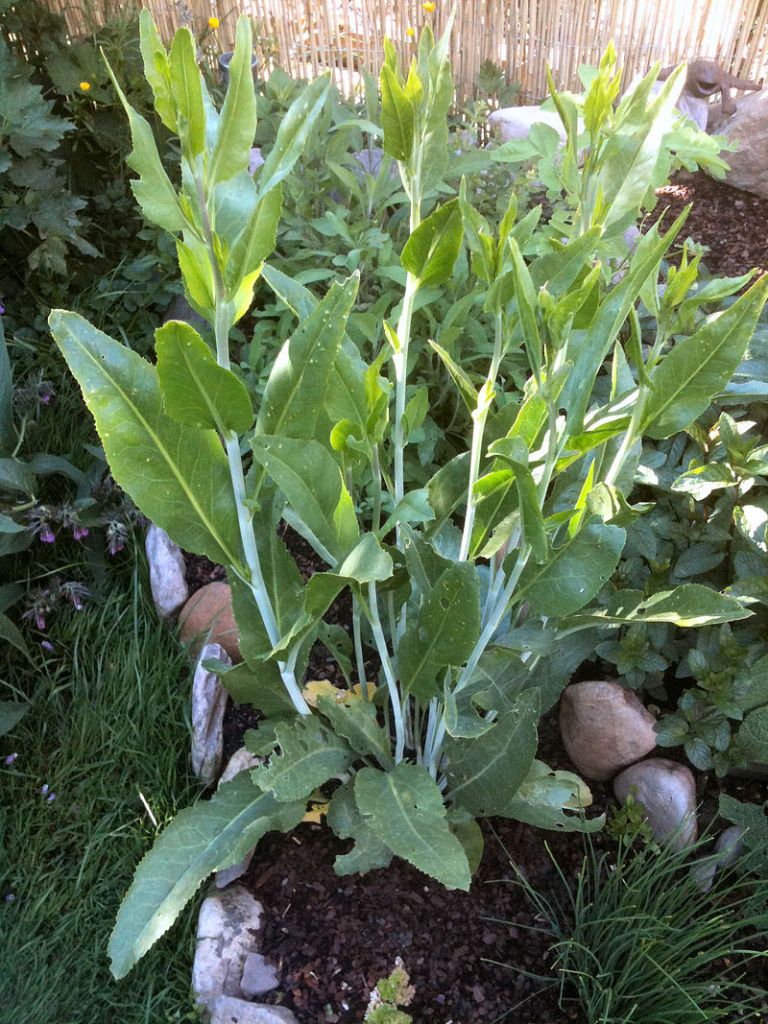
This is also native in Britain: and grows in coastal creek-sides, coastal ditches, sea-walls, open brackish grassland and the upper fringes of estuarine salt marshes. It is also naturalized in disturbed areas such as waste ground, docklands, railways and roadsides. Its extensive root system allows it to persist amongst coarse vegetation.
L. latifolium was cultivated up to the 17th century as a hot flavouring before Armoracia rusticana replaced it.
At Marroncello it is grown to go into a mix as an antibacterial and antiviral remedy for flu and colds.
We had a 3 coarse meal for lunch:
- Green salad with Iceberg lettuce and rocket
- Soup with nettle, courgette and parsnip
- Potato with Broccoli
I couldn’t finish the evening meal which Esther prepared: which was most unusual! We had home-grown French beans with tomatoes and rice. It was probably because of the very warm weather! I also had many insect bites, which is rare for me in Britain, by midges!
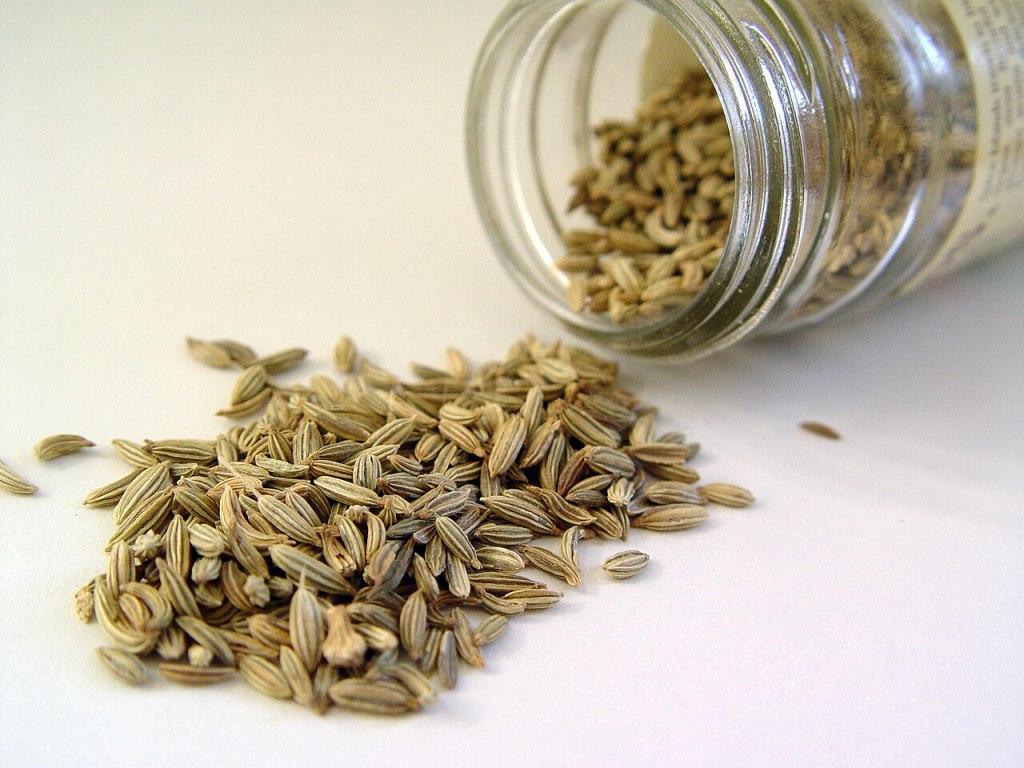
We had fennel tea in the evening:
Fennel (Foeniculum vulgare) is a flowering plant species in the carrot family. It is a hardy, perennial herb with yellow flowers and feathery leaves. It is indigenous to the shores of the Mediterranean but has become widely naturalized in many parts of the world, especially on dry soils near the sea-coast and on riverbanks.
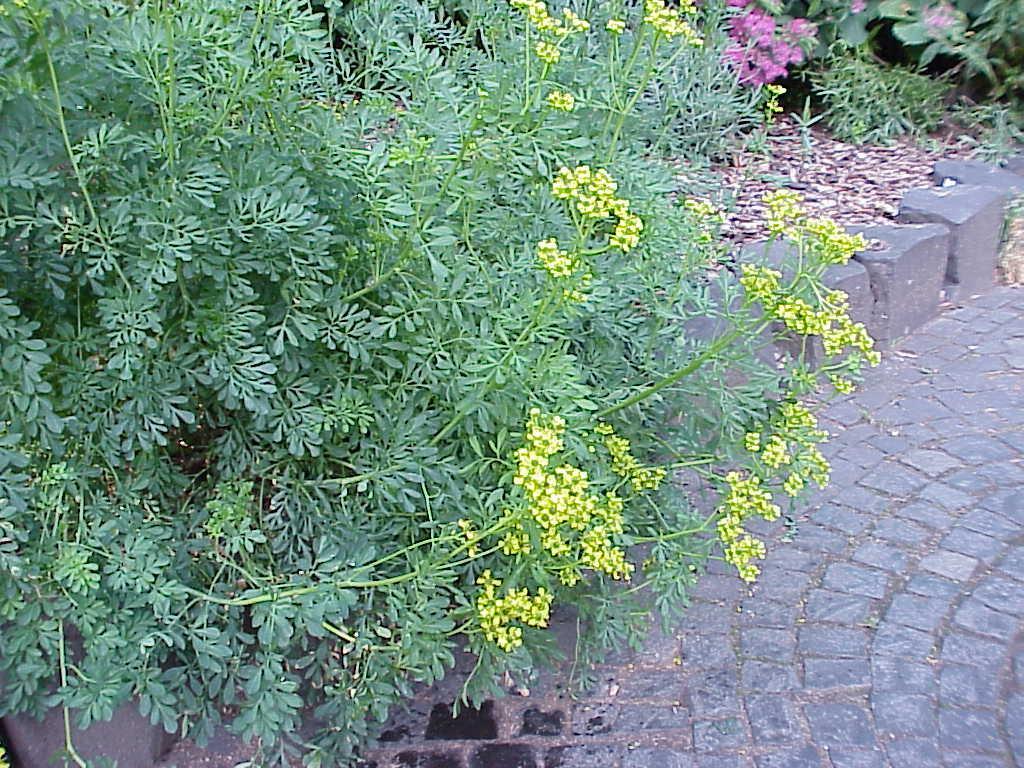
We watered the rowes of Rue in the evening with water which was still left in the tanks. All the crops are very dry due to a lack of proper rain since July. It is grown on 2 levels in several rows on a terrace above the house.
Rue or Ruta graveolens is one of the sacred herbs of the ancient world and was once used by the Roman Catholic Church for exorcism. (From: Bartram’s Encyclopedia by Thomas Bartram)
Uses (medicinally):
- To promote menstrual flow after months of absence.
- Used as an eye-douche for over-use of eyes, eyes that tire easily, weak eyes with a tendency to inflammation.
- Headaches due to eye strain.
- Bruised bone, cartilage troubles, ganglion of wrist. (tea + compress)
- Sprains of wrists and ankles (compress).
- Dry skin, to promote perspiration.
- Bell’s palsy (tea).
- Mouth ulcers (mouth wash).
- Rue tea is a traditional remedy for multiple sclerosis.
It is also good for menopausal problems according to Esther!
Internal use today is discouraged in modern practice.
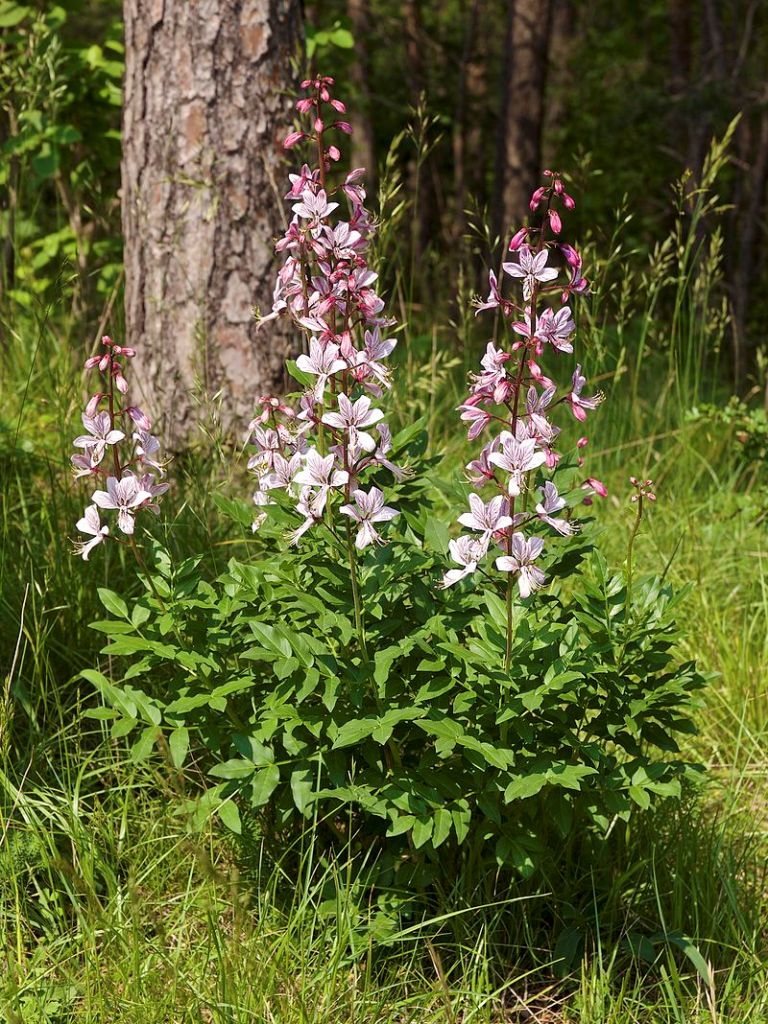
In some of the rows with Rue, there are also some plants of Dittany growing. See more here in Wikipedia.
From https://www.healthyhildegard.com/medicinal-uses-for-dittany/ :
Dittany, or Dictamnus albus, is a genus of the family Rutacaea, commonly known as the Rue or Citrus family of plants. It is an endemic plant of the Greek island of Crete and has antioxidant, anti-microbial, and anti-ulcerative properties.
This was Hildegard’s view about the Dittany to help against Kidney Stones:
“The Dittany is warm and dry, and has the power of fire and the forces of stone. It has the hardening force of stone, and possesses the heat of fire, because of the gas that emanates from it. Dittany is strong against diseases, over which it has the upper hand. Kidney and gallstones can naturally grow fat in humans. When stones begin to grow, pulverize dittany and eat the powder with wheat bread. This will prevent the stone from growing. For those suffering with kidney and gallstones, put dittany powder in vinegar, mixed with honey, and drink this often sober. This solution will break down the stone. For those with heart pain, consume dittany powder to ease the pain.” -Hildegard of Bingen
Day 5: Monday 9th October (with temperatures to 25C at 2pm)
I’ve been weeding amongst the Viola odorata in the valley this morning.
We met up with Fabrizio who was weeding mainly oak saplings in the field below. Later on he and Rita carried on weeding in the ‘Alsem’ (or Common Wormwood is its common name in the U.K and Artemisia absinthium its scientific name), which is on the sunny site of the field next to the Viola crop. Rita had brought a lot of peach leaves, which she had picked yesterday in 3 hours!
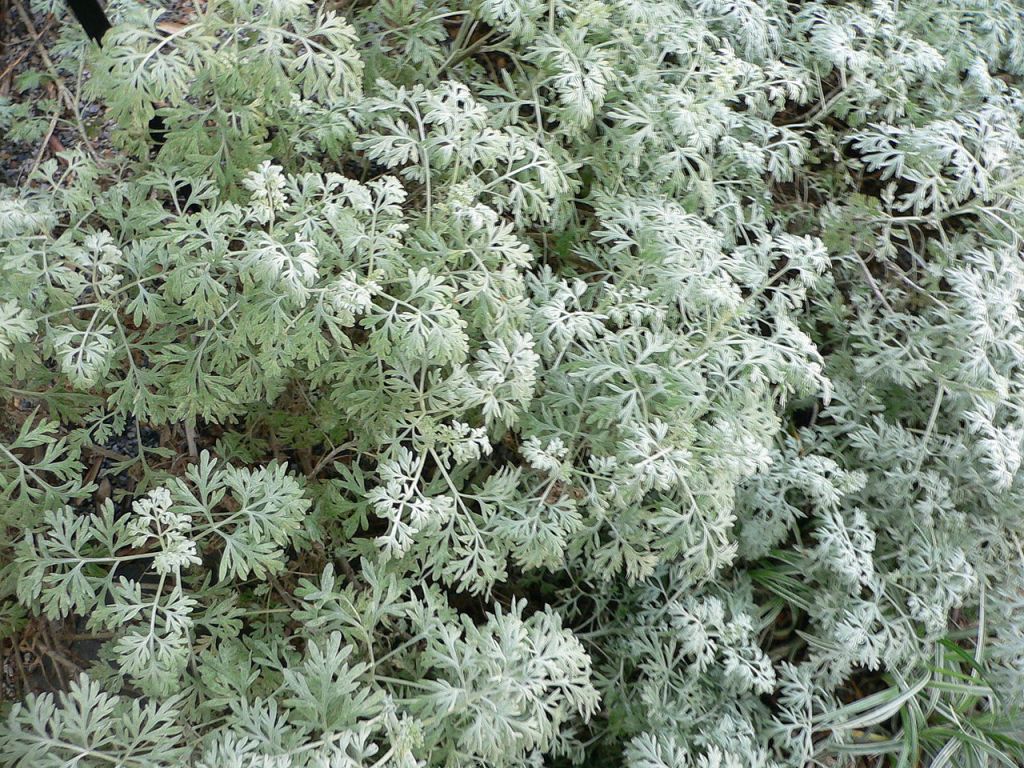
Wormwood or Artemisia absinthium (source Bartram’s Encyclopedia by Thomas Bartram)
Medicinal Uses:
- Feeble digestion, liver and gallbladder congestion with yellow tinge of skin and sclera of eyes (jaundice).
- Depression of liver origin, foul breath, lack of appetite, nausea, vomiting.
- To promote stomach acid production in the elderly.
- Abnormal absence of periods.
- Travel sickness before a journey.
- To expel worms.
- Used to make “absinthe” historical drink.
- To make Vermouth- a pleasant way of taking wormwood and also a traditional medicinal wine in Russia. (for rheumatism, travel sickness and as a tonic)
At Maroncello much Wormwood is grown. It is harvested fresh and then ‘juiced’. The juice is frozen and transported to Germany. It is also used in a special Wormwood wine with honey which is good for the eyes, blood and many other things. A small glass of this in the morning is beneficial.
We had lunch after Esther picked me up from the field. We had courgette, fish and leftovers from last night!
Drank Spelt coffee after, which is a good alternative to real coffee as it’s got a lovely bitter taste!
It is made from roasted spelt which you have to add to water and boil up.
I like to add a small spoon of dried Galangal as a health benefit and it gives some extra pleasant ‘warmth’. This is good for the heart and the blood circulation.
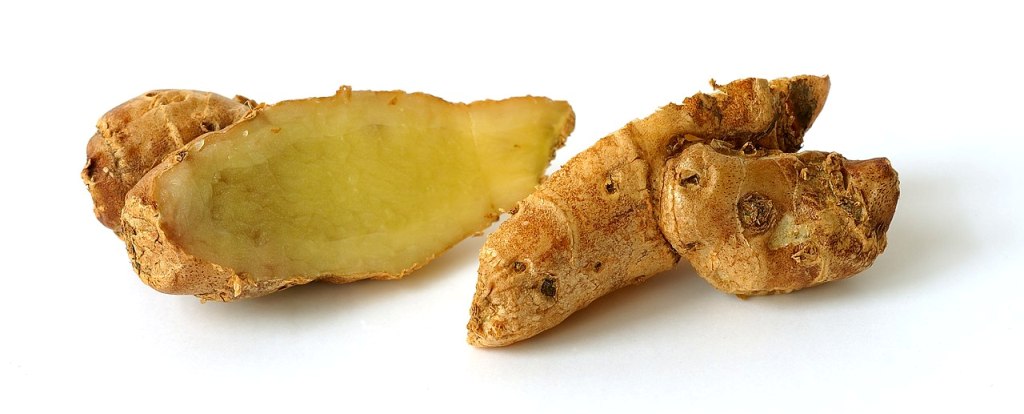
Lesser Galangal or Alpinia officinarum is a plant in the ginger family, cultivated in Southeast Asia.
( from: https://en.wikipedia.org/wiki/Alpinia_officinarum )
Alpinia officinarum, known as lesser galangal, is native to China, growing mainly on the south-eastern coast, including Hainan, and is also grown in Japan, Thailand, and Vietnam. It is also cultivated in India. Hong Kong is the commercial centre for the sale and distribution of the lesser galangal. It can grow 1.5 to 2 m high,with long leaves and reddish-white flowers. The rhizomes, known as galangal, are valued for their sweet spicy flavour and aromatic scent. These are used throughout Asia in curries and perfumes, and were previously used widely in Europe as a herbal remedy.
The galangal rhizomes were widely used in ancient and medieval Europe, where they were reputed to smell of roses and taste of sweet spice. Its use in Europe has dramatically declined.
In Asia the rhizomes are ground to powder for use in curries, drinks, and jellies. In India an extract is used in perfumes, and Tatars prepare a tea with it.
Alpinia officinarum contains high concentrations of the flavonol galangin. Historically, the rhizomes were reputed to have stimulant and digestive effects.
After lunch we brought the peach leaves Rita had picked the previous day to the drying shed and spread them on 4 drying racks.
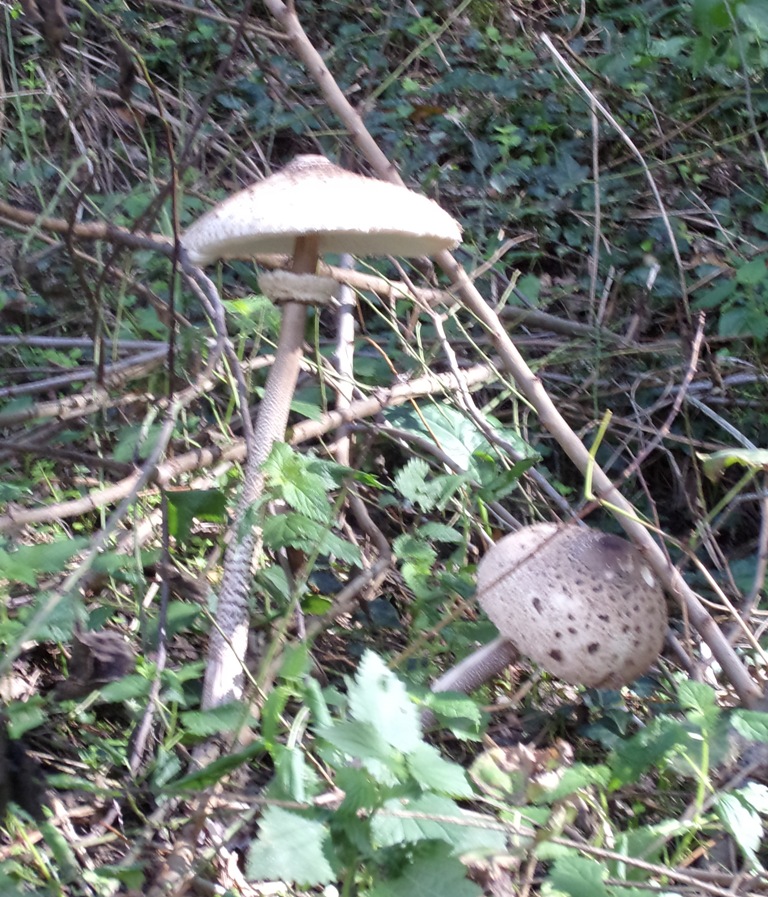
Saw about 10 large Parasol mushrooms on the potato terrace as well as a small snake slithering onto the bank when I spotted it! This may have been a ‘Biscia’ according to Esther!
Later I found out it might have been a grassnake called Biscia dal collare or Natrice dal collare or Natrix natrix,which is very common here. Please see this excellent website all about snakes in Italy.
Parasol Mushroom or Macrolepiota procera , is a basidiomycete fungus with a large, prominent fruiting body resembling a parasol. It is a fairly common species on well-drained soils. It is found solitary or in groups and fairy rings in pastures and occasionally in woodland. Globally, it is widespread in temperate regions.
Macrolepiota procera is a choice edible mushroom. It is very sought-after and popular in Europe, due in part to its large size, seasonal frequency, and versatility in the kitchen. In the UK, it may be found from July through to November.
Later that afternoon we went to the petrol station and combined it with feeding East in the valley!
Our evening meal was leaf beet with buckwheat + Parasol Mushroom (!)
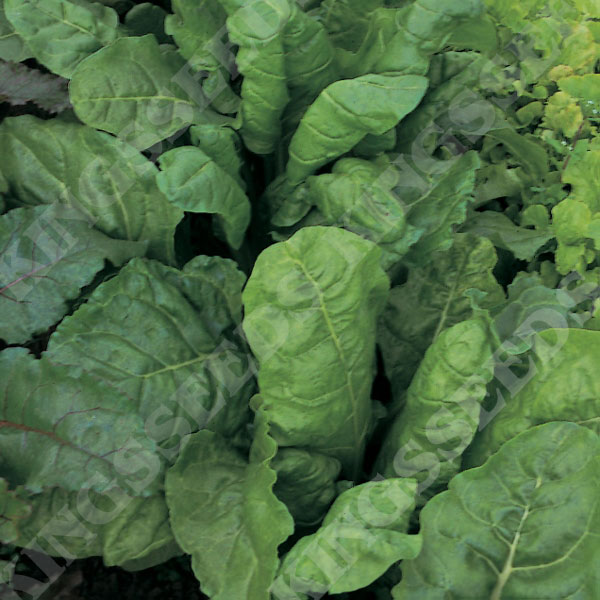
Leaf Beet/Perpetual Spinach or Beta vulgaris subsp. cicla var. cicla (from Kings Seeds info) related to Chard (Beta vulgaris subsp. vulgaris, Cicla Group and Flavescens Group)
Perpetual Spinach is not a true Spinach but used in exactly the same way. It is a member of the beet family, and is also known as Spinach Beet. It does not run to seed in dry conditions and is winter hardy. It produces a mass of mid-green leaves with thin stems. Good resistance to bolting within the first season. These can be slow to germinate and take approximately 65 days to mature.
The related Chard has much thicker stems and comes in various colours. See Wikipedia for more information on the various Beta vulgaris varieties.
Day 6: Tuesday 10th October (with temperatures to 28C)
This morning I was invited by Esther to come to her Yoga class in Arezzo.
It was good fun and I managed to do most of the poses watching Esther and my neighbours! Afterwards, we had a drink and some nice sweet bread in a nearby supermarket complex. I had my usual large barley coffee or ‘Orzo’
Caffè d’orzo (pronounced [kafˌfɛ dˈdɔrdzo] is Italian for “coffee of barley” (often shortened to simply orzo) or barley coffee. It is a type of hot drink, originating in Italy. Orzo is a caffeine-free roasted grain beverage made from ground barley.
Then we went to the garage as Esther’s car had all of a sudden stopped again on the way to Arezzo in the morning and it needed to be booked in to see what is wrong with it!
We had lunch at home consisting of a lovely green salad with boiled eggs which Rita’s chicken had provided + leftovers from yesterday and some tasty yoghurt with granola as a dessert.
I managed to do a little weeding near the toilet in the viola terrace, but as it was very warm we made 35 lavender bags, instead, in the kitchen where it was a lot cooler and in the late afternoon we went over to Maria to pick leaves from her 3 Peach trees. It took 1 hour with the 3 of us. We fed East on the way home in his field in the valley.
We carried the heavy bag with leaves up the hill and had a rest first before we ascended to the drying shed where we spread it on 5 drying racks. Esther turned all the other racks in order to get even drying.
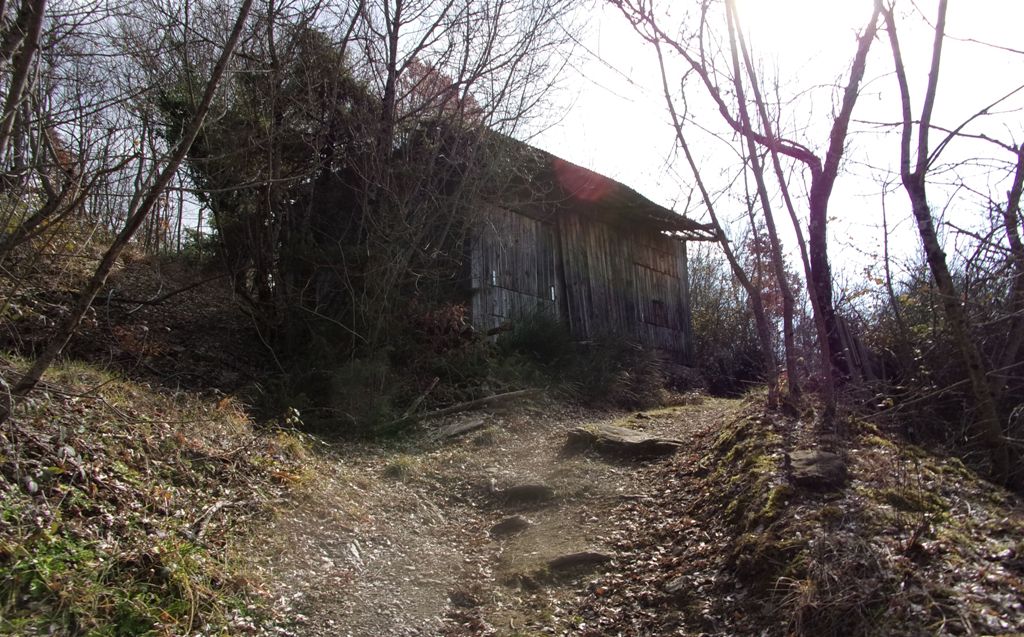
Esther was telling about the ‘Zevenslaper’ which seemed to be back as we noticed some detritus on the floor. He or she has been making a nuisance of itself sleeping and helping itself to the drying leaves all summer! In the U.K., this is called the European, edible or fat, (which is kinder?) dormouse.
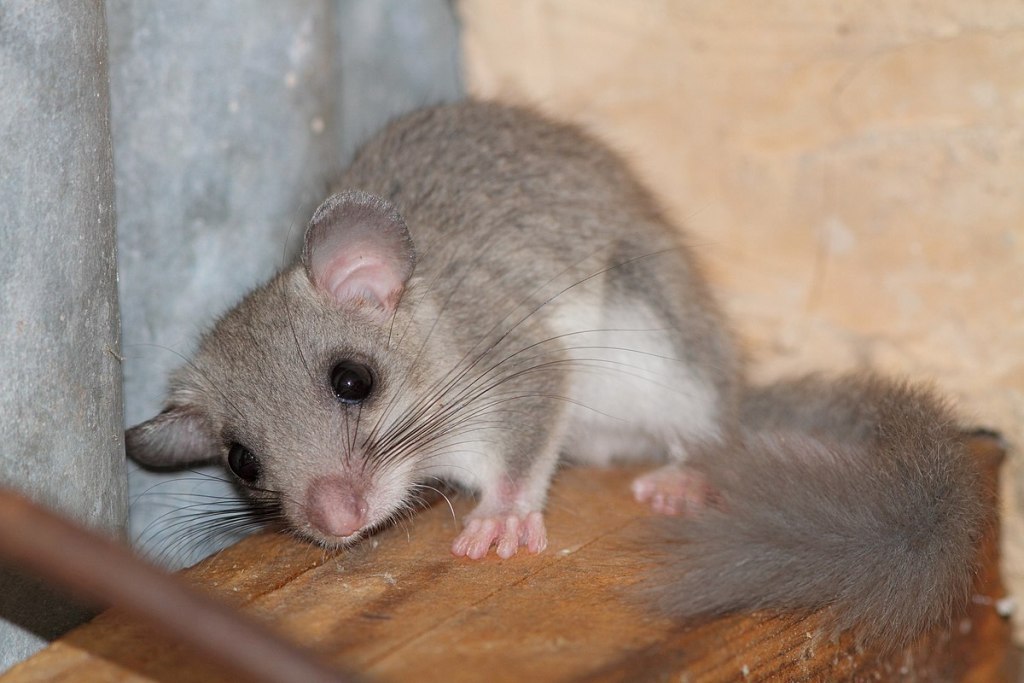
picture by Bouke ten Cate in Wikipedia
The ‘Zevenslaper’ or European edible dormouse or European fat dormouse (Glis glis) is a large dormouse and one of only two living species in the genus Glis, found in most of Europe and parts of western Asia. The scientific name comes from the Romans, who ate them as a delicacy.
In the meantime I picked nettle tips on the potato terrace, where they are growing in abundance!
We ate those in the evening with boiled potatoes!
Day 7, Wednesday 11th October (21 C at 12.35pm)
It was a very misty start this morning!
For breakfast I had boiled Semolina (no oats left!) with apple and cornelian cherries (Cornus mas)
Semolina is the name given to coarsely milled durum wheat mainly used in making couscous, pasta, and sweet puddings. Semolina made from hard durum wheat (Triticum turgidum subsp. durum) is pale yellow in colour. It may be milled either coarse or fine.
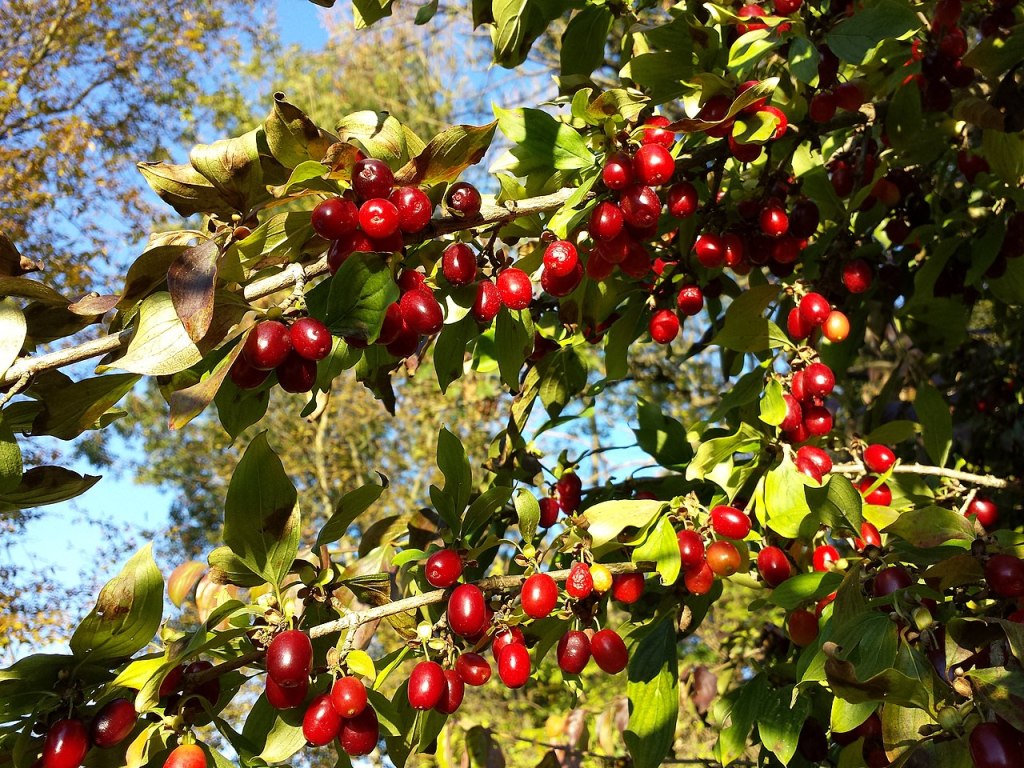
Cornus mas, commonly known as cornel (also the Cornelian cherry, European cornel or Cornelian cherry dogwood), is a species of shrub or small tree in the dogwood family Cornaceae native to Western Europe, Southern Europe, and Southwestern Asia.
This is one of the main (small) trees growing in the valley, especially near the stream. It was incredible to still be able to pick ripe fruit in October. It is a very useful plant!
It is a medium to large deciduous shrub or small tree growing to 5–12 m tall, with dark brown branches and greenish twigs. The flowers are small (5–10 mm in diameter), with four yellow petals, produced in clusters of 10–25 together in the late winter, well before the leaves appear. The fruit is an oblong red drupe 2 cm long and 1.5 cm in diameter, containing a single seed. When ripe, the fruit is dark ruby red or a bright yellow. It has an acidic flavour which is best described as a mixture of cranberry and sour cherry. It is mainly used for making jam.
The species is also grown as an ornamental plant for its late winter yellow flowers, which open earlier than those of Forsythia. While Cornus mas flowers are not as large and vibrant as those of the Forsythia, the entire plant can be used for a similar effect in the landscape.
The wood of C. mas is extremely dense and, unlike the wood of most other woody plant species, sinks in water. This density makes it valuable for crafting into tool handles, parts for machines, etc.
In Italy, the mazzarella, uncino or bastone, the stick carried by the butteri or mounted herdsmen of the Maremma region, is traditionally made of cornel-wood, there called crognolo or grugnale, dialect forms of Italian: corniolo.
The leaves (and fruit) are used in traditional medicine in Central and Southwest Asia
Both Esther and I carried on weeding in the viola crop down in the valley this morning. Rita and Fabrizio were already busy chopping weeds amongst the Alsem.
It was tiresome to walk uphill later to the house with all the clothes washing Rita had done for Esther as well as the ladder and hook we used for the peach leaf picking.
I cut some rocket on the ‘shower terrace’ for lunch and we also had French beans + tomato and rice for lunch.
Spelt coffee after + 2 cookies!
After lunch I picked some more peach leaves and brought them to the drying shed.
Had a lovely warm outdoor shower and heard a wild boar. Unfortunately, I never saw one during my stay!
Thomas was back from Germany and as well as beans + rice we also had roasted sweet chestnuts, which are harvested en masse here in Italy at the moment!
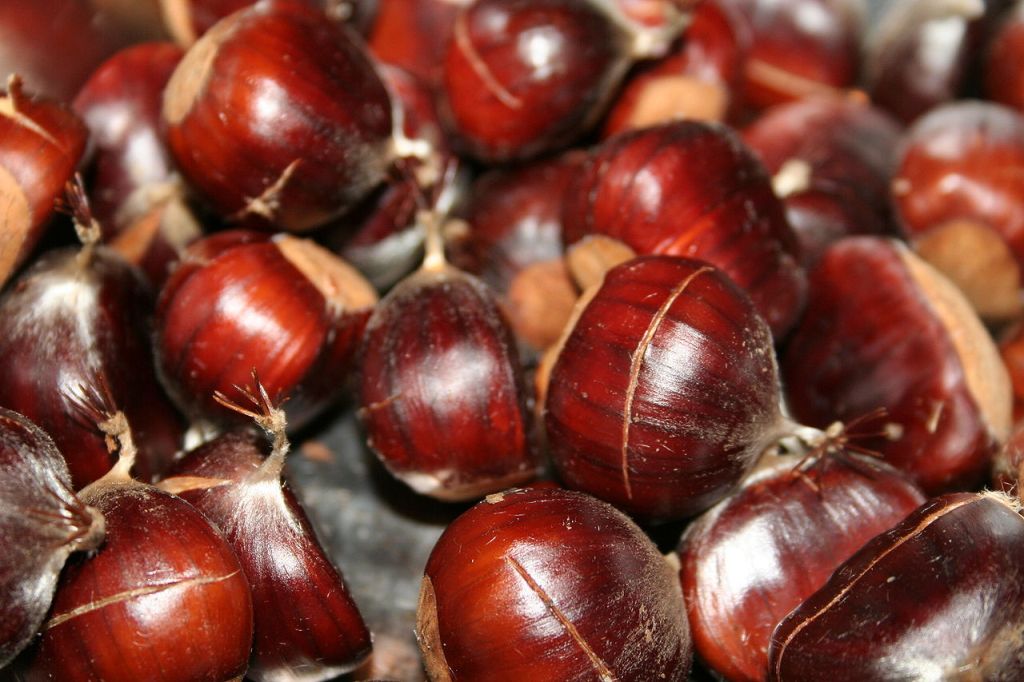
Sweet Chestnuts ready cut so they are easier to peel after boiling! (By bgran Wikipedia)
Castanea sativa, the sweet chestnut, Spanish chestnut or just chestnut, is a species of tree in the family Fagaceae, native to Southern Europe and Asia Minor, and widely cultivated throughout the temperate world. A substantial, long-lived deciduous tree, it produces an edible seed, the chestnut, which has been used in cooking since ancient times.
The species is widely cultivated for its edible seeds (also called nuts) and for its wood.
Sweet chestnut has been listed as one of the 38 substances used to prepare Bach flower remedies.
Bach Original Flower Remedies Sweet Chestnut is a natural flower remedy designed for those moments which happen to some people when the anguish is so great as to seem to be unendurable. When the mind or body feels worn out and exhausted as if it is going to give way.
The species’ large genetic diversity and different cultivars are exploited for uses such as flour, boiling, roasting, drying, and sweets. Chestnuts are traditionally roasted in their tough brown husks after removing the spiny cupules in which they grow on the tree. Once cooked, chestnuts acquire a sweet flavour and a floury texture similar to the sweet potato.
Roman soldiers were given chestnut porridge before going into battle.
Leaf infusions are used in respiratory diseases and are a popular remedy for whooping cough. A hair shampoo can be made from infusing leaves and fruit husks.
This tree responds very well to coppicing, which is still practised in Britain, and produces a good crop of tannin-rich wood every 12 to 30 years, depending on intended use and local growth rate. The tannin renders the young growing wood durable and weather resistant for outdoor use, thus suitable for posts, fencing or stakes. The wood is of light colour, hard and strong. It is used to make furniture, barrels (sometimes used to age balsamic vinegar) and roof beams, notably in southern Europe.
Day 8, Thursday 12th October (24 C at 14.30)
Weeded the violas in the valley this morning and was later picked up by Thomas & Esther in Thomas’s truck, but we walked from the neighbours home.
Had lunch with a nice green salad, leftover chestnuts, buckwheat and (Florence) fennel. Many healthy plants are growing on the terraces below as well as above the house.
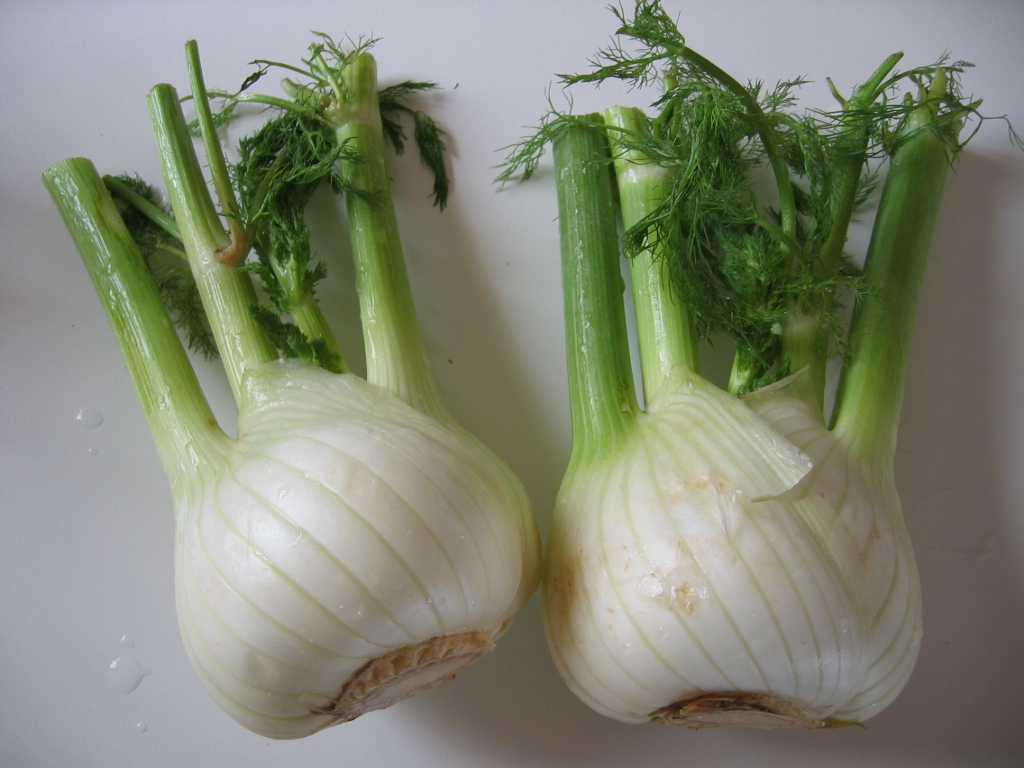
Florence fennel (picture by Arnaud 25 in Wikipedia)
Florence fennel or finocchio (Italian) is a selection with a swollen, bulb-like stem base that is used as a vegetable. It is of cultivated origin,and has a mild anise-like flavour but is sweeter and more aromatic.
The bulb is a crisp vegetable that can be sautéed, stewed, braised, grilled, or eaten raw. Tender young leaves are used for garnishes, as a salad, to add flavour to salads, to flavour sauces to be served with puddings, and in soups and fish sauce. Both the inflated leaf bases and the tender young shoots can be eaten like celery.
As a desert we had yoghurt with cornelian cherry fruit. Drank spelt coffee afterwards.
Esther lost her keys from her scooter! Fortunately they were was found!!
I did some weeding and cut the bank to the toilet with a sickle.
There is a nice Hawkweed growing and flowering on the bank which I thought might be Hieracium sylvaticum or Wall Hawkweed but later it was identified as H. racemosum aggr. (meaning it has lots of subspecies) by a member of INaturalist (see here) )
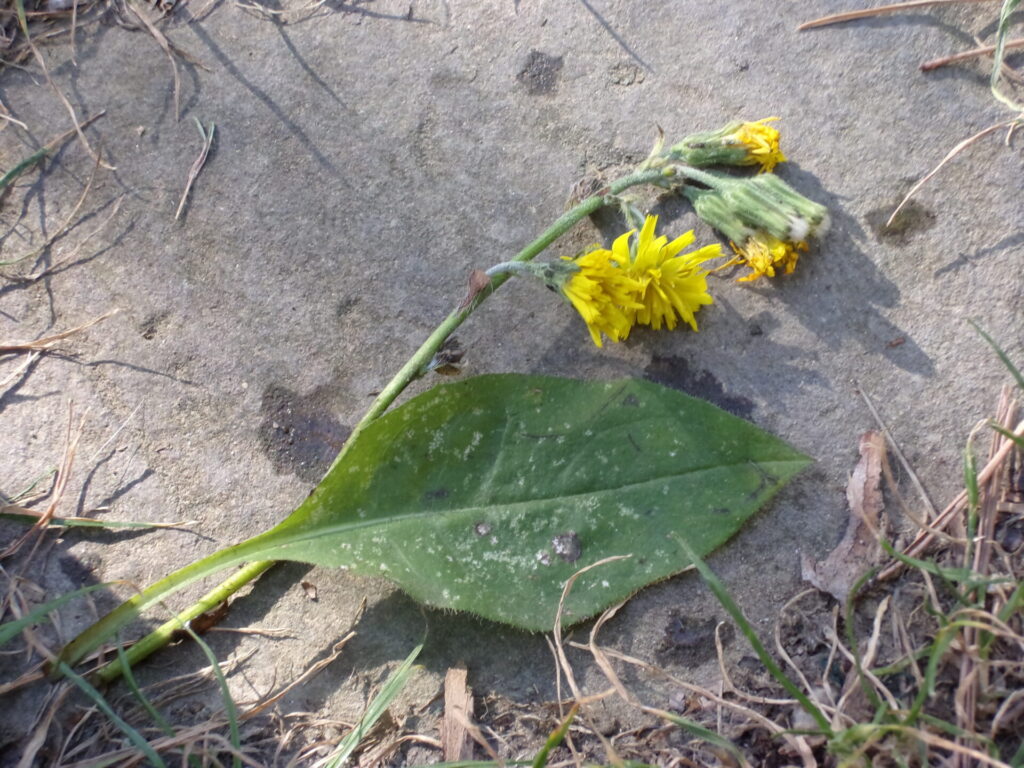
In the evening I did some watering of the cabbages below the house.
We had courgettes, carrots with parmesan, herbs and especially chives.
I watered the cabbages below the house as well as the pepperweed on the terrace below.
Day 9, Friday 13th October (20 C at 13.00)
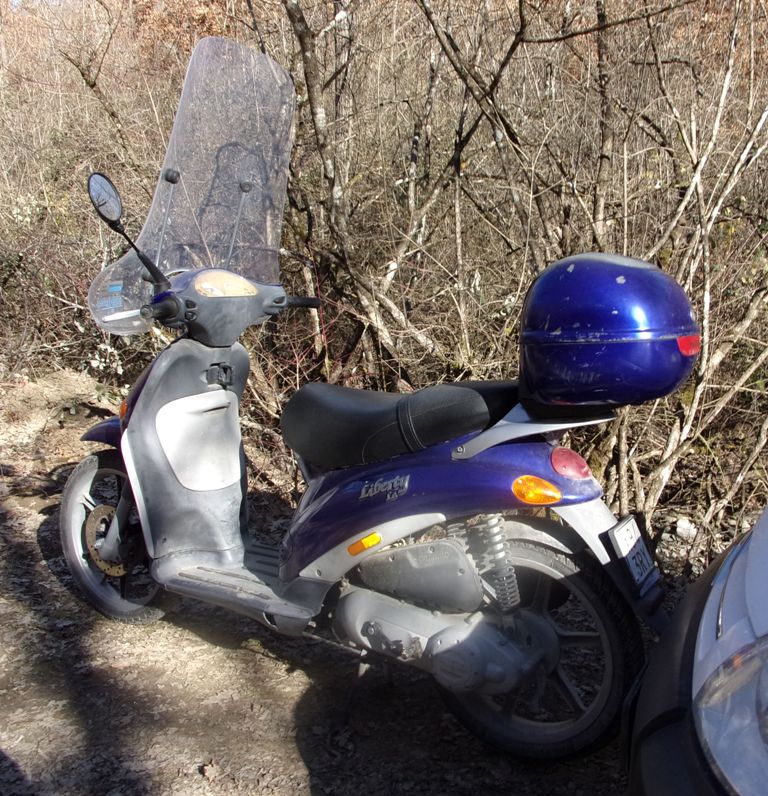
Walked to viola field in the valley this morning as Esther went to East on the scooter to feed him. Worked till 11.30 and went back behind Esther on her scooter!
We had a big lunch:
- A large salad with lettuce and rocket (rucola)
- Pumpkin (with beetroot ) soup + parsley and chives.
- Spaghetti + beans
- Fried courgette flowers
Rocket, eruca,or arugula (Eruca vesicaria) is an edible annual plant in the family Brassicaceae used as a leaf vegetable for its fresh, tart, bitter, and peppery flavour. E. vesicaria is widely popular as a salad vegetable and it is a species of Eruca native to the Mediterranean region.
We had an outing to Arezzo this afternoon in order to pick up the car from the garage. We walked to the recycling area and took a bus to Palazzo del Perro. The bus nearly drove past us!! In Palazzo we took a larger and busier bus to Arezzo. Got a drink (Orzo for me and Ice tea for Esther) at a cafe below the train station and we went on to COOP to do some shopping. Then: an Ice-cream!! I had 3 scoops: Chocolate, hazelnuts and pistachio.
Still 27 C in Arezzo at 6pm!
We went back to the garage and had a long wait from a customer before us and I took some pictures of 2 classic cars especially for my son, Albert!
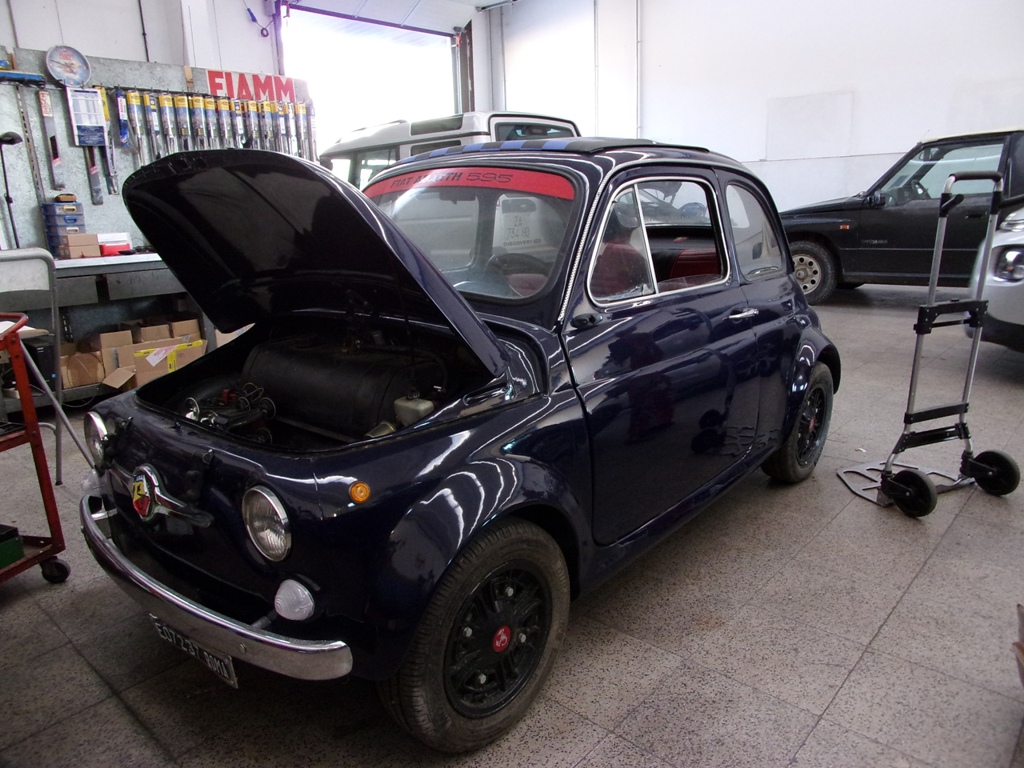
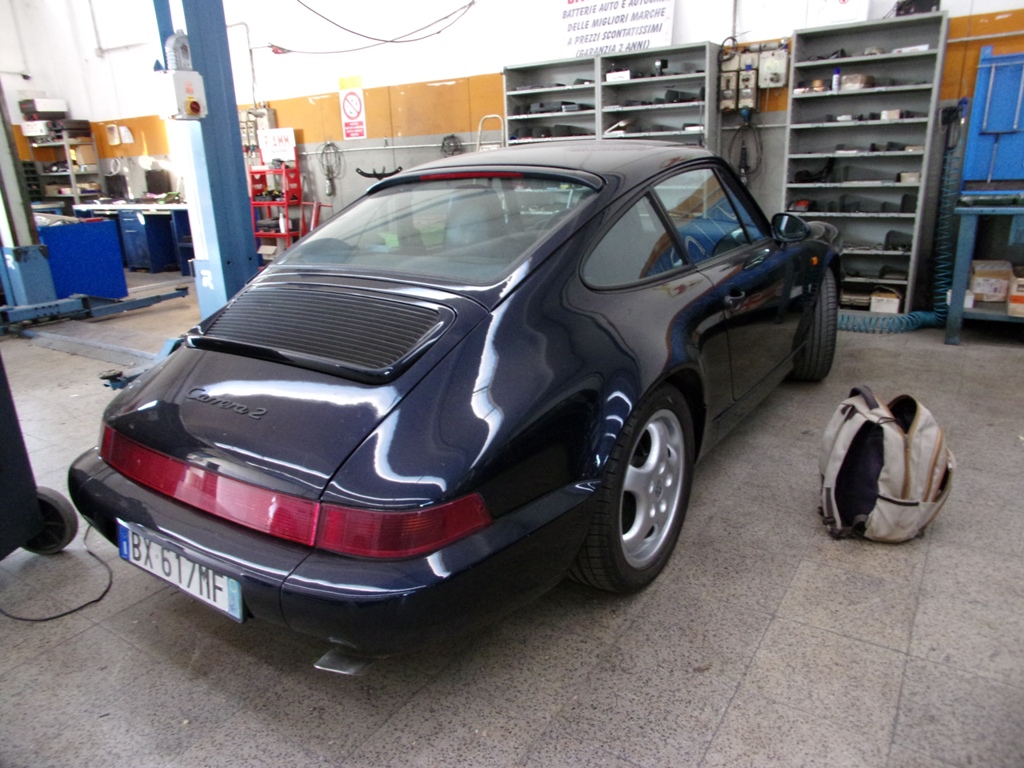
The garage couldn’t do anything and so we drove off, but then the car started to smell badly of burned oil. We managed to go to another garage where the owner is a good friend who found the car very low on oil! So he kindly filled it up for us and we drove back home, first fetching water for East by neighbours Lena and Angelo. I also fetched a bucket from the viola field for East’s food.
It was dark by the time we ascended to the house!
We had spaghetti with a tomato/courgette sauce + egg for our dinner.
Day 10, Saturday 14th October (22 C at 4pm)
Only got up at 6.45 and was just able to see Venus.
Made the usual porridge with apple but for 3 people this morning!
I had a bit of an easy day as we had a visitor, Carlo, friend of Thomas and Esther coming for lunch. One of the unusual dishes today was baked dandelion roots! Dandelion is very nutritious. See an earlier post of my ‘wonderfulweed’ here.
I tidied up around the fruit bushes below the toilet.
Here is maybe a good moment to mention some of the ‘weeds’ or wild flowers around Marroncello. Some of them took a bit of time to identify as they had no flowers or only the dry fruits after flowering. The first 3 plants below are all in the Lamiaceae or Deadnettle or Mint family.
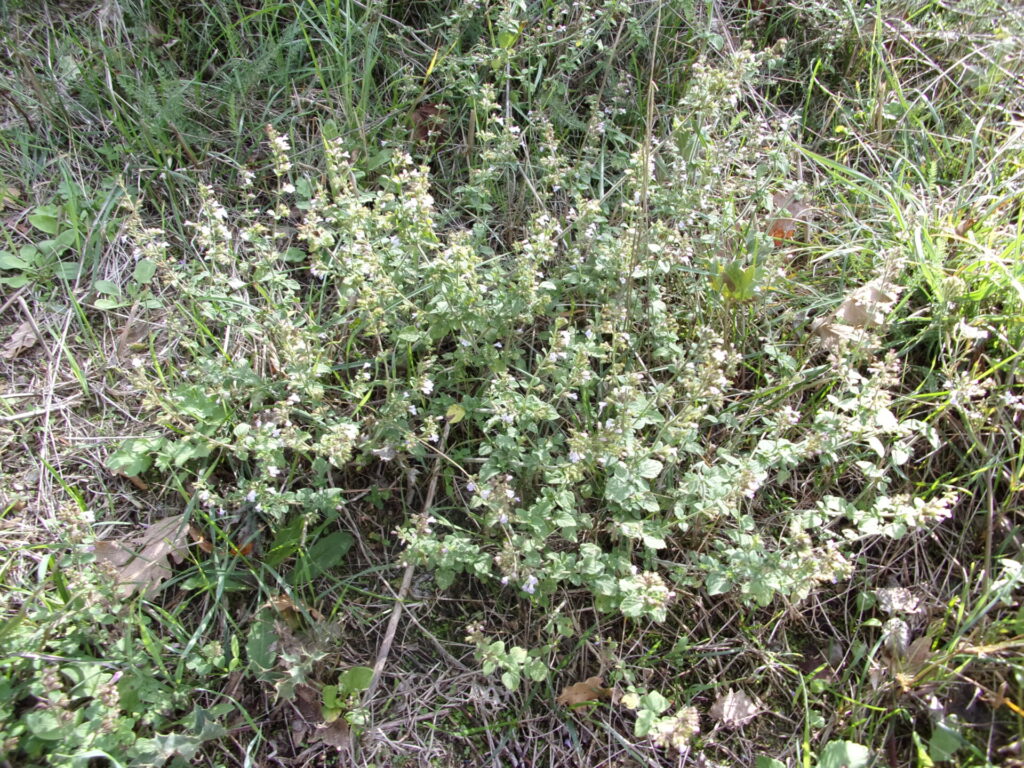
Lesser calamint is commonly used as an herb in the Italian and Corsican cuisine, where it is called nepita, mentuccia, nipitella or nepitella. In Rome, it is used in the preparation of the Carciofi alla Romana. In southern Italy, it is used in the making of a goat cheese called cassiedu, giving the cheese a minty taste.
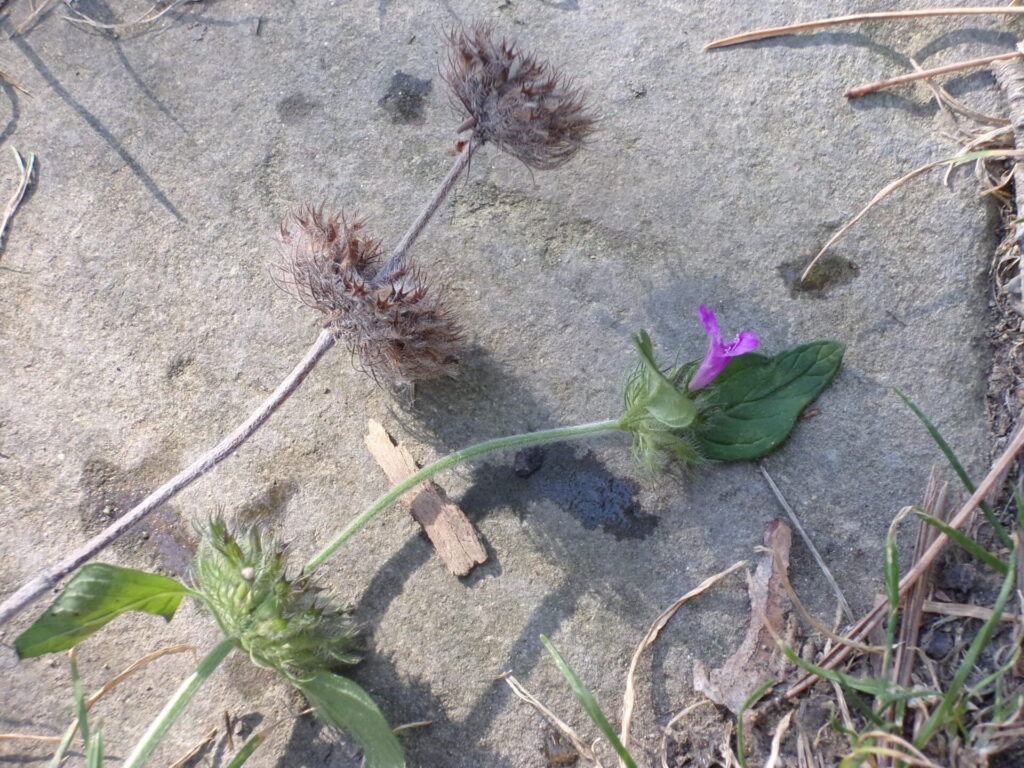
The leaves of Wild Basil are used as an aromatic herb in the preparation of food dishes and to make a herbal tea. They can also be used in the preparation of both a brown and a yellow dye.
This plant has traditionally been used as an astringent, a cardiac stimulant, an expectorant, to reduce flatulence and to increase perspiration. It has been used traditionally in Bulgaria for the healing of wounds and has been shown to have anti-bacterial properties.
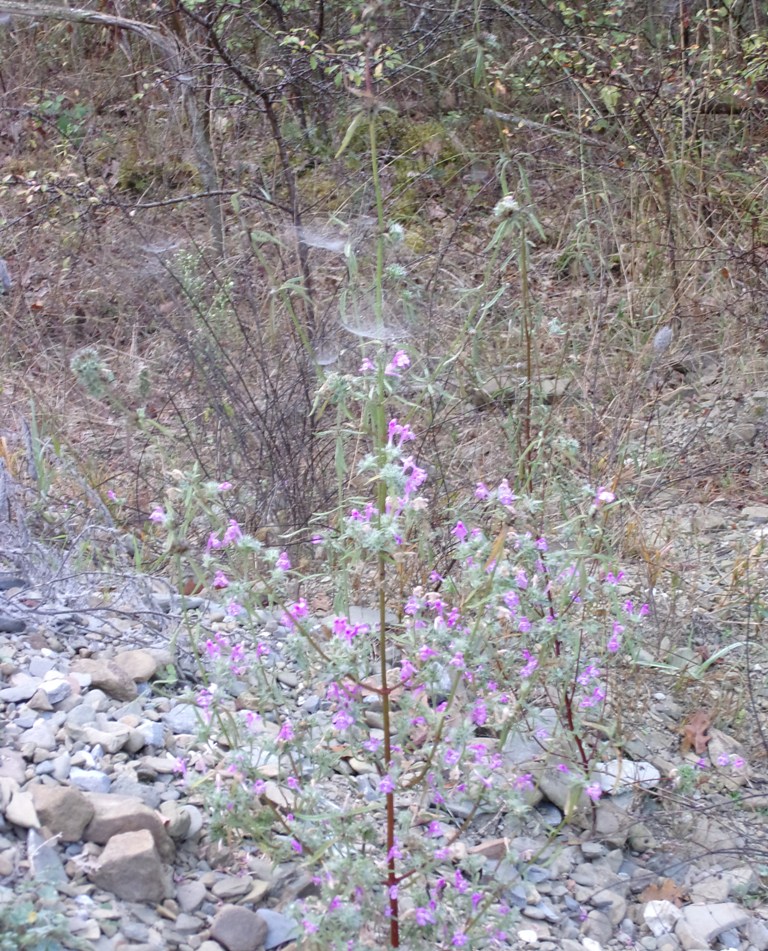
Thought this was a beautiful plant, managing to grow in very stony ground!
Galeopsis ladanum var. angustifolia, the Red hemp-nettle, is a European annual plant growing to 30 cm tall. It flowers between June and October on waste ground, railway tracks, and other stony places. It is classified as critically endangered, having declined dramatically in the last 60 years due to increased fertiliser and herbicide. Modern farming techniques such as autumn cultivation have also affected the plant because they are killed before they have set seed.
It is an archaeophyte in Britain and Ireland.
Day 11, Sunday 15th October (my brother Ber would have been 64 today..)
Sitting outside with a raised foot and swollen ankle!
I got up early and fed the cats + prepared breakfast. Then I went back to bedroom to fetch something and on my way back to the kitchen I missed the last step!
I did go to the church this morning being persuaded by Thomas who gave me a lift in the bucket of the tractor!
It was not such a good an idea, looking back as it felt like a long way down trying to stop my ankle from moving about and hurting on all the bumps in the road!
In the church it wasn’t easy either with the sitting and standing up and I would have been better off to have stayed at home… The journey up in the tractor bucket to the house was not as bad though, probably because it was slower!
When we arrived back Sila the cat seemed to have disappeared! Fortunately she was laying with Loekie in the stable below the house.
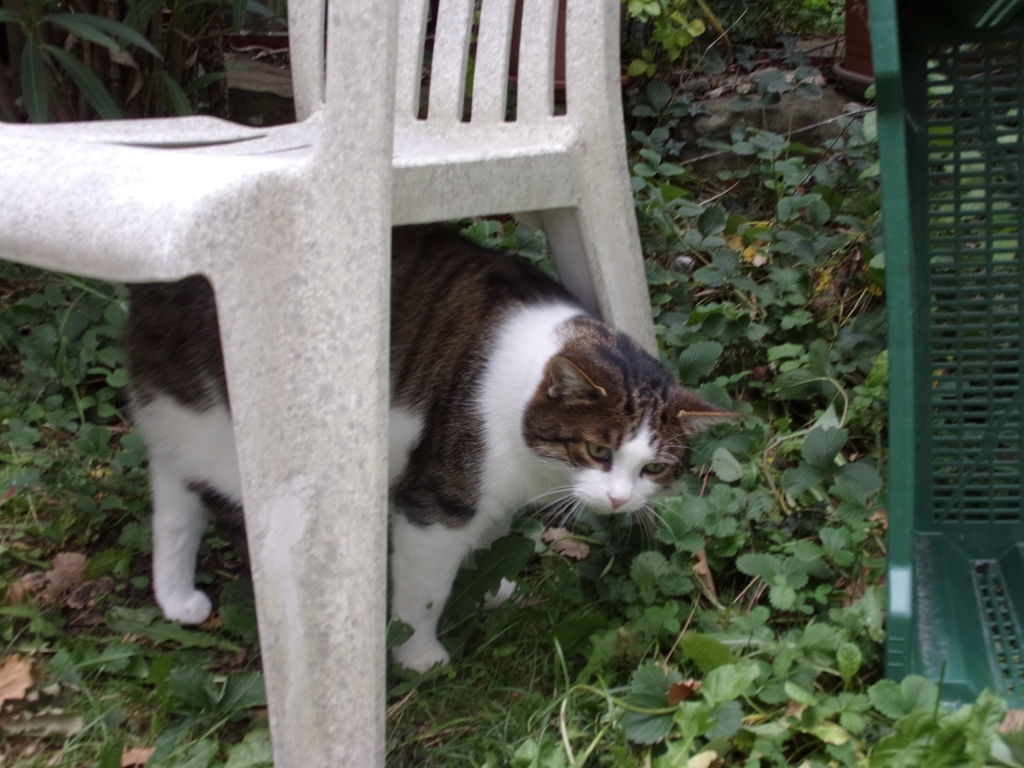
I had a calm Sunday afternoon, sitting outside, with my foot up, reading Hildegard’s book, etc.
We had a good lunch: salad, beans + buckwheat and we also had truffle today!
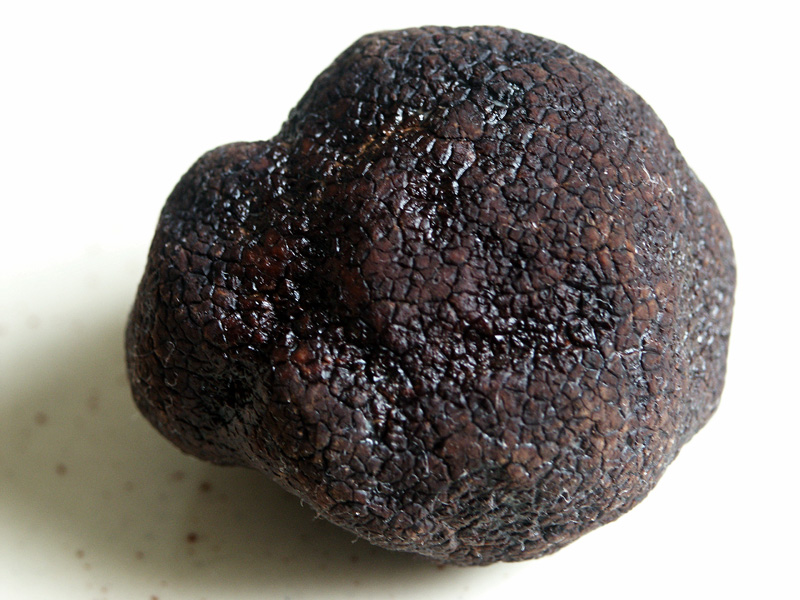
A truffle is the fruiting body of a subterranean ascomycete fungus, predominantly one of the many species of the genus Tuber. Truffles are ectomycorrhizal fungi, so they are usually found in close association with tree roots. Spore dispersal is accomplished through fungivores, animals that eat fungi. These fungi have significant ecological roles in nutrient cycling and drought tolerance.
Day 12, Monday 16th October (14C and cloud + sun!)
It had been a very windy night last night and it was cool when I got up this morning!
Now Loekie is sitting on my lap with his claws occasionaly digging into my legs! The little terror Sila is grabbing his tail, which is sticking outside, as everything is for playing with in her young life!
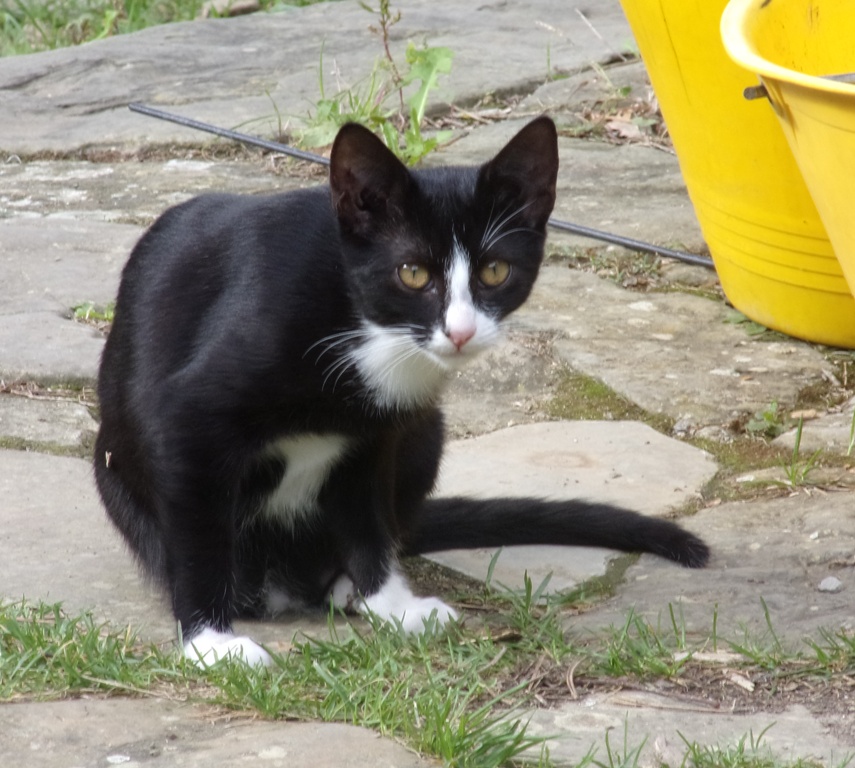
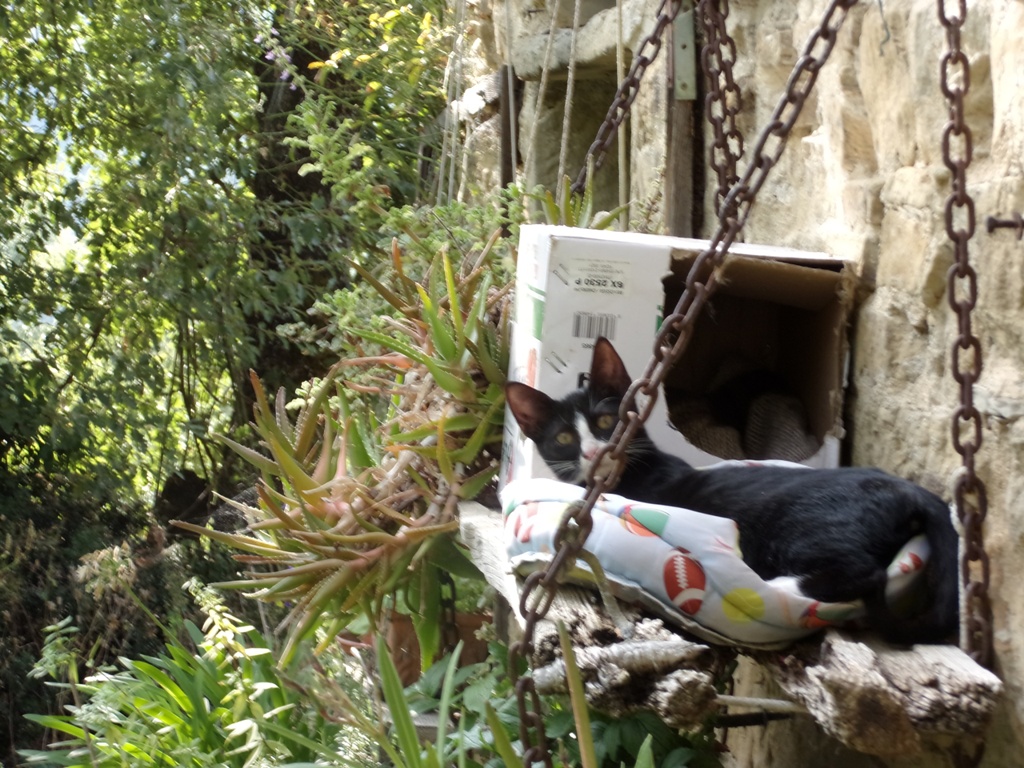
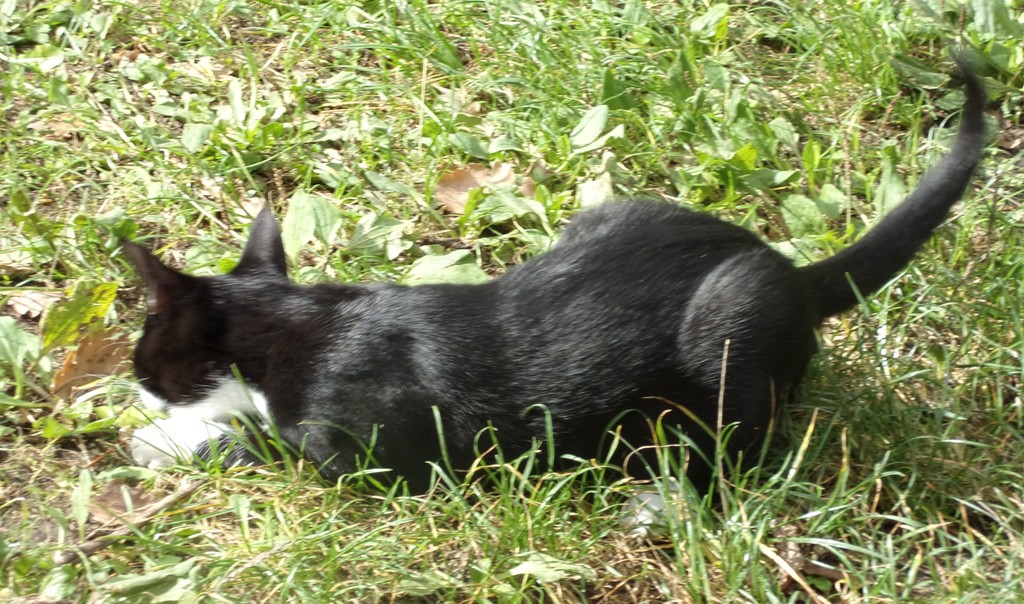
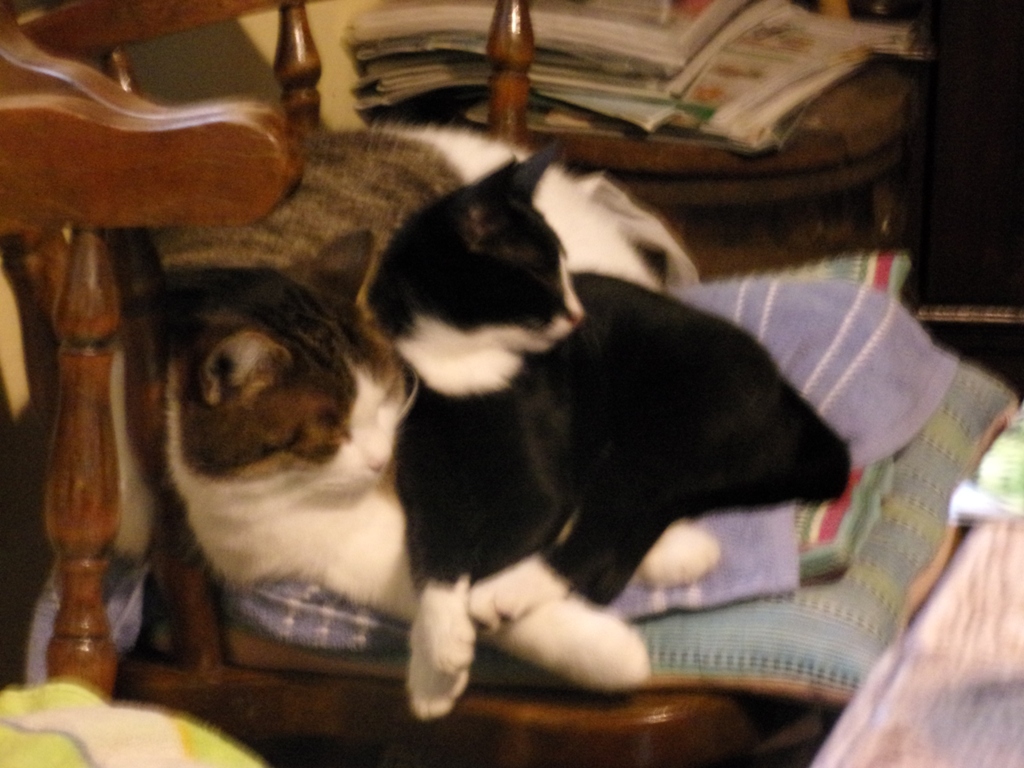
Fabrizio just came to ‘clock off’ as he had been starting to paint the metal roof on the stable below. Esther has gone to Arezzo to take in the car to hopefully get it repaired this time. She also hoped to get a lot of washing to the launderette!
I had a nice chat with Matt on the phone. He was going to visit his sister Esther and Ifor today. It was only 2C there and they are expecting heavy rain by Tuesday evening.
Here in Italy the rain has kept off for now and been ‘promised’ for perhaps Thursday. We do need it!!
I am sitting outside with my ankle raised onto 2 little crates and wrapped in a badger skin, which is supposed to help…
Little Sila is sitting on the cushion next to it but biting the skin so unfortunately she has to get off.
I am preparing a pumpkin soup for lunch with a pumpkin which friend Carlo has given and I am also cutting up courgette.
Esther got back at 13.45 and was very tired of walking a lot between the garage and launderette! We only had lunch at 14.30: Pumpkin soup to start with, pasta with courgette & parmesan and yoghurt with chocolate granola after!
I had a rest in my lovely bedroom for a few hours reading my book.
We had potatoes with carrots and (Florence) fennel for dinner and Thomas was back late having delivered 1000 kilo of spelt for milling today!
East had a late dinner too!!
Day 13, Tuesday 17th October (12C at 9.45)
I had a good night and heard the owls rather loud this morning.
I did the washing up after my porridge breakfast whilst Esther went back to the garage to collect the car as well as the washing which she had to leave behind yesterday.
I am resting with my foot up and trying to sketch some of the flowers from Marroncello:
Calamintha nepeta, Calamintha vulgare and Galeopsis angustifolia: see pictures on Day 10.
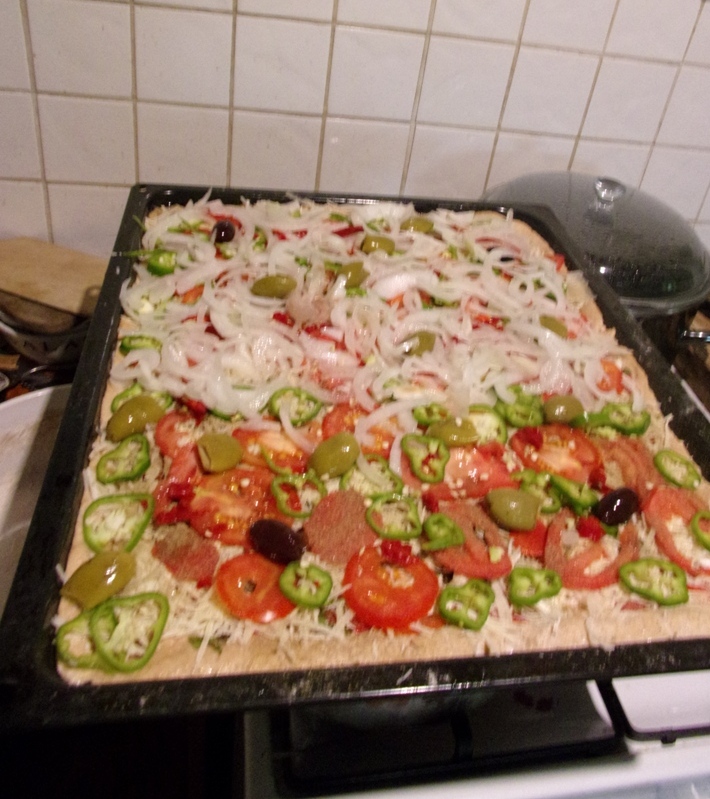
Today we had homemade Pizza!! One was made by Esther and the other by Thomas. The topping was with mozzarella, tomatoes, peppers and onions.
Thomas handed me 3 Flora books in order to find out some of the names of the wild plants I am finding here. Also was given 2 books on reptiles. It was a female Western Green Lizard or Lacerta bilineata.
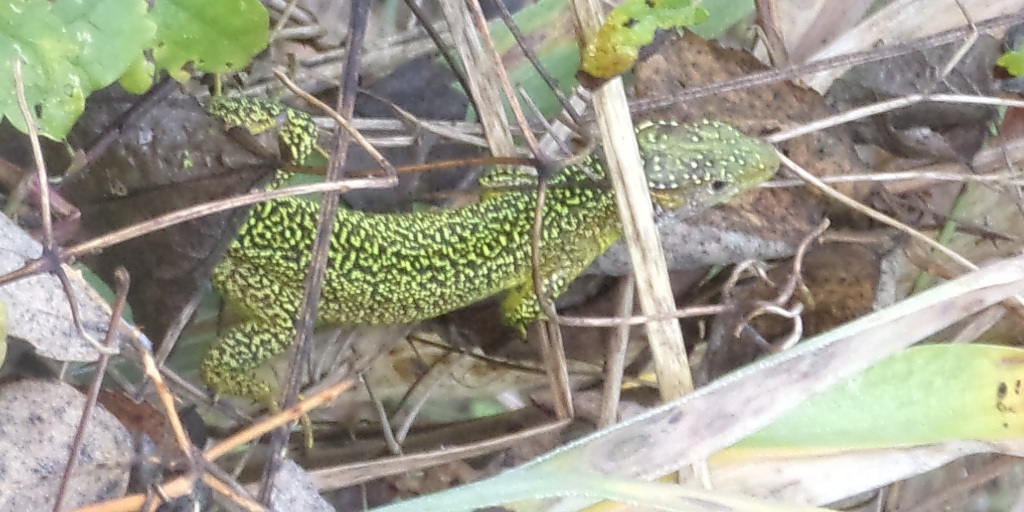
One name in the Flora for a plant/weed found in the viola terrace was: Aster bellidiastrum (later I found a better alternative with help of INaturalist) and grass Cynodon dactylon, which is being a nuisance here at Marroncello.
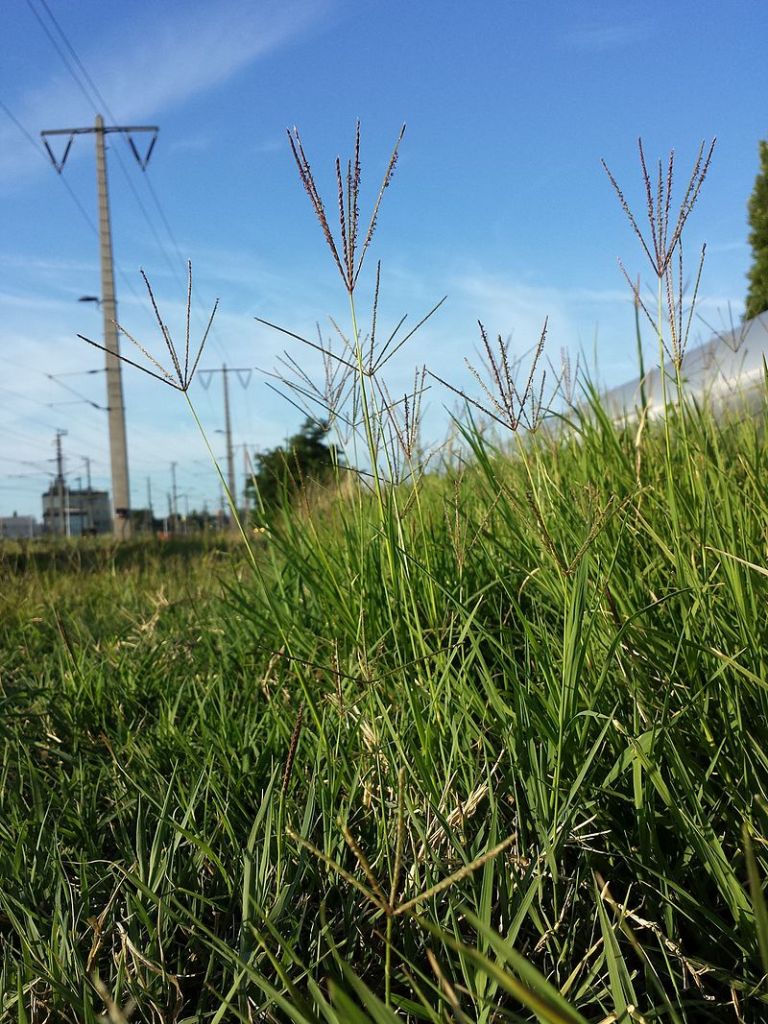
Cynodon dactylon, commonly known as Bermuda grass, is a grass found worldwide. It is native to Europe, Africa, Australia and much of Asia. It has been introduced to the Americas. Contrary to its common name, it is not native to Bermuda and is in fact an abundant invasive species there.
It has many good uses I found on Wikipedia: https://en.wikipedia.org/wiki/Cynodon_dactylon
Commonly known as “durva” or dūrvāyugma in India, this grass is used in the Ayurveda system of medicine and has many religious meanings in neighbouring countries.
It is fast-growing and tough, making it popular and useful for sports fields, as when damaged it will recover quickly. It is a highly desirable turf grass in warm temperate climates, particularly for those regions where its tolerance to heat and drought enable it to survive where few other grasses do. It has a relatively coarse-bladed form with numerous cultivars selected for different turf requirements.
Bermuda grass has been cultivated in saline soils in California’s Central Valley, which are too salt-damaged to support agricultural crops; it was successfully irrigated with saline water and used to graze cattle.
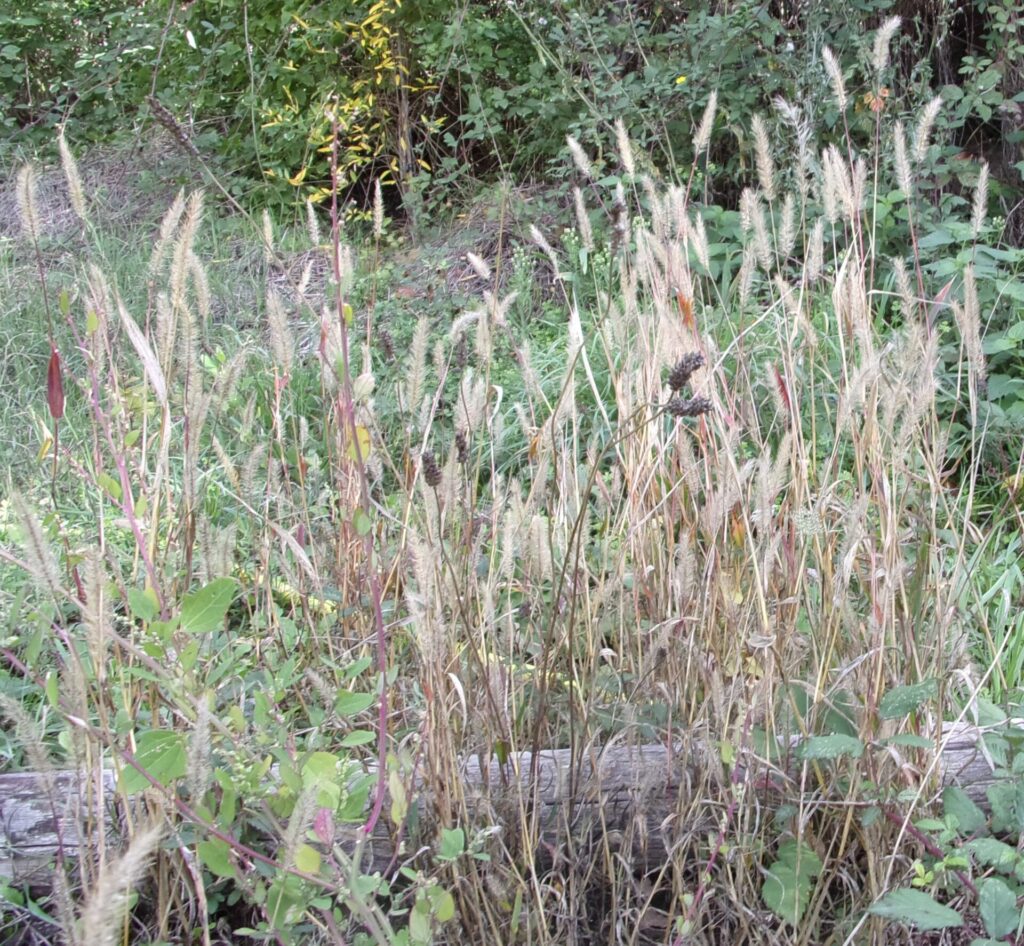
Another ‘weedy’ grass at Marroncello is Setaria spp. Difficult to identify without proper Flora but it may be Setaria viridis or Green Bristle-grass. It is native to Eurasia, but it is known on most continents as an introduced species and is closely related to Setaria faberi, a noxious weed. It is a hardy grass which grows in many types of urban, cultivated, and disturbed habitat, including vacant lots, sidewalks, railroads, lawns, and at the margins of fields. It is the wild antecedent of the crop foxtail millet. According to PFAF it has:-
Edibele Uses: Seeds are used in the same ways as rice or millet, either boiled, roasted or ground into a flour. The seed (roasted?) is said to be a coffee substitute.
Medicinal Uses: The seed is diuretic, emollient, febrifuge, refrigerant and a tonic. The plant is crushed and mixed with water then used as an external application in the treatment of bruises.
After lunch we made lavender bags in the kitchen. It was very pleasant as much cooler there than outside. We made 42.
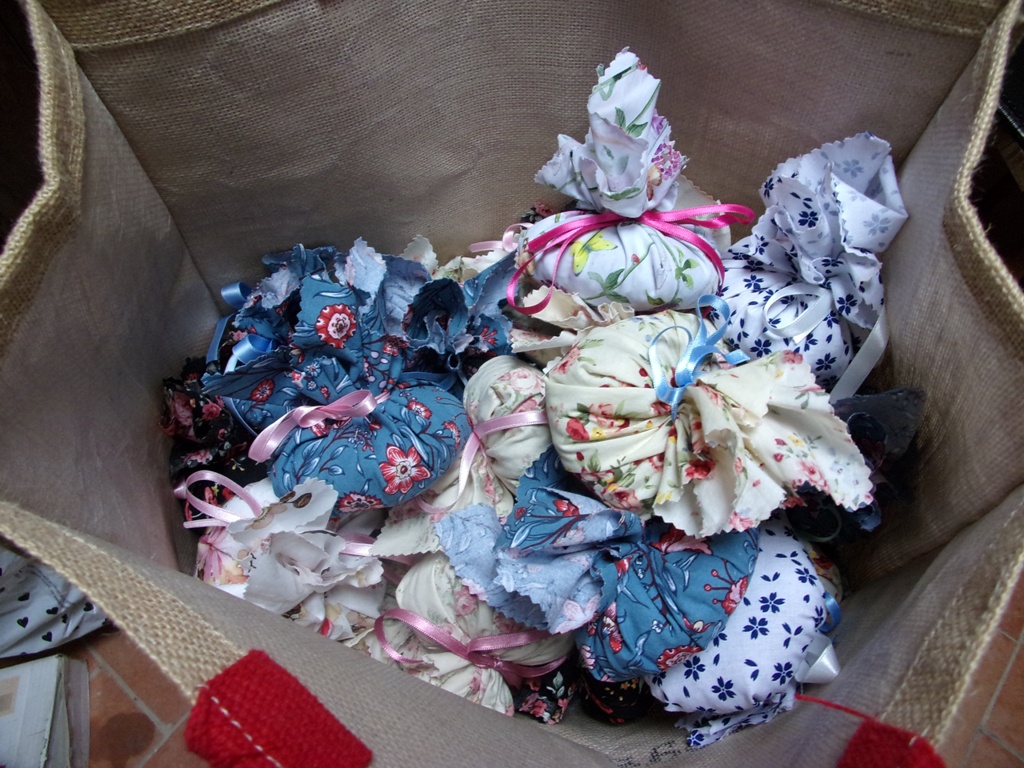
The evening meal was: potatoes with courgette and crème fraiche, pizza and courgette flowers.
Esther and I played Rummikub: 1-1
I put St John’s wort oil on my ankle + the usual bandage.
At Marroncello much St John’s wort is harvested in the nearby mountains above Arezzo.
Some of this is dried to be processed on its own or in a mix as an antidepressive to be used in winter.
Most of the flowering stems are steeped in olive oil near the potato terrace above the house. Here it stays for 6 weeks before it is sieved and decanted into large metal bottles.
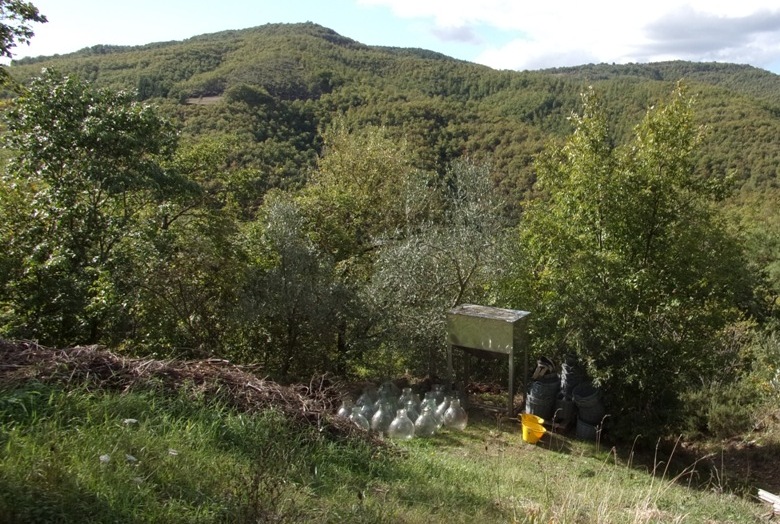
St. John’s wort (Hypericum perforatum) has been intensively investigated for its antidepressive activity, but dermatological applications also have a long tradition.
Topical St. John’s wort preparations such as oils or tinctures are used for the treatment of minor wounds and burns, sunburns, abrasions, bruises, contusions, ulcers, myalgia, and many others. Pharmacological research supports the use in these fields. Of the constituents, naphthodianthrones (e.g., hypericin) and phloroglucinols (e.g., hyperforin) have interesting pharmacological profiles, including antioxidant, anti-inflammatory, anticancer, and antimicrobial activities. In addition, hyperforin stimulates growth and differentiation of keratinocytes, and hypericin is a photosensitizer which can be used for selective treatment of nonmelanoma skin cancer.
Also see here for more information about St John’s wort.
Day 14, Wednesday 18th October (15 C and rain today!)
Esther had already made porridge this morning when I got up.
Rita came this morning at 7.45 to treat my ankle with a traditional remedy she had learnt from her mother!
It is basically covering the ankle in beaten egg white and covering it in a bandage. This will go solid as plaster and needs to stay there for 3 days.
This is what I found here: https://www.earthclinic.com/cures/sprains-editors-choice.html
‘While living in Peru, I sprained my ankle. Sweet little ladies took me to their home, whipped up some egg whites and slathered the “merengue” all over my ankle and wrapped it in a paper towel. (They actually made the “paper towel” by rubbing paper between their hands until it was soft, and then pricking it with a fork). As the white prickled and popped like rice crispies, the swelling went down. Finally, when the paper was touching my skin, the swelling had gone down completely. I’m not sure about the salt, it most likely was in the whipped whites, but I can attest that this egg white remedy works wonders.’
After my treatment Esther went to the top field to do some weeding amongst the Wormwood with Rita and Fabrizio.
I did the washing up and peeled a lot of Sweet Chestnuts this morning.
For lunch we had spaghetti with nettles + tomato sauce and 3 boiled eggs + the 4 egg yolks which were left from my egg white treatment!
After lunch E & T went to the funeral of a former neighbour. There was a heavy rain shower for over an hour or so.
Made more lavender bags: 25 + 3 for Esther and 1 for myself
We had ‘marrone’ this evening or Sweet Chestnuts
There was a beautiful sickle moon in the evening and a fat spider with lots of babies near the kitchen door!
Day 15, Thursday 19th October (15 C and a bit of sun as well as rain)
Got up at half past 6 but we both woke up from a thunder bolt and flash at midnight. No more rain though I think…Cracked many almonds and about 40 hazelnuts which were given to T & E by friends near Arezzo.
For lunch we had soup with broccoli, parsnip and sweet chestnuts. After this rice with (Florence) fennel and fish + lots of parsley which grows in the terrace below the house. Hot chocolate and a kaki fruit to finish up with.
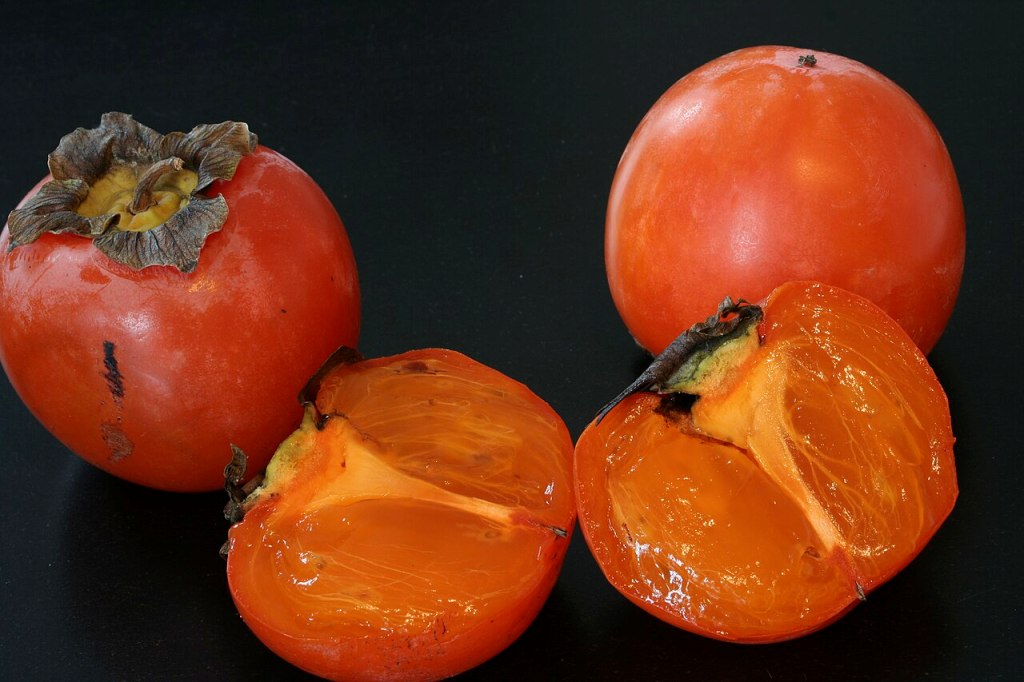
Picture of mature Kaki (by Haneburger in Wikipedia)
Kaki or Persimmon (Diospyros kaki) dThis is the edible fruit of a number of species of trees in the genus Diospyros. This is in the family Ebenaceae, and a number of non-persimmon species of the genus are grown for ebony timber.
We spread some organic fertilizer on the Pepperwort to give it a bit of a boost after the very dry summer and I also put some around the violas on the terrace next to the toilet.
The evening meal was leftover rice with leaf beet and meat.
Day 16, Friday 20th October (22 C and a very stormy night!)
I got up before 7 but Esther had left already to Arezzo. She phoned at 8.30 to let me know to give Rita the empty egg boxes back!
I collected the berries of Laurus nobilis or Bay today. There is a large tree behind the house.
I removed all the little stems of the berries later and Thomas took them to Germany this evening for processing.
At ‘Wurdies’ the leaves are sold on their own as a food condiment or they go into Chai tea mixes.
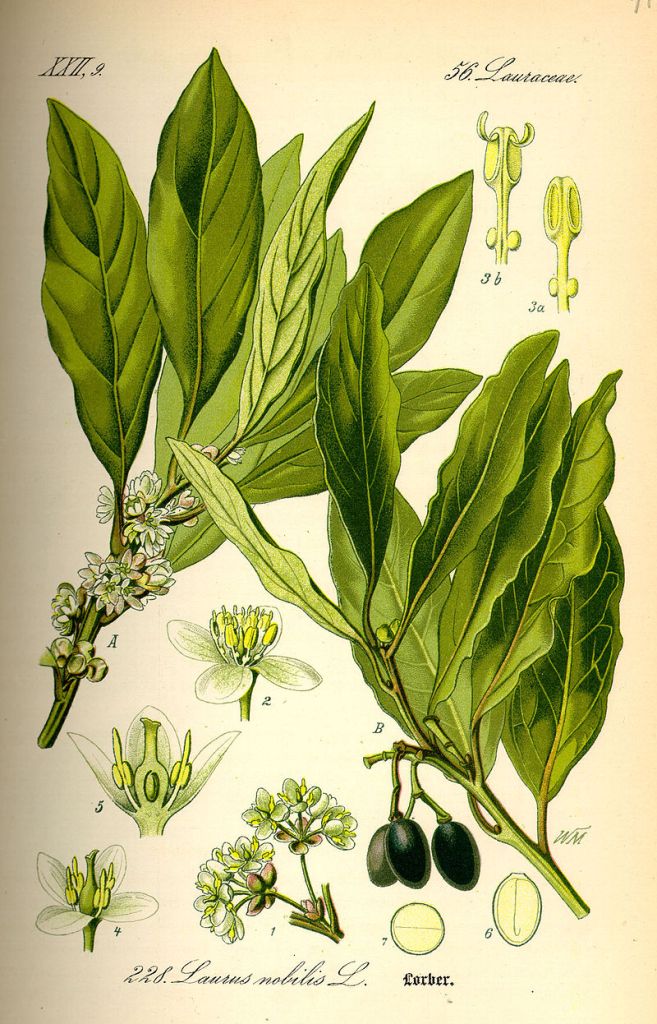
Illustration of Bay: (by Otto Wilhelm Thomé – Flora von Deutschland, Österreich und der Schweiz – www.biolib.de, Public Domain)
Laurus nobilis is an aromatic evergreen tree or large shrub with green, glabrous (smooth) leaves. It is in the flowering plant family Lauraceae. It is native to the Mediterranean region and is used as bay leaf for seasoning in cooking. Its common names include bay tree, bay laurel, sweet bay, true laurel, Grecian laurel or simply laurel.
The plant is used in a wide variety of recipes, particularly among Mediterranean cuisines. Most commonly, the aromatic leaves are added whole to Italian pasta sauces. They are typically removed from dishes before serving, unless used as a simple garnish. Whole bay leaves have a long shelf life of about one year, under normal temperature and humidity. Whole bay leaves are used almost exclusively as flavour agents during the food preparation stage.
Ground bay leaves, however, can be ingested safely and are often used in soups and stocks, as well as being a common addition to a Bloody Mary.
A Bloody Mary is a cocktail containing vodka, tomato juice, and other spices and flavourings including Worcestershire sauce, hot sauces, garlic, herbs, horseradish, celery, olives, pickled vegetables, salt, black pepper, lemon juice, lime juice and celery salt.
Dried laurel berries and pressed leaf oil can both be used as robust spices, and the wood can be burnt for strong smoke flavouring.
In herbal medicine, aqueous extracts of bay laurel have been used as an astringent and salve for open wounds. It is also used in massage therapy and aromatherapy. A folk remedy for rashes caused by poison ivy, poison oak, and stinging nettle is a poultice soaked in boiled bay leaves.The Roman naturalist Pliny the Elder listed a variety of conditions which laurel oil was supposed to treat: paralysis, spasms, sciatica, bruises, headaches, catarrhs, ear infections, and rheumatism.
Once Esther was back she made Pizza and we had lunch quite late.
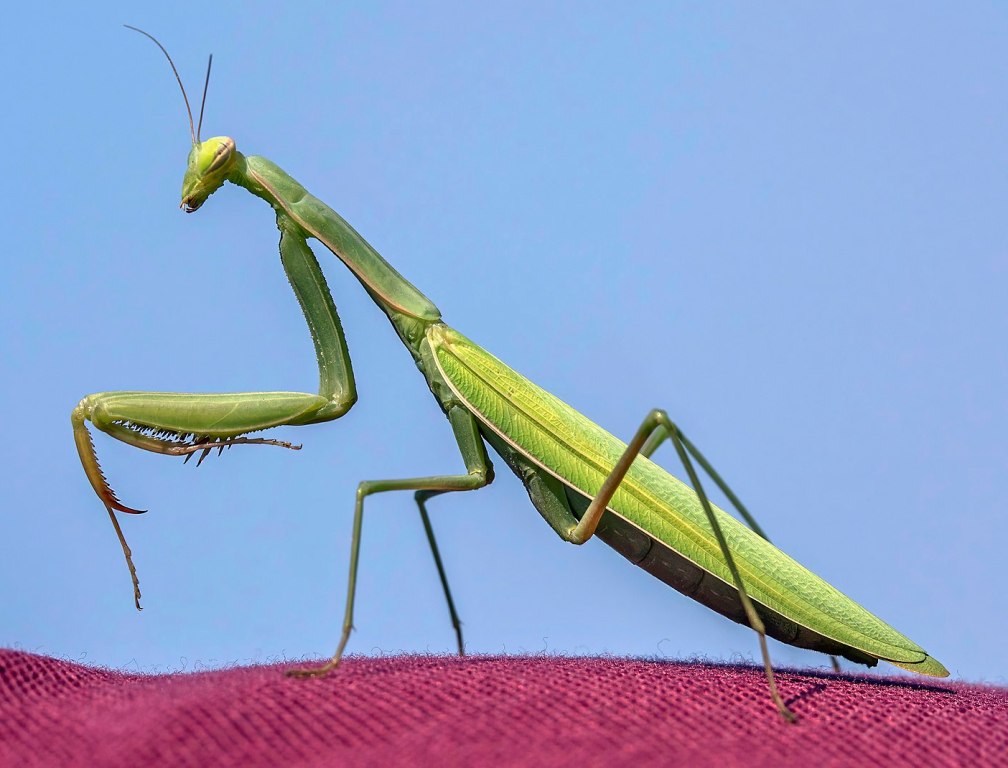
I saw an extrordinary insect today; Esther said it was a ‘Bid-Sprinkhaan’ or Praying Mantis in English.
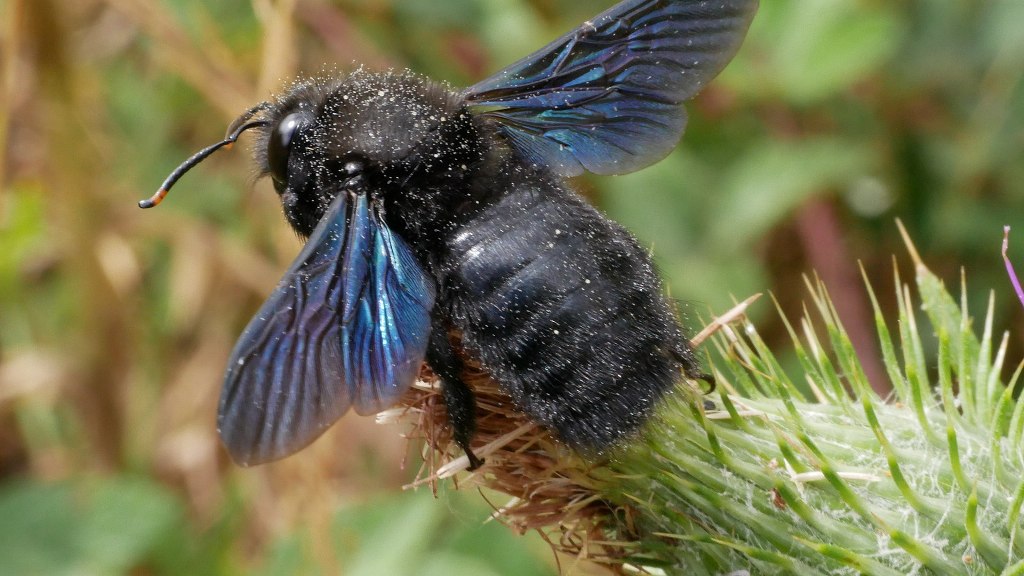
As the sun was out, I also saw one Violet Carpenter Bee (Xylocopa violacea) again as I saw several back in February, mainly on the Sarcococca flowers then.
Thomas was loading his van up with the tractor in the afternoon and left to Germany after dinner this evening.
Day 17, Saturday 21st October (15 C at 9 am and lots of rain in the night!)
I’ve been tidying behind the house this morning whilst Esther went to Arezzo market.
It warmed up nicely when the sun came through. Esther came back from market and we had lunch with a tomato salad, leftover spaghetti + leaf beet, pizza and yogurt + melon after.
Sat outside for a little while but we had some thunder and it was raining from about 2 pm so we spend quite a few hours indoors. Esther fortunately stayed dry whilst going to feed East later. On the way back up she said that the little stream in the valley had started to ‘run’ again after having been dry for many weeks!
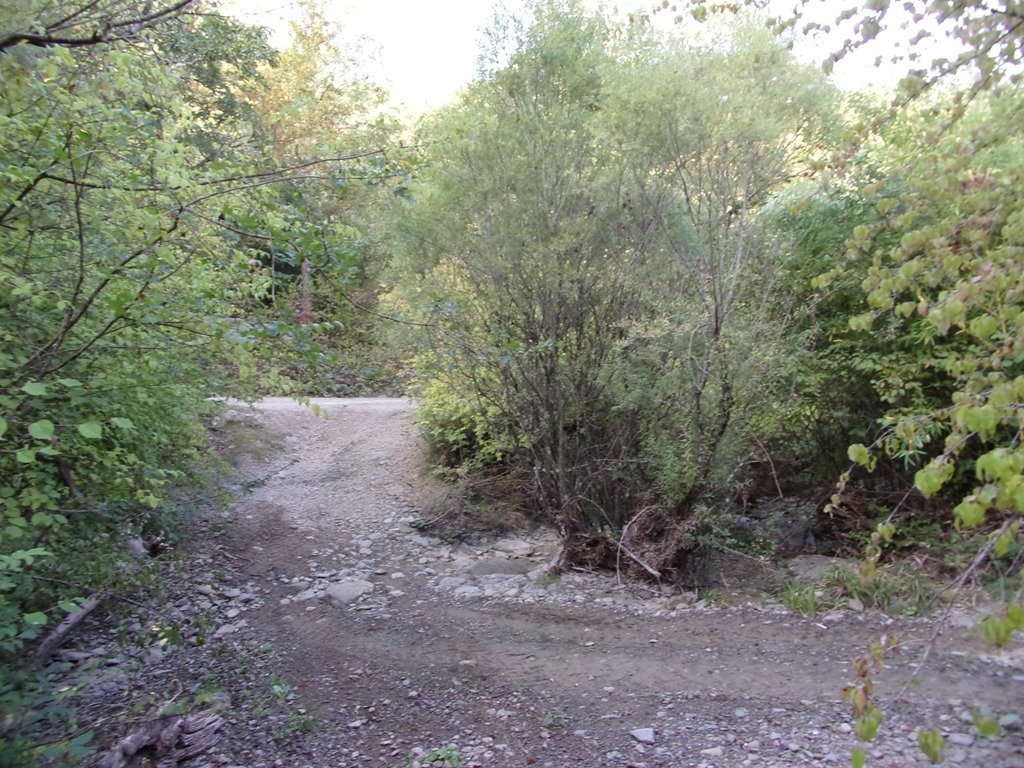
In the evening we had potato with Florence fennel and a banana yoghurt after!.
Played Rummikub: 2-1 for Esther….
Beautiful sickle moon in the evening and stars.
Day 18, Sunday 22nd October (only 10 C in valley this morning, 16 C at 2 pm and sun with cloud.
For the first time I walked down the hill this morning; one week after my fall…
We went to mass in the Church of ‘Sant`Agata alle terrine’ a bit earlier before it started at half past 9 as we were picking up an elderly lady on the way there. As we were still too early we also quickly visited the church yard next to it as she doesn’t often get the chance to go here.
It was ok for me to walk but standing in the church was surprisingly tiresome.
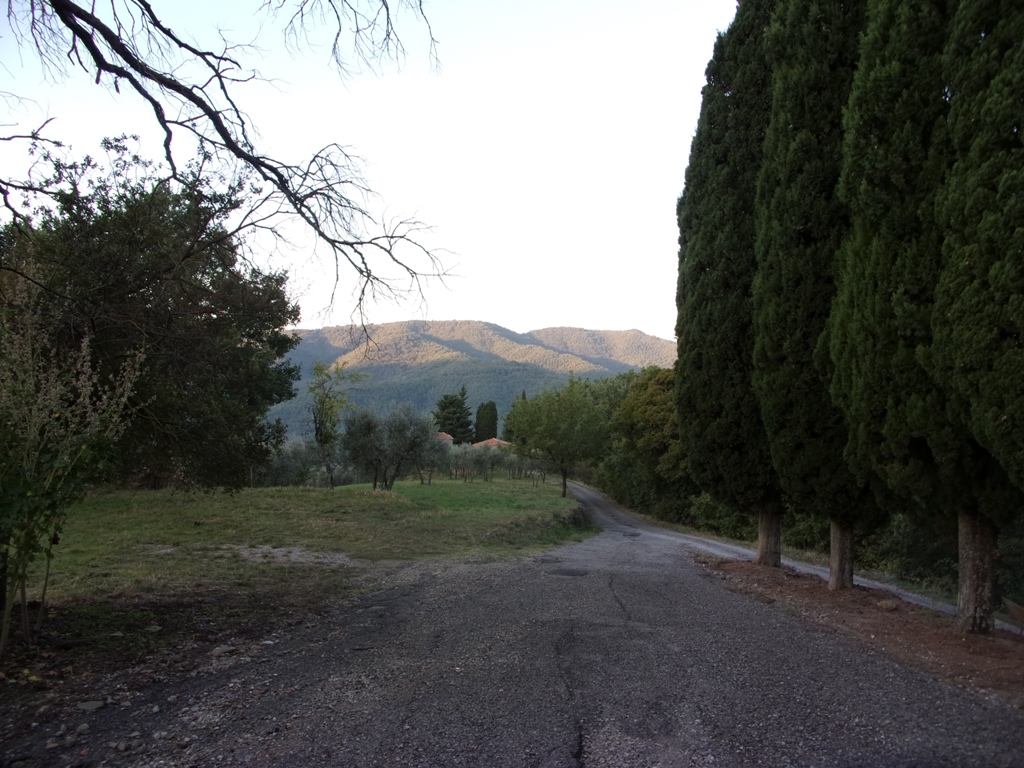
As the Church is high up the track you can have nice views outside and there are many olive trees growing in the fields around.
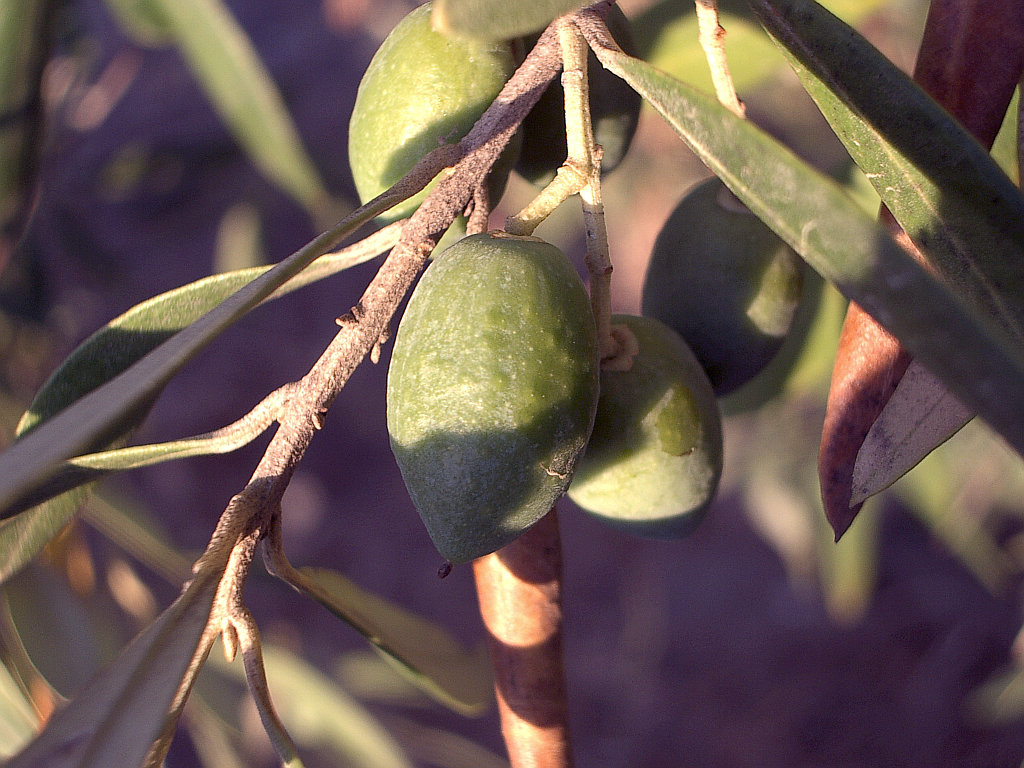
Ripening Olive fruit (by Rodrigo Nuno Bragança da Cunha – Wikipedia Commons)
The Olive, botanical name Olea europaea, meaning ‘European olive’, is a species of small tree or shrub in the family Oleaceae, found traditionally in the Mediterranean Basin. The tree and its fruit give their name to the Oleaceae plant family, which also includes species such as lilac, jasmine, forsythia, and the true ash tree.
For thousands of years olives were grown primarily for lamp oil, with little regard for culinary flavour. Its origin can be traced to the Levant based on written tablets, olive pits, and wood fragments found in ancient tombs. As far back as 3000 BC, olives were grown commercially in Crete and may have been the source of the wealth of the Minoan civilization.
The olive tree, Olea europaea, has been cultivated for olive oil, fine wood, olive leaf, ornamental reasons, and the olive fruit. About 80% of all harvested olives are turned into oil, while about 20% are used as table olives. The olive is one of the “trinity” or “triad” of basic ingredients in Mediterranean cuisine, the other two being wheat for bread, pasta, and couscous; and the grape for wine.
Another very typical Tuscan tree is the Cupressus sempervirens ‘Stricta’ or Tuscan Cypress.
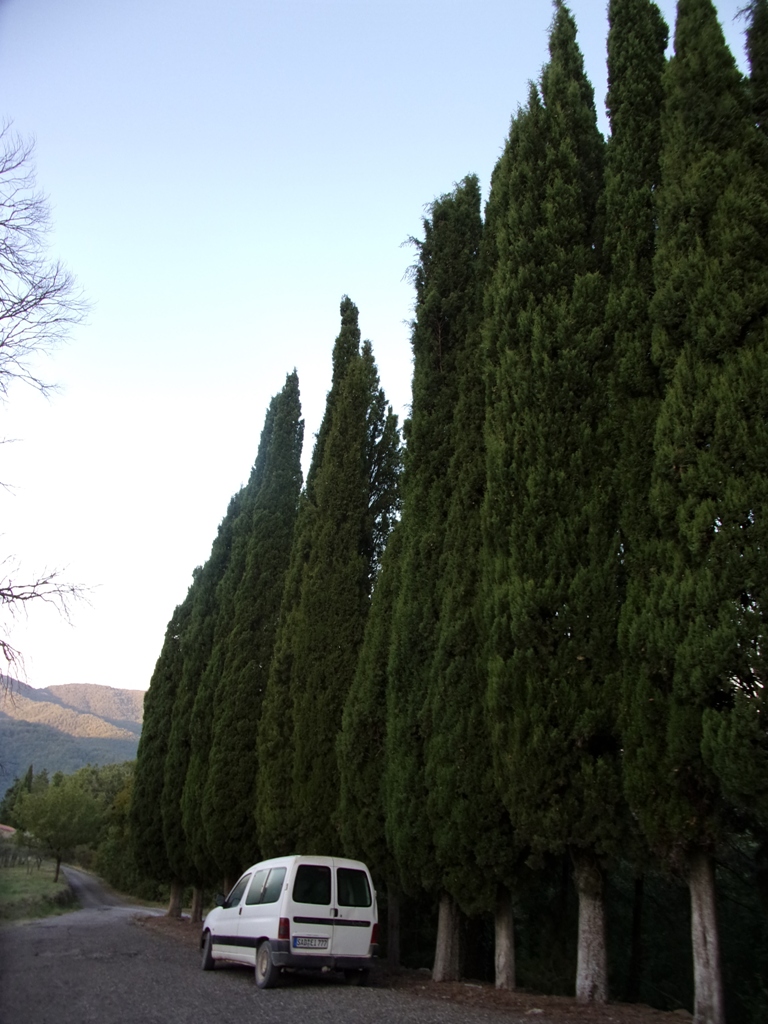
Cupressus sempervirens, the Mediterranean cypress (other names are Italian cypress,Tuscan cypress, Persian cypress, or pencil pine), is a species of cypress native to the eastern Mediterranean region and Iran. Formerly, the species was sometimes separated into two varieties, the wild C. sempervirens var. sempervirens (syn. var. horizontalis), and the fastigiate C. s. var. pyramidalis (syn. var. fastigiata, var. stricta), but the latter is now only distinguished as a Cultivar Group, with no botanical significance.
C. sempervirens finds a litany of uses including as wood, in traditional medicine, and for other therapeutic purposes. The wood is insect-repellent; hence its use in furniture – i.e. for pantry cabinets – while the cypress’s oil is marketed as massage liniment.
The dry seeds that come from the Cupressus sempervirens are able to help people reduce their skin conditions like acne or help heal any cuts or scrapes that a person may have. The oil that come from the leaves of the plant can help cure people from any minor infections that might have, like nose congestion for example. It can also prevent damage to land that are caused by violent weather.
It is also known for its very durable, scented wood, used most famously for the doors of St. Peter’s Basilica in the Vatican City, Rome. Cypress used to be used in distilleries as staves to hold mash ferments to make alcohol before the invention of stainless steel.
In cosmetics it is used as astringent, firming, anti-seborrheic, anti-dandruff, anti-aging and as fragrance. It is also the traditional wood used for Italian harpsichords.
We gave the lady a lift back as well but didn’t stop for a hot drink as Esther was expecting friends to come for lunch that day. Unfortunately the friend phoned that she wasn’t feeling fit enough to come over as she had been suffering from a very bad back!
Picked some beans and small tomatoes at the ‘shower’ terrace and prepared them for our lunch whilst sitting outside. Sila decided it was fun to grasp the beans out of my dish and play with them!
For lunch we had:
- Tomato salad
- Pumpkin soup with lots of parsley
- Polenta with beans and tomato sauce.
- A Pomegranate https://en.wikipedia.org/wiki/Pomegranate which we ate outside when the sun came again.
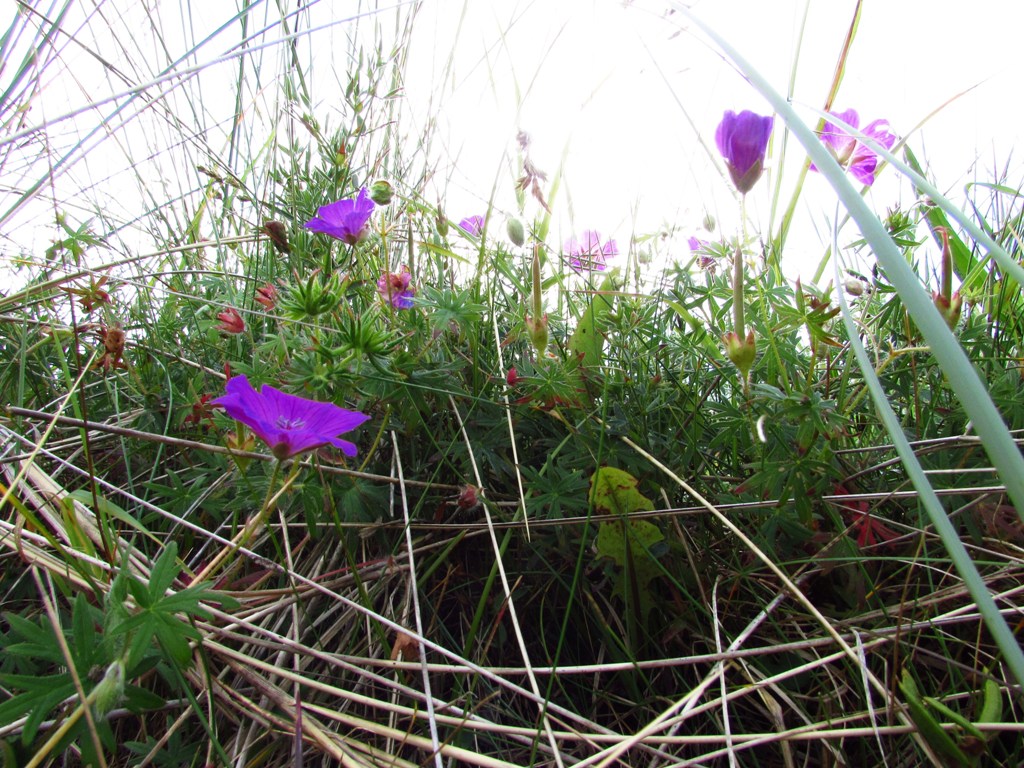
I did a bit of weeding around the house whilst Esther went weeding in the Geranium patch behind the house.
Geranium sanguineum or Bloody Crane’s-bill, is a species of hardy flowering herbaceous perennial plant in the cranesbill family Geraniaceae. The typical habitat of this species is grassland, sand dunes and open woodland on calcareous soils, including rocky slopes. It is native to Europe and temperate Asia.
It is cultivated as a garden subject, and a number of different cultivars exist.
At Marroncello it is grown as a crop and the leaves are harvested and dried for an anti-flu remedy.
Later that afternoon Esther went to feed East and was alarmed that hunters were shooting above his field. They were trying to drive the wild boar down the hill and into the field where a gunman was waiting, very close to East!
Fortunately nothing bad happened in the end.
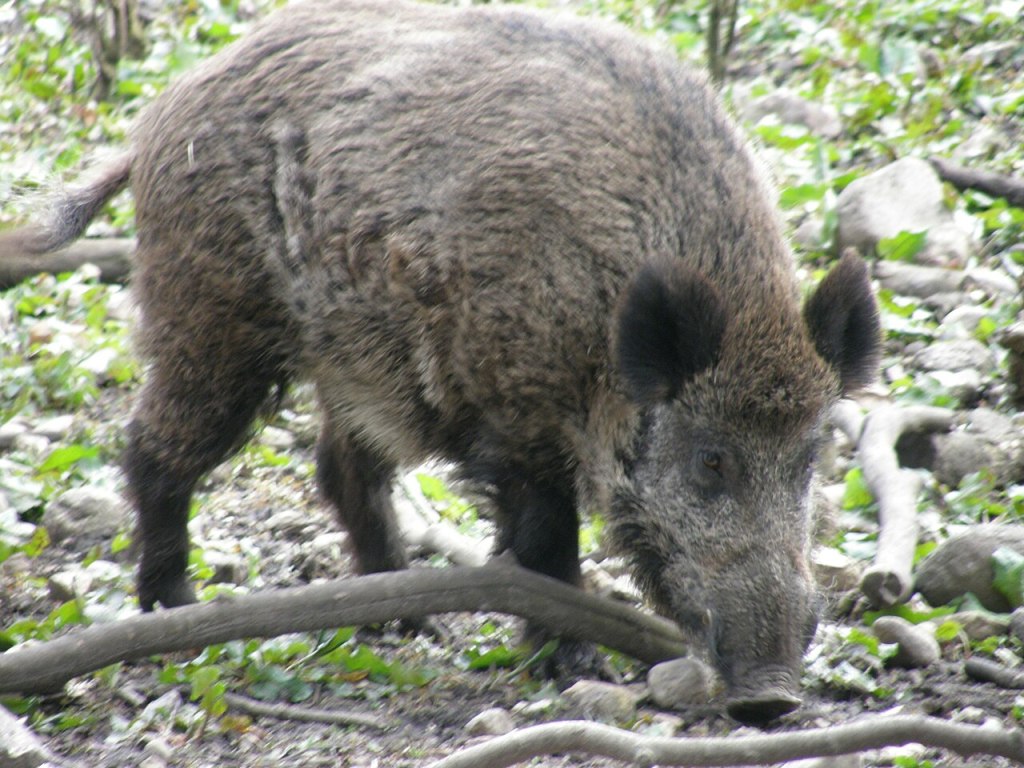
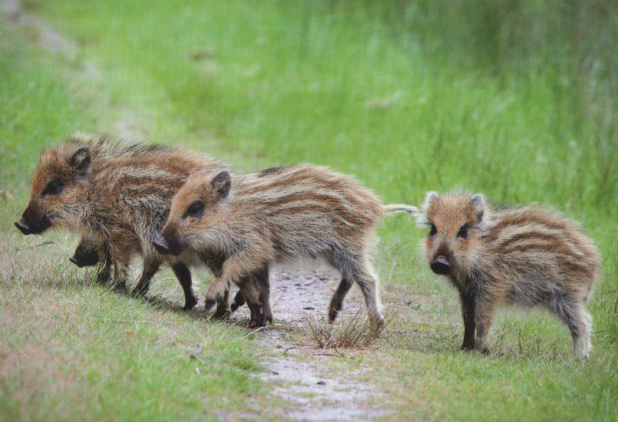
Wild boar are numerous in Tuscany, although unfortunately I’ve never seen one; just heard them and seen their digging trails!
The best time and place to see them is at night near cultivated land. Boar love to feed on grapes in the vineyards. They are hunted between November and January, and boar meat is so popular that one dish – Pappardelle Cinghiale – is known as Tuscany’s national dish.
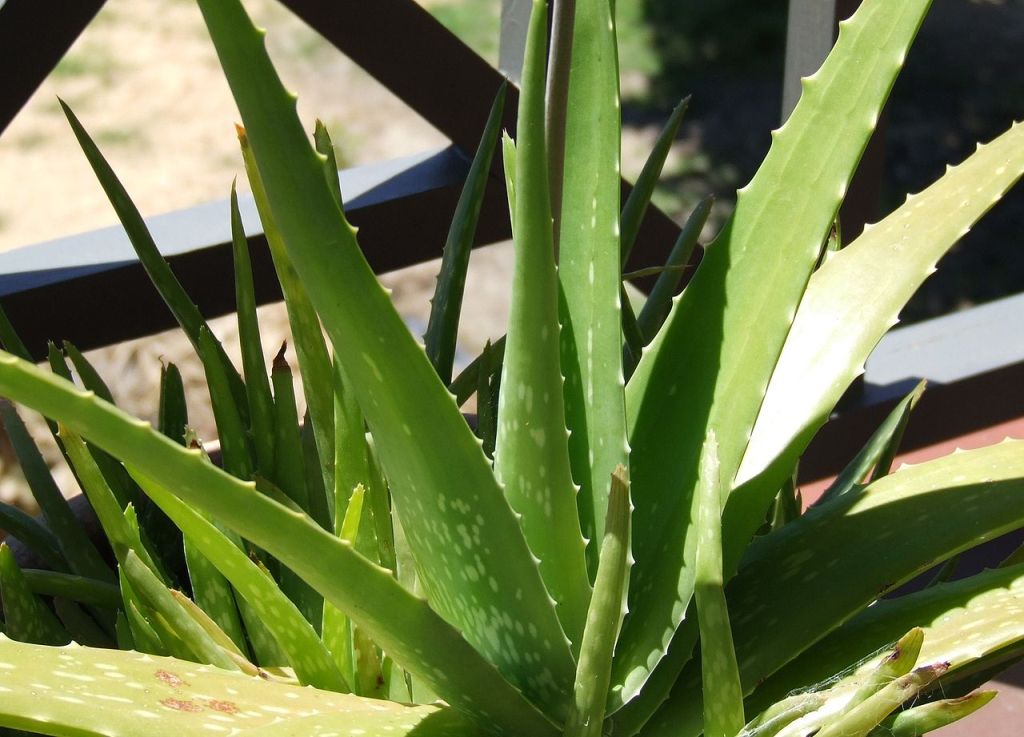
I dabbed some Aloe vera gel from a cut leaf on my ankle in the hope it would speed up the healing process.
Aloe vera is a succulent plant species of the genus Aloe. It is widely distributed, and is considered an invasive species in many world regions. An evergreen perennial, it originates from the Arabian Peninsula, but grows wild in tropical, semi-tropical, and arid climates around the world.
It is cultivated for commercial products, mainly as a topical treatment used over centuries.The species is attractive for decorative purposes, and succeeds indoors as a potted plant.
Aloe gel typically is used to make topical medications for skin conditions, such as burns, wounds, frostbite, rashes, psoriasis, cold sores, or dry skin.Aloe latex is used individually or manufactured as a product with other ingredients to be ingested for relief of constipation. Aloe latex may be obtained in a dried form called resin or as “aloe dried juice”.
Esther won 2-0 with Rummikub tonight and there was a beautiful half moon out there.
Day 19, Monday 23rd October (9 C this morning, 25 C in Arezzo in the afternoon)
A clear sky early this morning with stars but then lots of dew and mist with dawn.
I did a big clearance job of mainly brambles next to the house this morning.
Esther went to help Rita and Fabrizio with weeding in the Wormwood or Alsem field up the mountain.
I picked a lot of leaf beet and tomatoes for Rita to take home.
We went to Arezzo this afternoon after lunch to do various things there:
- I first did some test driving in Esther’s car as I will need to drive her to a parking place near the toll road outside Arezzo next Thursday, where she will get a lift all the way to Bologna where they will attend a conference all about Hildegard von Bingen.
- We drove up to the parking/swap over place near the toll road as to see exactly where to go and how long it would take to get there!
- In Arezzo we went to the cafe for a nice cup of Orzo (me) and something else for Esther.
- Then, a bit later, a very tasty ice cream each with 3 scoops.
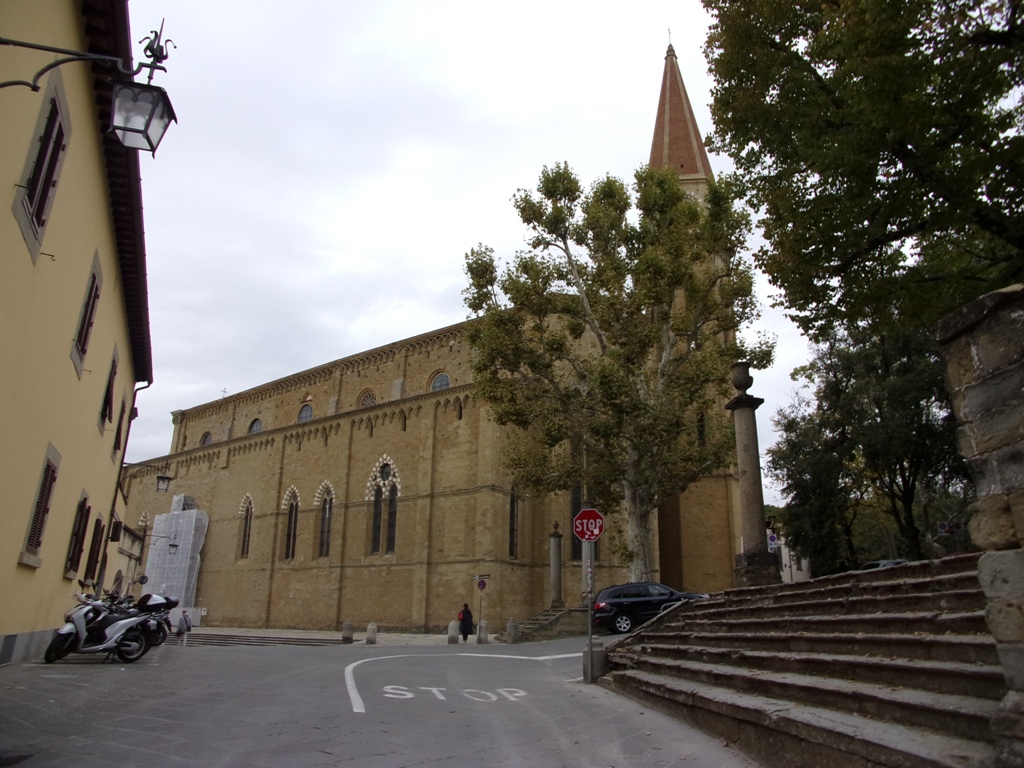
The Cathedral in Arezzo…. The small figure below is myself….
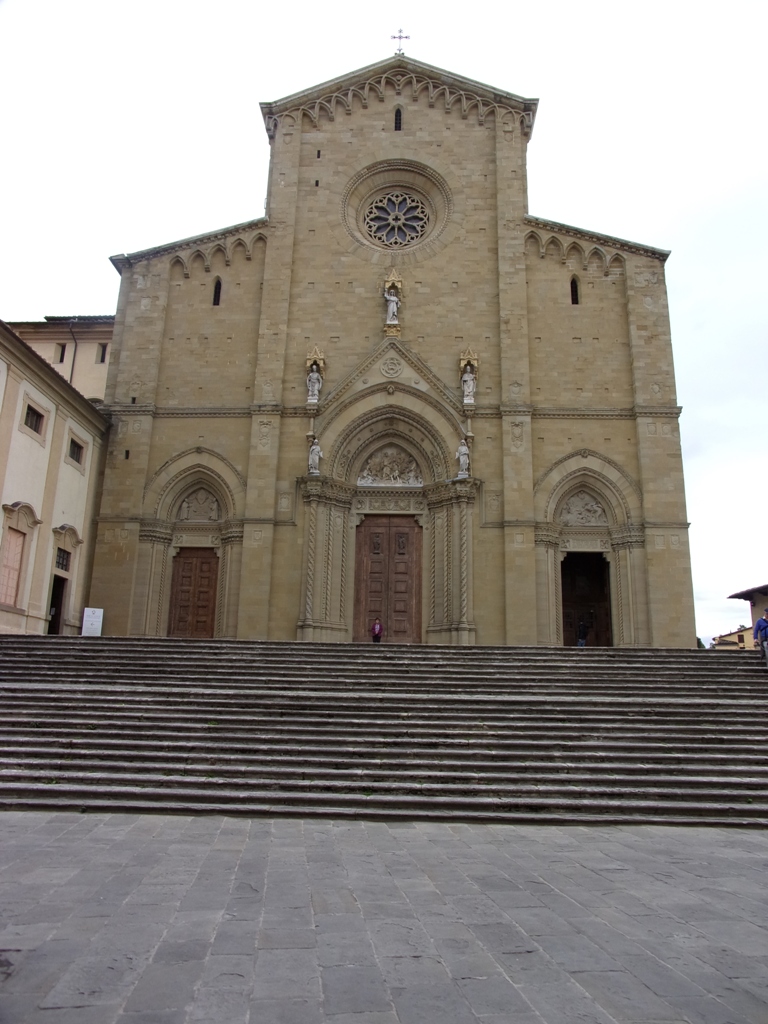
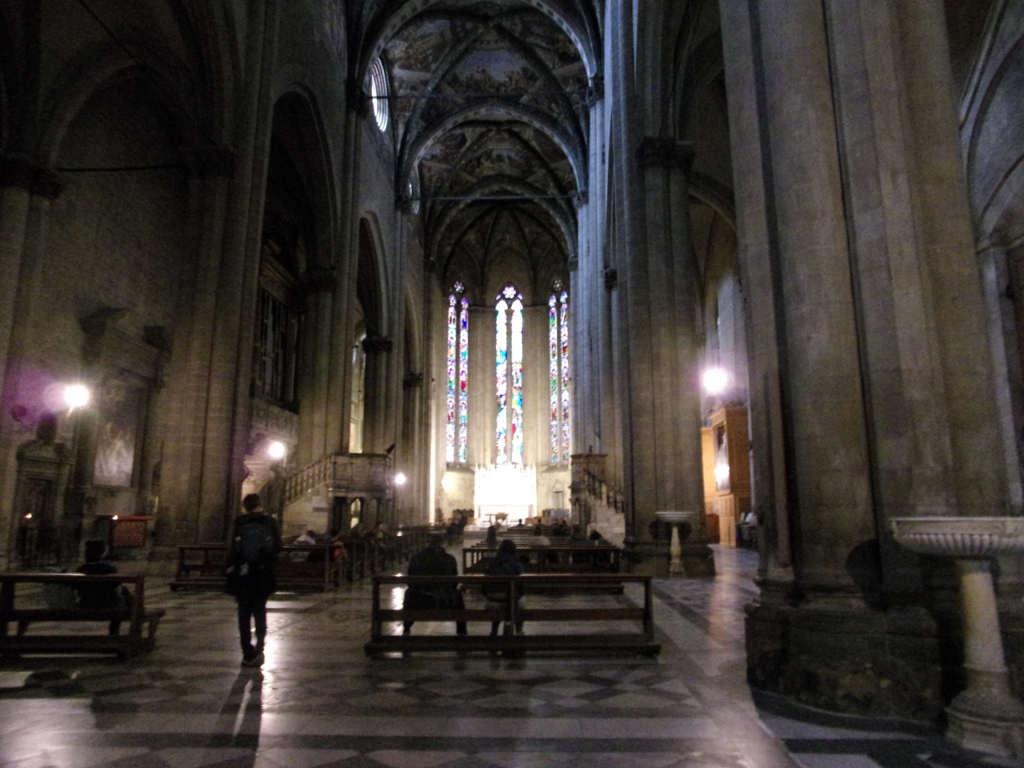
- We walked all the way up to the Cathedral of Arezzo and had a good look inside admiring the large stained windows and other artefacts in there. Afterwards we walked through the park next to the cathedral.
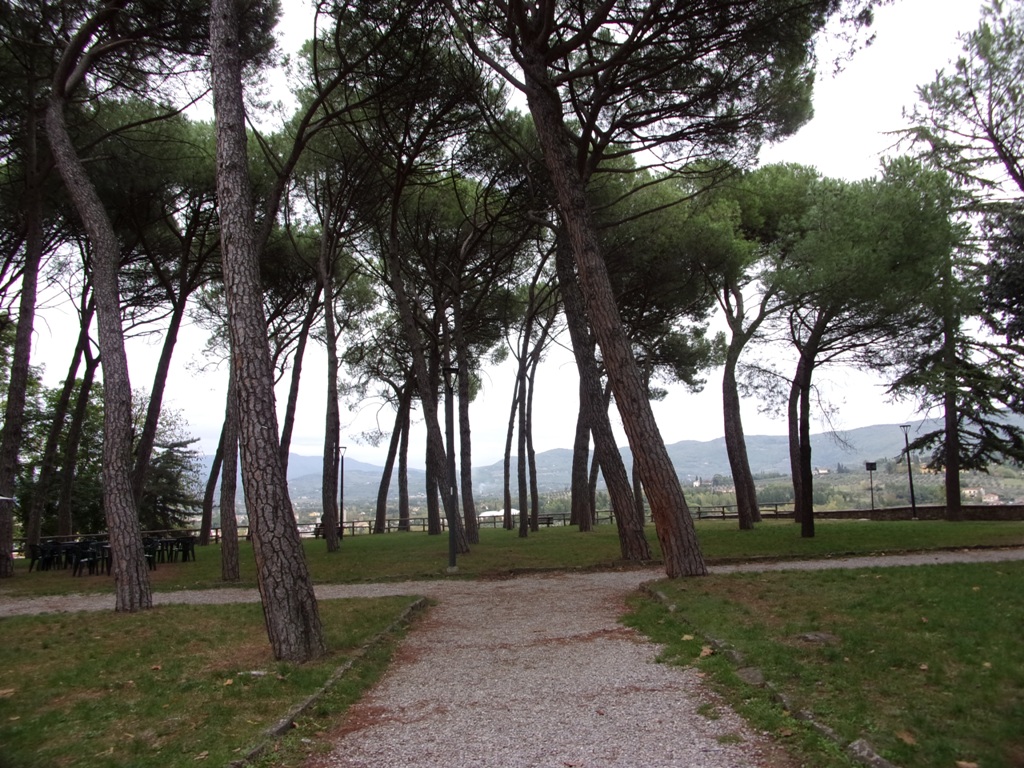
There are many Parasol pines or Stone Pine (Pinus pinea) in the park next to the Cathedral.
The Stone pine, botanical name Pinus pinea, also known as the Italian stone pine, Mediterranean stone pine, Umbrella pine and Parasol pine, is a tree from the pine family (Pinaceae). The tree is native to the Mediterranean region, occurring in Southern Europe and the Levant.
Stone pines have been used and cultivated for their edible pine nuts since prehistoric times. They are widespread in horticultural cultivation as ornamental trees, planted in gardens and parks around the world.
As it is the highest point of Arezzo, there is a good view across to the distant mountains.
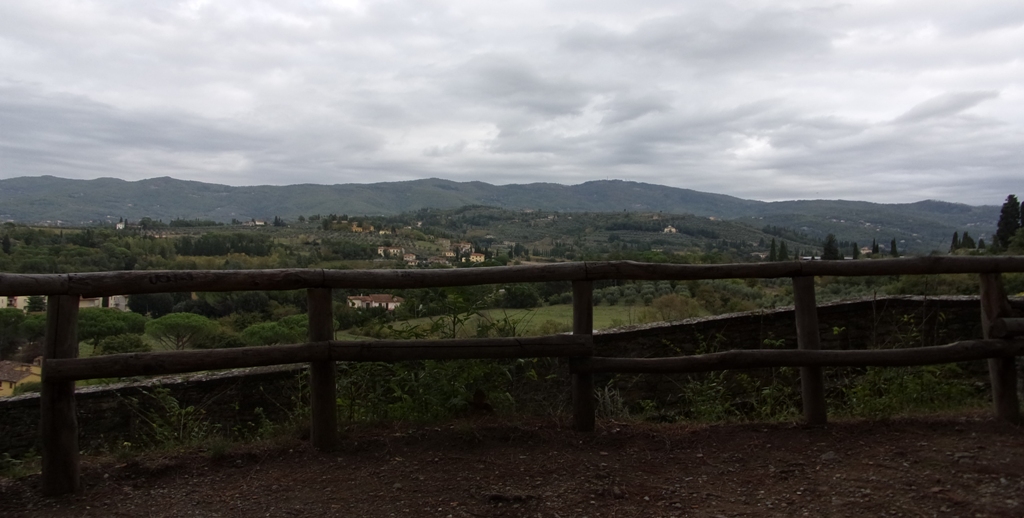
Then, walking back to the car, we went into the Chinese supermarket in order to find a new laundry basket for Esther as the old one is getting ‘past it’; having done many years of faithful service! I also was keen to get another long tubed gas lighter especially for myself, as I find a ‘normal’ lighter a bit tricky! Also found a good brand of Arnica cream which will be useful for my sore ankle.
We then drove to the supermarket or ‘Esselunga’ and I let Esther do the shopping as my ankle had had enough after all the walking that afternoon!
On the way home we got some water at neighbour Lina’s to top up the water tank for East.
Finally we walked uphill to the house with the shopping and new laundry basket. Fortunately we had some pizza ready to warm up to eat that evening!
Day 20, Tuesday 24th October (17 C in the day and a strong south-westerly wind called Sirocco in Italy)
Sirocco is a Mediterranean wind that comes from the Sahara and can reach hurricane speeds in North Africa and Southern Europe, especially during the summer season.
The opposite is the Tramontana, Esther told me:
Tramontana is a north-easterly or northerly winter wind that blows from the Alps and Apennines (South of the Alps) to the Italian coast. It is very prevalent on the west coast of Italy and Northern Corsica.
Esther went off early this morning as she had various things to do in Arezzo as well as going to her yoga group.
I tidied up on the Compost heap terrace.
We had lunch around 1 pm after Esther got back.
- ‘Caprese’ or Tomato salad as a starter
- Rice with broccoli and sour cream
- Chocolate pudding dessert
I carried on with more tidying up after lunch and filled 3 large barrows to put onto the compost heap.
We had spaghetti for dinner with a tomato + courgette sauce + an egg donated by Rita’s chicken!
There was a short rain shower all of a sudden round dinnertime + lots of ‘Sirocco’ wind!
Then still and clear sky again with a half moon this evening!
Esther beat me again this evening at Rummikub (2-0).
Day 21, Wednesday 25th October (13 C in morning and 25 C in Arezzo!)
I had a busy morning clearing the Viola odorata above the Marrubium terrace:
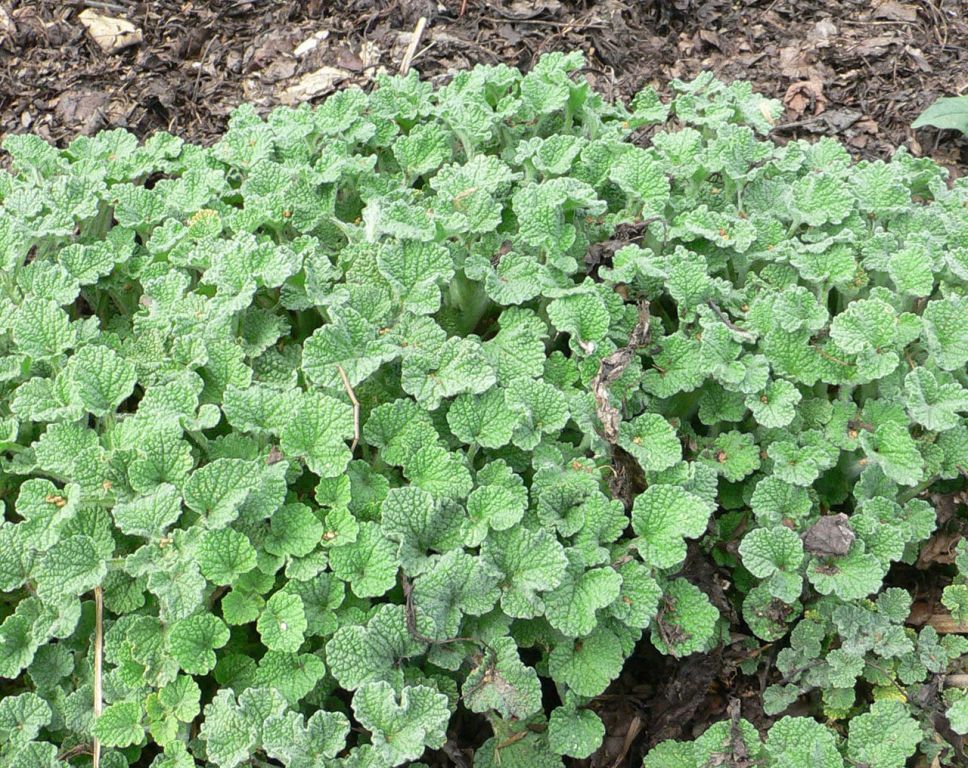
Marrubium vulgare (White horehound or Common horehound) is a flowering plant in the mint family (Lamiaceae), native to Europe, northern Africa, and south-western and central Asia. It is also widely naturalized in many places, including most of North and South America.
White horehound has been mentioned in conjunction with use as a folk medicine dating at least back to the 1st century BC, where it appeared as a remedy for respiratory ailments in the treatise De Medicina by Roman encyclopaedist Aulus Cornelius Celsus.
Marrubium according to Hildegard is benficial for the hearing. Best to have a steambath with the head below a towel.
There were many brambles to dig out around the one patch especially.
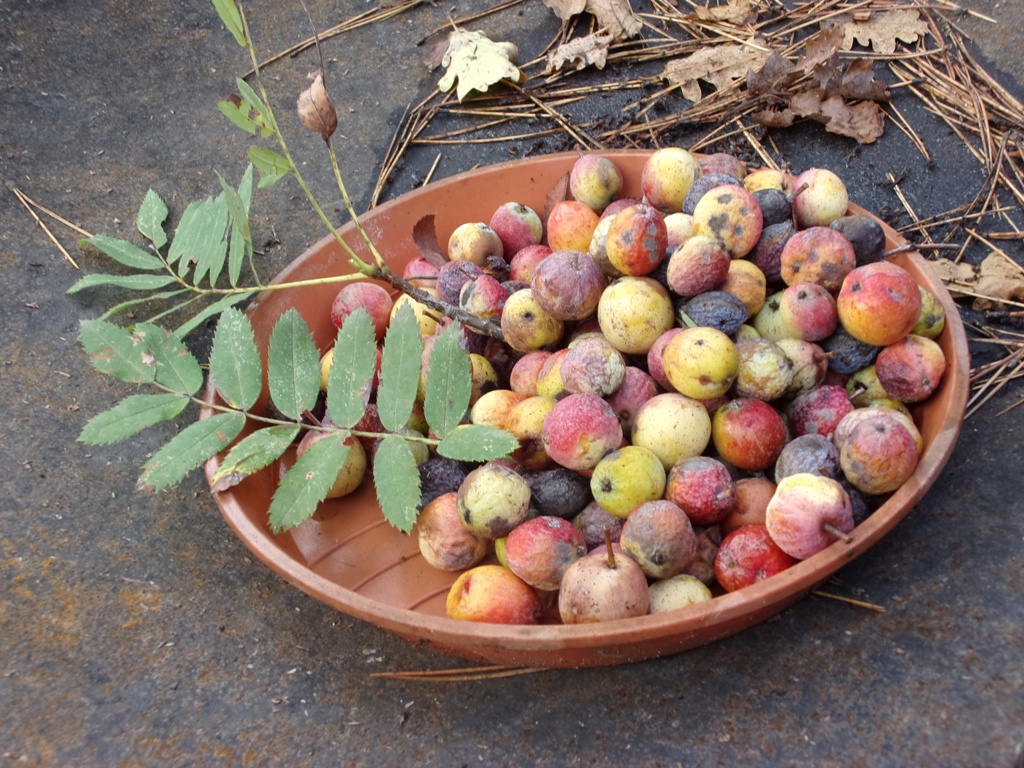
Collected lots of fruit of a plant Esther calls: ‘Sorbo’. East likes to eat them.! I was puzzled what tree this was, first I thought it was a Sorbus, because of the Italian name and the compound leaf. But later I found the name on INaturalist.
Cormus domestica, commonly known as Service tree or Sorb tree, is a species of tree native to western, central and southern Europe, northwest Africa (Atlas Mountains), and southwest Asia (east to the Caucasus). See for map here.
It may be called True service tree, to distinguish it from Wild service tree. It is the only species in the monotypic genus Cormus.
The fruit is a component of a cider-like drink which is still made in parts of Europe. Picked straight off the tree, it is highly astringent and gritty; however, when left to blet (overripen) it sweetens and becomes pleasant to eat. In the Moravian Slovakia region of the Czech Republic, there is a community-run museum with an educational trail and a festival for this tree, with products like jam, juice and brandy made from its fruit.
The wood was often used for manufacturing wooden planes of all types used for working wood, because Service Tree wood is fairly dense and holds a profile well.
After lunch we were visiting several places in Arezzo:
- To neighbours to take some food for East when Esther is away to the conference. The neighbour kindly accepted to feed East as my ankle is still recovering.
- To petrol station to fill up car with diesel.
- To garden and fruit centre to get carrot roots for East.
- To the ‘Esselunga’ for some shopping
- To friend’s cafe to drink some orzo and lemonade
- Back to Palazzo del Perro to get water for soaking East’s food
- More, better quality drinking water from the neighbour’s to fill East’s water tank next to the field.
- Then after going to East, we ascended the track home!
I quickly fetched some nettle tops from the potato terrace for our evening meal with potatoes.
Finally won 2-0 with Rummikub this evening…
Day 22, Thursday 26th October (13 C in morning, rain during night)
Esther was off to the conference in Bolzano today and coming back on Sunday.
I was busy clearing behind the house and had 5 wheelbarrows full!
It was too early for lunch so we had some yoghurt with muesli and we left at 10.45.
We arrived far too early at the meeting place and so we went to a road side cafe for a drink and a little snack.
The three friends from Rome arrived just before 1 pm and I took the car back home.
Unfortunately, I did take the wrong turning and ended up in Arezzo town centre! Eventually I got the correct junction back to Palazzo del Perro.
Very strange to be on my own here with just the cats for company!
I had difficulty in lighting the fire in the kitchen this evening… Fortunately, after several attempts, it did go!!
Day 23, Friday 27th October (rain and hard wind in morning but 19 C in afternoon and sunny/windy)
Lots of wind during the night!
Fabrizio and Rita didn’t come this morning as the weather forecast wasn’t good! But when it was dry I cleaned about 10 crates and eventually brought them to the stable below the house.
I started to make 3 door wreaths with the stems of Clematis viticella, which makes a perfect base. This is a very common climber here.
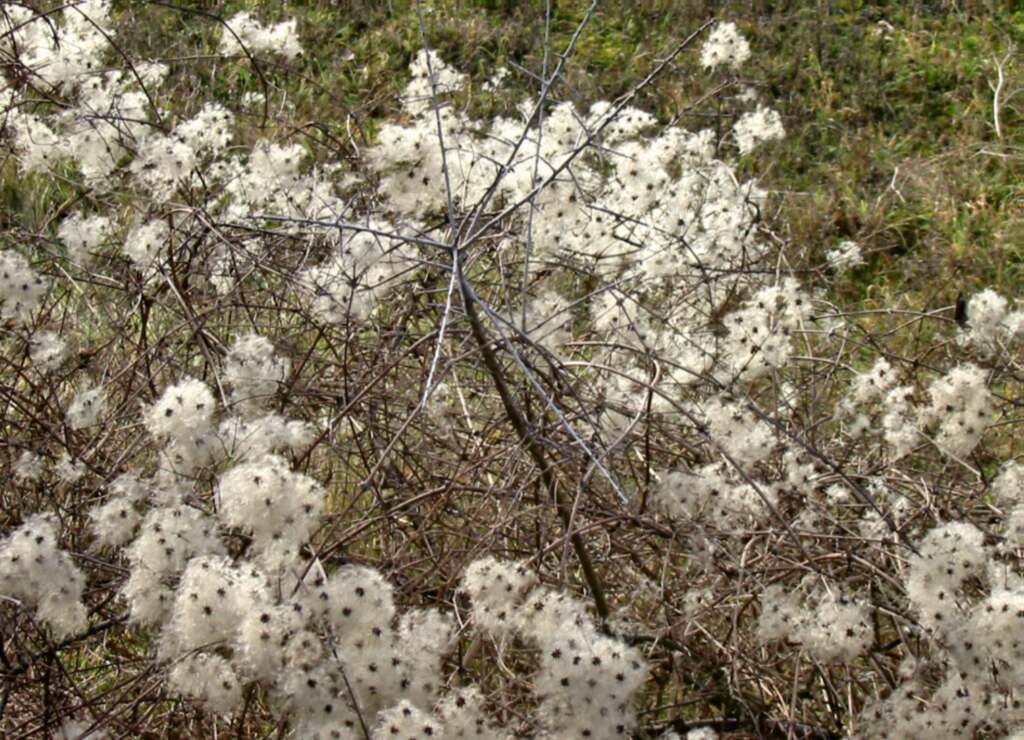
Clematis vitalba (also known as Old man’s beard (when seeding) and Traveller’s joy (when flowering)) is a shrub of the family Ranunculaceae
Clematis vitalba is a climbing shrub with branched, grooved stems, deciduous leaves, and scented greeny-white flowers with fluffy underlying sepals. The many fruits formed in each inflorescence have long silky appendages which, seen together, give the characteristic appearance of old man’s beard. The grooves along the stems of C. vitalba can easily be felt when handling the plant.
Clematis vitalba was used to make rope during the Stone Age in Switzerland. In Slovenia, the stems of the plant were used for weaving baskets for onions and also for binding crops. It was particularly useful for binding sheaves of grain because mice do not gnaw on it. In Italy, the sprouts are harvested to make omelettes (called “vitalbini” in Tuscany, “visoni” in Veneto).
I cleaned around the Geraniums behind the house today!
Difficulty in lighting the fire in the kitchen again…. Esther makes it look so easy!!
Day 24, Saturday 28th October (11 C this morning but sunny day mostly. Beautiful view of Orion and nearly full moon setting in the west!)
Esther phoned from Bolzano to inquire if everything was ok at Marroncello.It is all good there and they are they are very busy in the break times with selling the Hildegard herbs Thomas brought from the firm.
As it was a good, still day, I sieved the plum tree ash (the branches were burnt on Day 1) in the 2 metal buckets. It went exactly in the 2 plastic buckets with lids which Esther had left for me!
I raked the paths on the ‘compost heap’ terrace and the ‘toilet’ terrace and then I cleaned out the St John’s wort bottles near the potato field. They still had the old infused stems in them.
I had a tasty yoghurt with banana and chocolate granola for ‘elevenses.’
I cleared the paths towards the potato terrace. Mainly cut down seedlings of oak and ash.
I managed to light the fire a bit more easily this evening using the Honesty stems and see-through papery fruits as ‘starters’. It is growing abundantly at Marroncello and will be a beautiful sight when it is in flower!
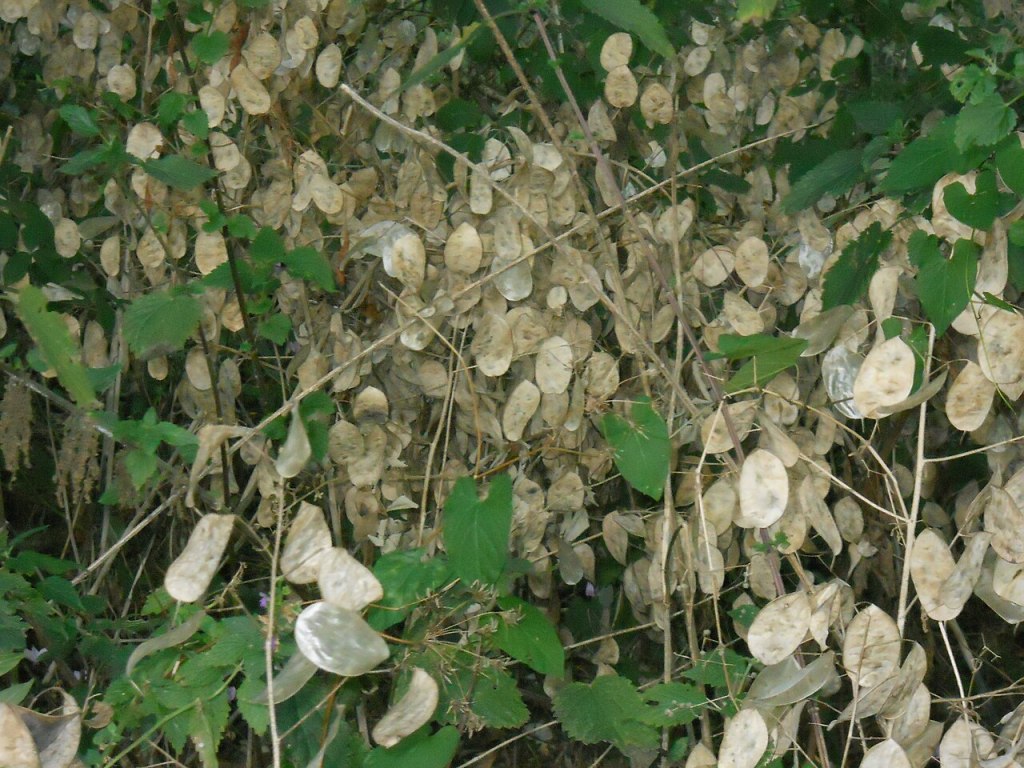
Lunaria annua, commonly called Honesty or annual honesty, is a species of flowering plant in the cabbage and mustard family Brassicaceae. It is native to southern Europe, and cultivated throughout the temperate world.
The Latin name lunaria means ‘moon-shaped’ and refers to the shape and appearance of this species’ siliques. The common name “honesty” arose in the 16th century and relates to the translucence of its silique membranes, which “truthfully” reveal their contents. Additional English names include money plant, moneywort, penny flower, silver dollar, and money-in-both-pockets, Chinese money, or Chinese coins. These, too, reference the silique membranes, which have the appearance of silvery coins. In French it is known as monnaie du pape (“Pope’s money”). In Denmark it is known as judaspenge and in Dutch-speaking countries as judaspenning (both meaning “coins of Judas”), an allusion to the story of Judas Iscariot and the thirty pieces of silver he was paid for betraying Christ.
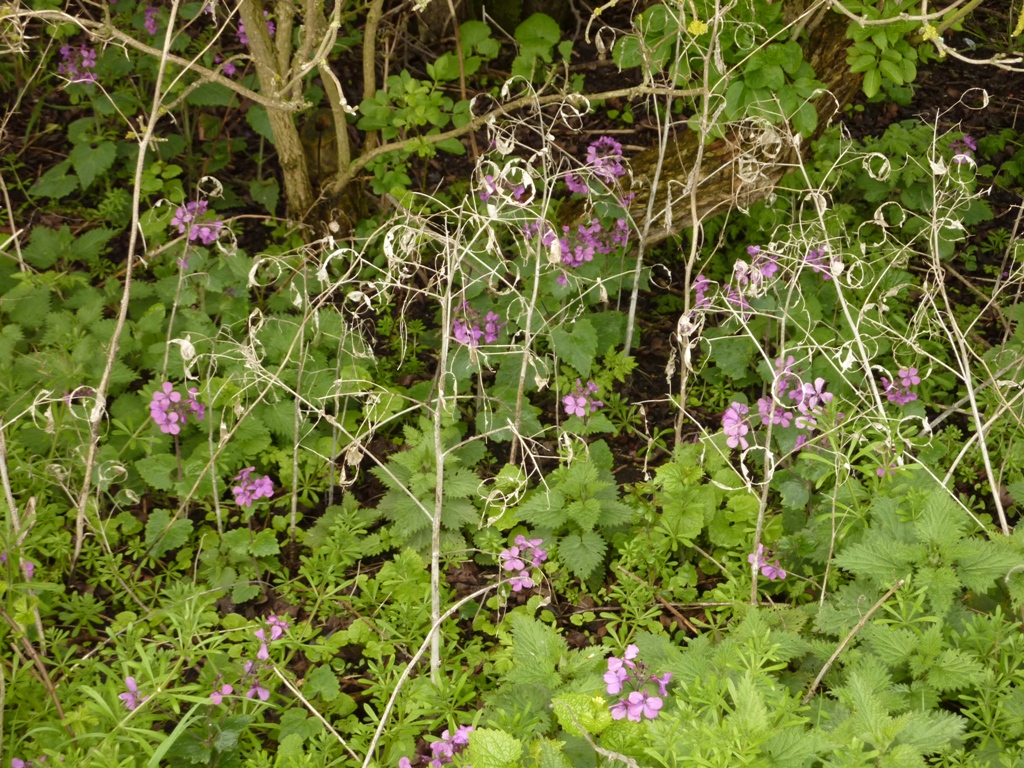
This plant is easy to grow from seed and tends to naturalize. It is usually grown as a biennial, being sown one year to flower the next. It is suitable for cultivation in a shady or dappled area, or in a wildflower garden and the flowers and dried siliques are often seen in flower arrangements. Numerous varieties and cultivars are available, of which the white-flowered L. annua var. albiflora and the variegated white L. annua var. albiflora ‘Alba Variegata’ have won the Royal Horticultural Society‘s Award of Garden Merit
Beautiful full moon rising in the East!
The ‘summer’ hour is going back tonight!
Day 25, Sunday 29th October (sun and cloud today and 16 C)
I will be fetching Esther later this afternoon, she will be driving the car back to Marroncello and I will carry on with the 3 friends to Rome to have bloodletting treatment on Monday morning.
Did a good weeding job on the viola terrace today just below the house.
Saw a whole group of birds flying south.
Collected vegetables from the various terraces to give to the 3 ladies in Rome: Rocket (or Rucola), lettuce, beans, parsley, (Florence) fennel and tomatoes.
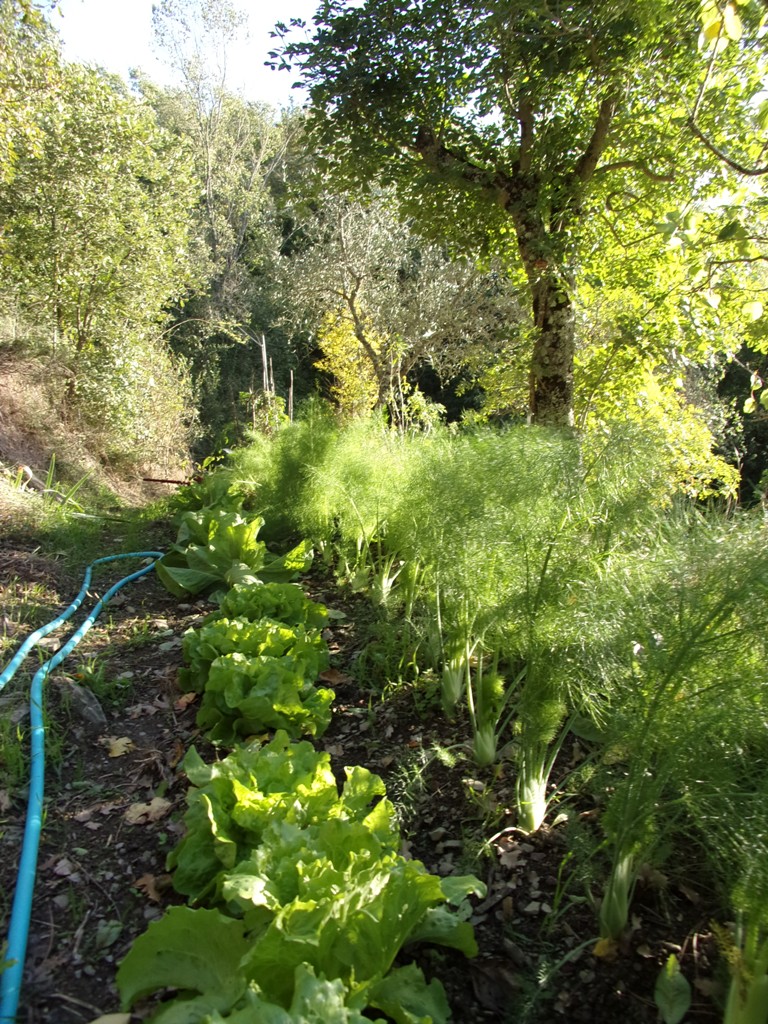
Esther is not due back until late afternoon but I choose to leave before sunset as it is just easier, hopefully, to find my way to the car park meeting place.
Left Marroncello at 16.50 and I got to the parking place an hour later which included taking one wrong turn!
Brought a book to read with me, fortunately, and they arrived at 19.45.
It was about 2 hours later when we arrived in Rome at the guesthouse ‘Santa Maria degli Angeli’
I was shown my room, number 6, which was a very nice, comfortable room with en-suite.
Day 26, Monday 30th October (sun and very warm in Rome!!)
Got up early and, after getting dressed, I wandered outside into the yard. The environment was completely opposite to the tranquil Marroncello, with tall townhouses all around, but I was admiring 2 large Stone Pines close-by, which maybe at least 100 years old. There were several troughs with plants and a very fragrant Jasmine, the Common Jasmine.
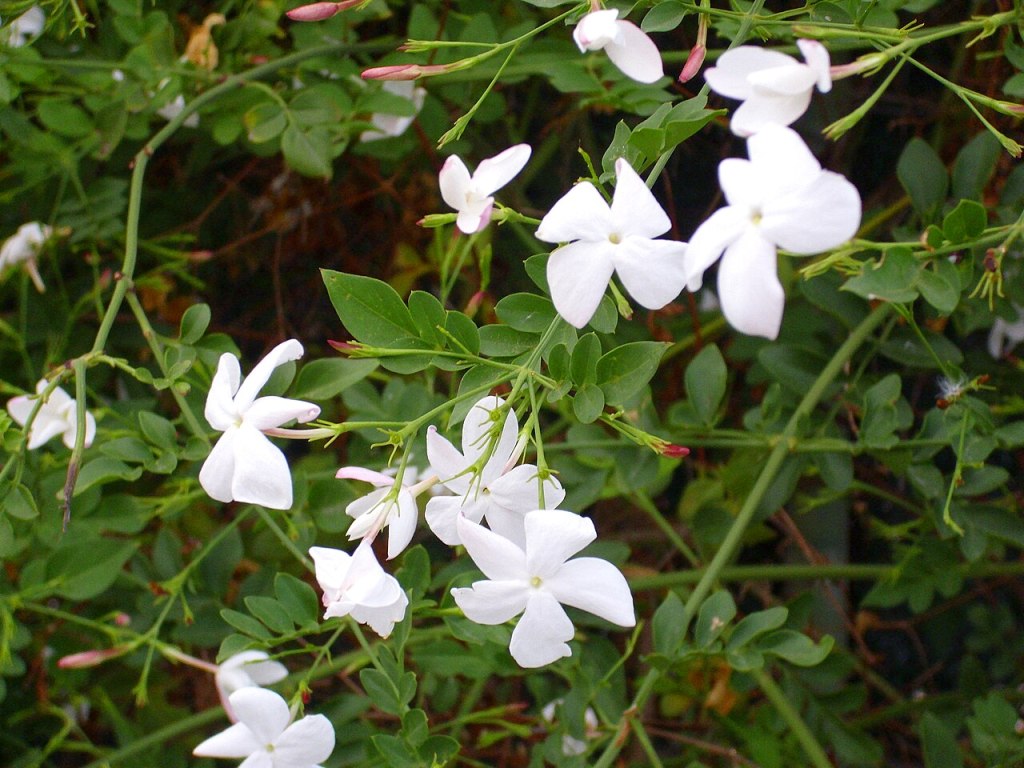
Jasminum officinale, known as the Common jasmine or simply Jasmine, is a species of flowering plant in the olive family Oleaceae.
It is particularly valued by gardeners throughout the temperate world for the intense fragrance of its flowers in summer.
Jasminum officinale is so ancient in cultivation that its country of origin, though somewhere in Central Asia, is not certain!
It was a very special day today, given as a ‘present’ from Thomas & Esther.
I will have a bloodletting treatment which is supposed to be cleansing; to get rid of the ‘old blood’. I also did have it done in February where it wasn’t possible to get much blood out; being too thick! This time K. managed to draw out 3x the amount, but she had to stop early as I was getting dizzy!
I soon recovered when K. got me to rest on the couch and I then had a good breakfast to strengthen myself up again! The first 3 days I am not allowed to have any dairy as well as (raw) fruit. Also exposure to the internet is not wise, so I will need to refrain from going on the computer.
K. gave me a map of Rome and explained where the train station was in order to catch a train back to Arezzo!
It seemed simple and I was hoping to get the train from 13.45, so there was plenty of time to have a walk in the park nearby. This park had many interesting trees and I heard the familiar sound of the green parakeets, which are now a familiar sight also in Walsall and many other European towns and cities.
It was very hot to walk though and my ankle wasn’t too good either and so I didn’t stay too long and decided to go and find the main train station. It was not as easy as I had presumed as it was all underground and not visible. Fortunately I had my map, but actually trying to find the trains was very confusing as it was a maze of alleyways below the ground!
Also getting a ticket wasn’t straightforward. I was going to miss my train but ‘fortunately’ it was delayed for more than an hour and so I had a pizza but still only just made the train, which was a long distance away from the main hall!!
It all went wrong with the connections and I only ended up in Arezzo at 6pm. Esther had been ‘hanging around’ for hours in Arezzo!
We got some water on the way back home to Marroncello and fed East for the night.
Fortunately I had got my headlamp with me as it was dark by the time we ascended to the house.
We had rain and storm in the night. Good to be back at Marroncello though and we played some Rummikub in the evening which I won 2-0!
Day 27, Tuesday 31st October (mixed weather: early rain, blue sky at 9am and overcast in the afternoon)
Esther went early to East in order to avoid the rain.
I was busy, already packing my bag as good as possible ready for tomorrow.
I managed to remove a splinter which had been sitting in my middle finger for several days!
Finalised making the 3 wreaths, adding a few more items including some Amaranthus flowers, from the ‘shower’ terrace, these have a rich, dark red colour.
Peeled some sweet chestnuts for the soup we are having for lunch!
We also had buckwheat, pumpkin and broccoli.
Esther took us to Monte Dogana this afternoon, where we did go briefly in February but the weather wasn’t very pleasant then!
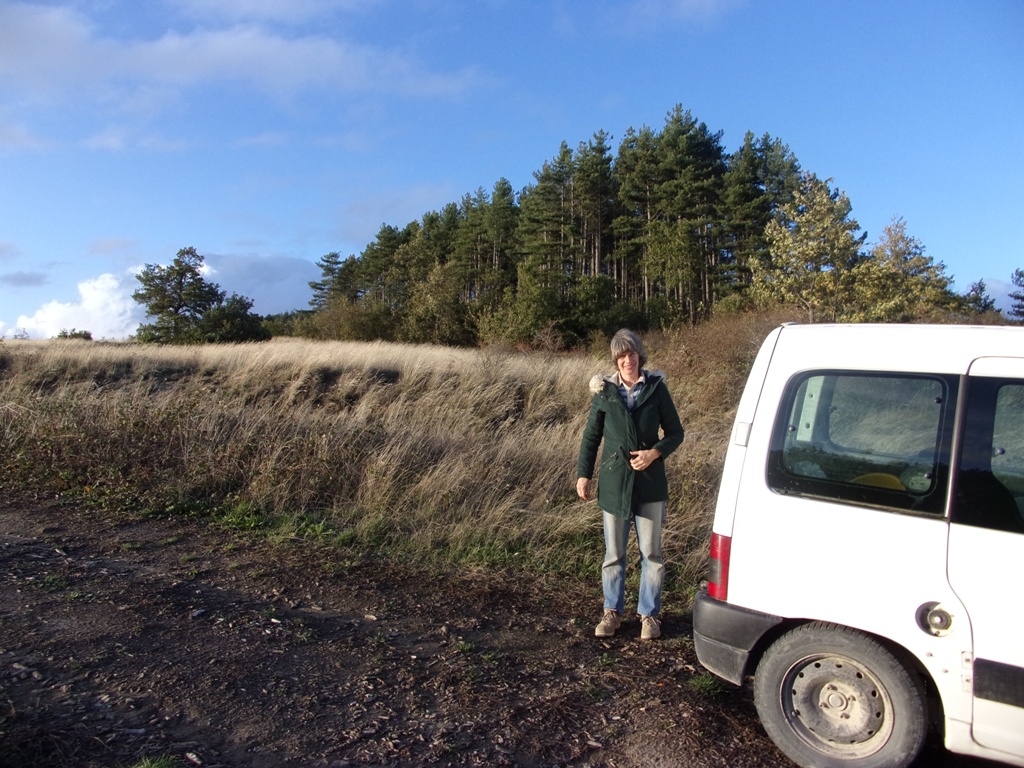
This time it was much better and we walked quite a distance up the hill, but not the whole way as the sky was a bit threatening with rain and my ankle also couldn’t really take it! This area is a popular picnic spot in the summer months and has many benches as well as barbecue places.
Fortunately it did stay dry and the road to Monte Dogana was also very attractive and had many S-bends, making it entertaining! I noticed several spots along the road where wild boar had been disturbing the soil.
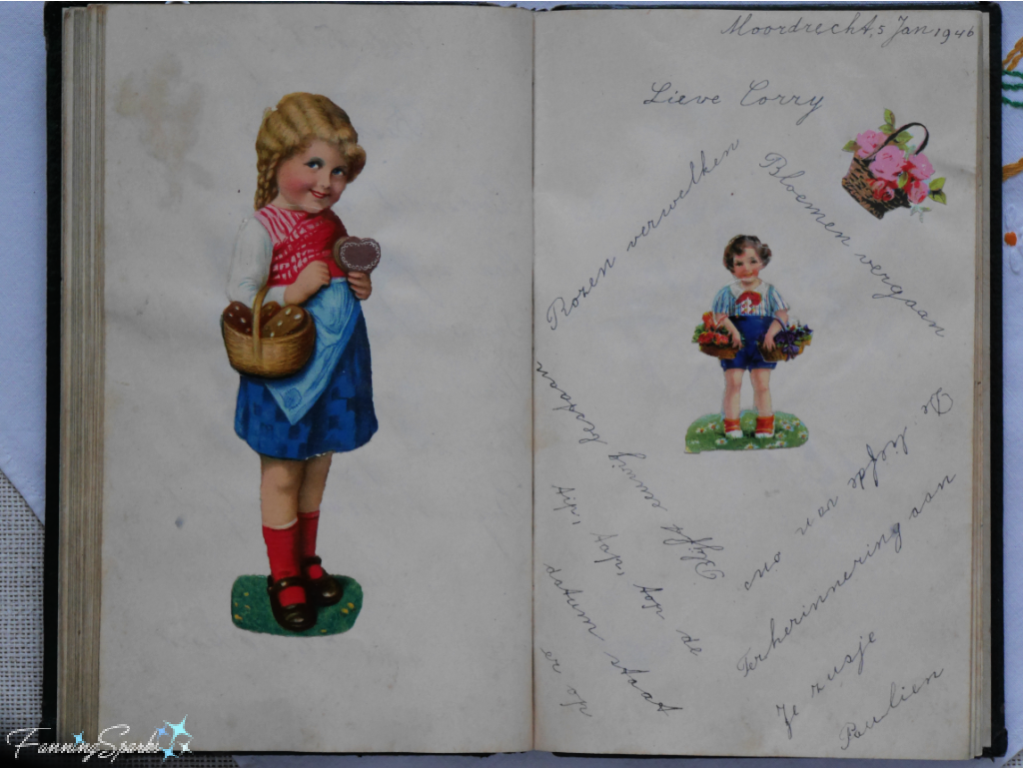
I finished my ‘entry’ in Esther’s ‘poëzie’ or poetry album. This is a very ‘Dutch’ thing I think, which I also had as a child in the primary school. All your friends and family can write something nice and personal to give a lasting memory. It is mostly a short rhyme and pictures or a drawing added.
It derives from the album amicorum (‘album of friends’, friendship book) which was an early form of the poetry book, the autograph book and the modern friendship book.
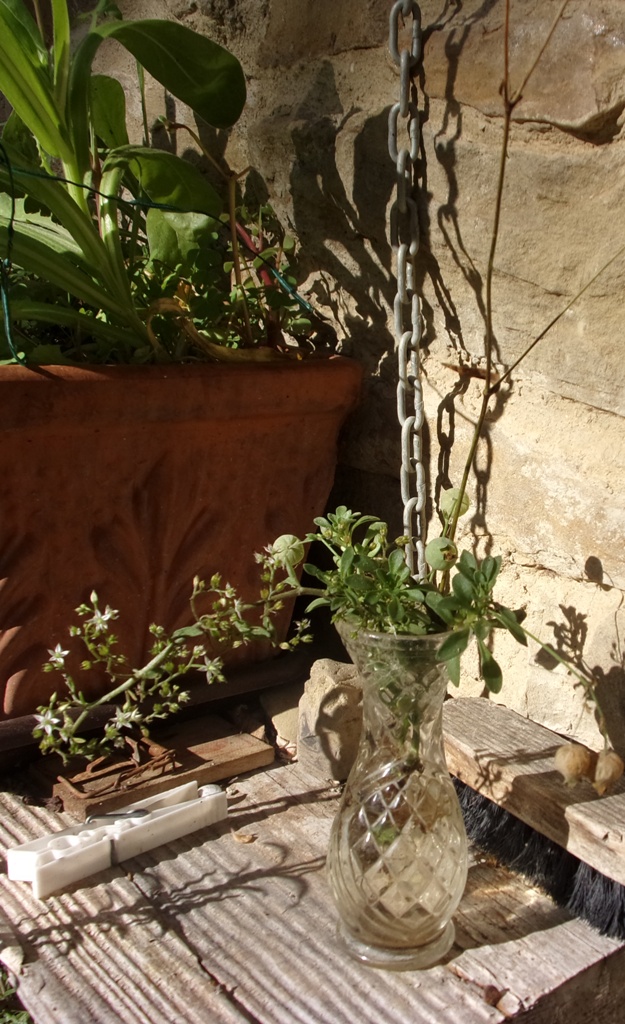
I didn’t do a rhyme but I did do a small drawing of a vase with some flowers.
In the evening we had buckwheat with leaf-beet.
Last game of Rummikub this evening: 1-1!!
Day 28, Wednesday 1st November: last day in Italy! (Misty and 9 C at 8 am)
Got up early and had my usual porridge with apple this morning.
Tidied up my bedroom, packed my suitcase and cleaned the floor.
I wanted the train from 11 am from Arezzo so we left early to go and feed East and have a slow walk to the station. We had a last drink in the cafe at the station with a croissant and Esther bought my one-way ticket to Bologna.
It was quite a journey, arriving and changing trains twice. I arrived in Florence just before midday and then took a train to Prato at 12.09. Then a train from Prato at 12.40 arriving in Bologna just 70 minutes later. Here I took a small train called the Marconi which takes you directly to the Airport.
It all went to ‘plan’ and I arrived very early at the Airport, which was fine as I was able to relax and get my boarding pass from the KLM desk. The flight was to Schiphol first and then on to Birmingham Airport which also had a delay of half an hour!
Chris came to pick me up from Car Park 5 with friendly dog Barnie.
Arrived home in Walsall just before 10!!
Some more native weeds around Marroncello
There were not too many wildflowers flowering at this time of the year but there are always some interesting plants to see in any season:
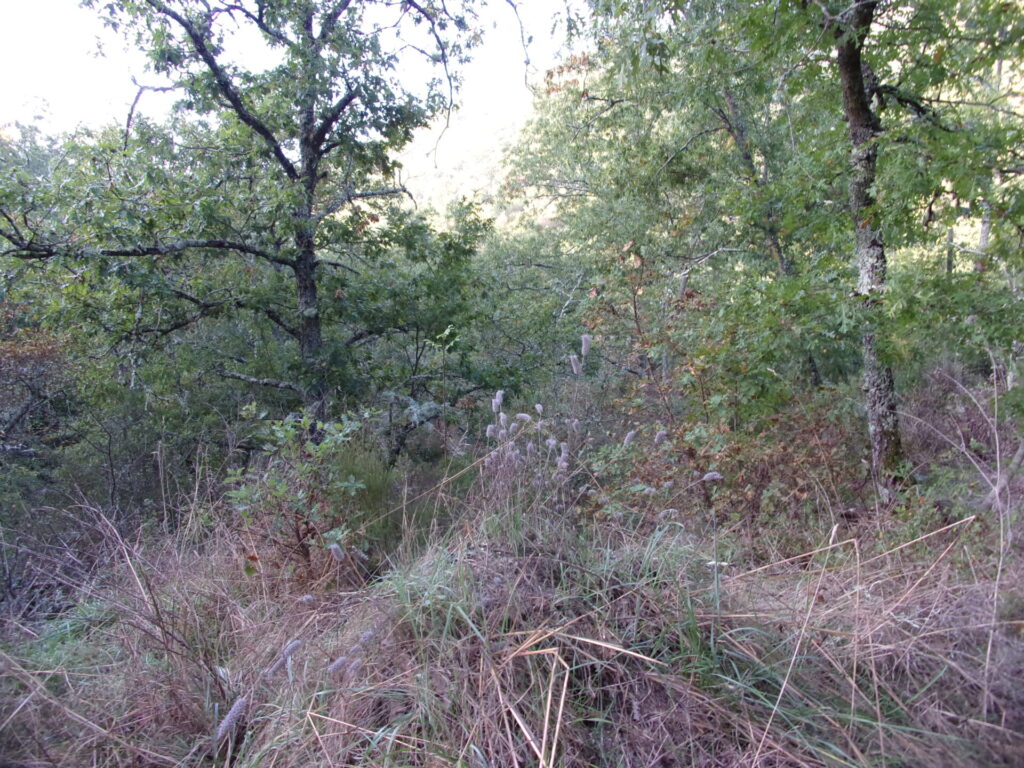
Trifolium angustifolium or Narrow-leaved Clover seed-heads along the track and close-up
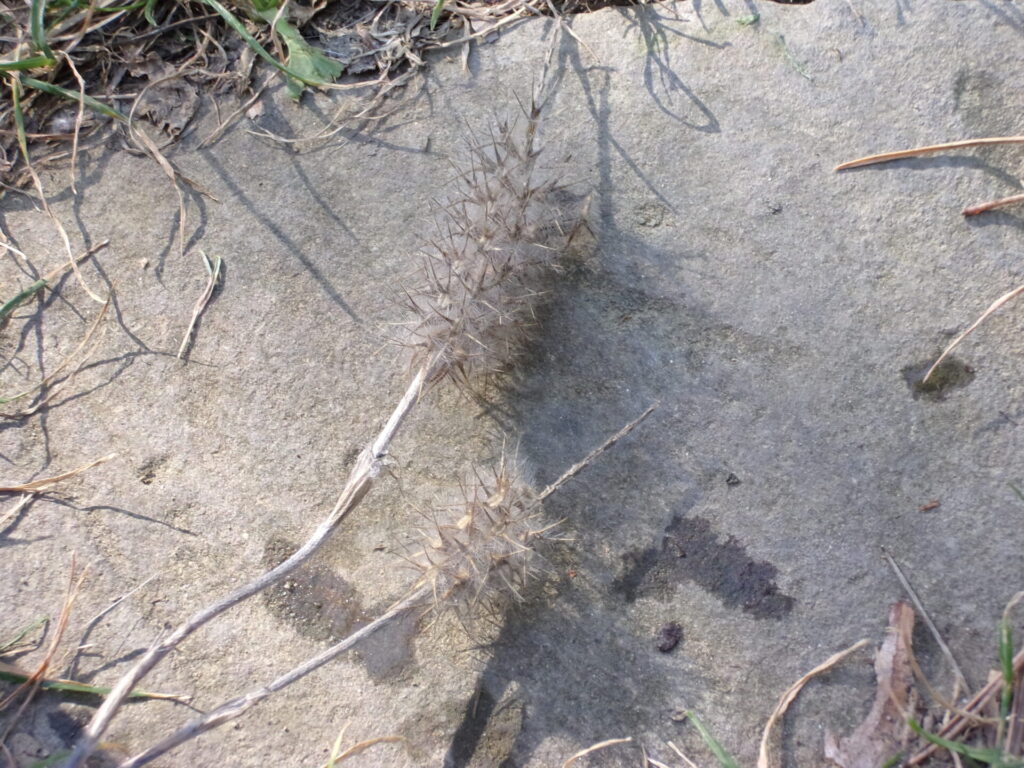
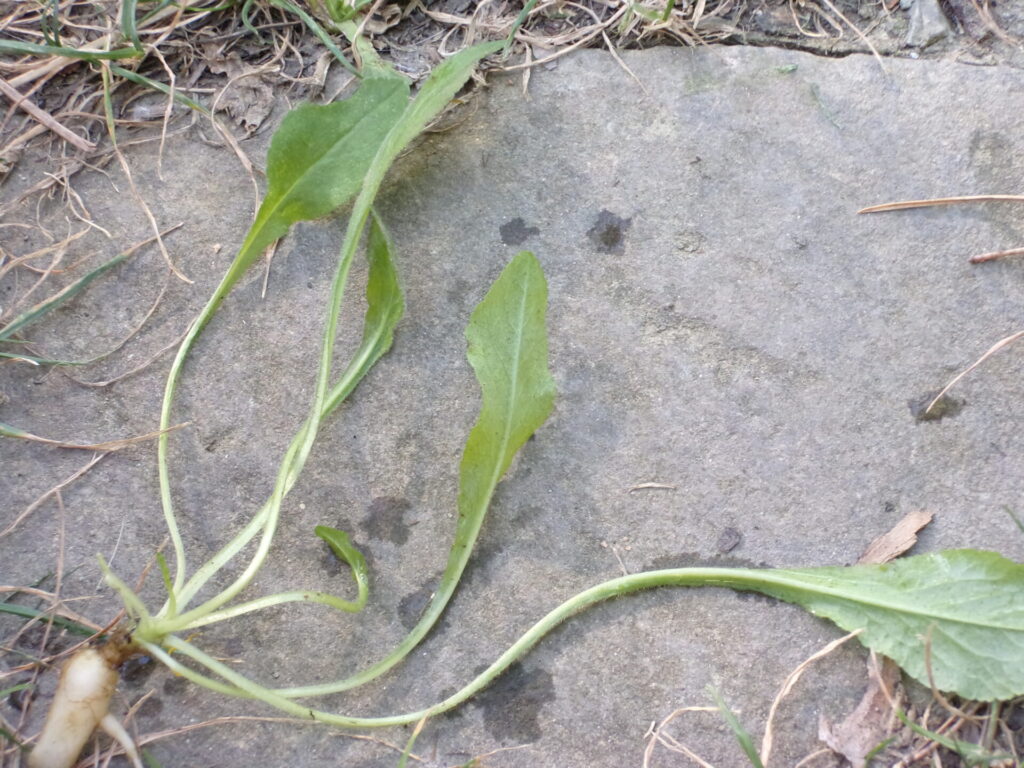
2 non-flowering ‘weeds’ in the viola crop near the toilet: perhaps Campanula rapunculus or Rampion bellflower above and Leucanthemum cuneifolium or a type of ‘Daisy’ below.
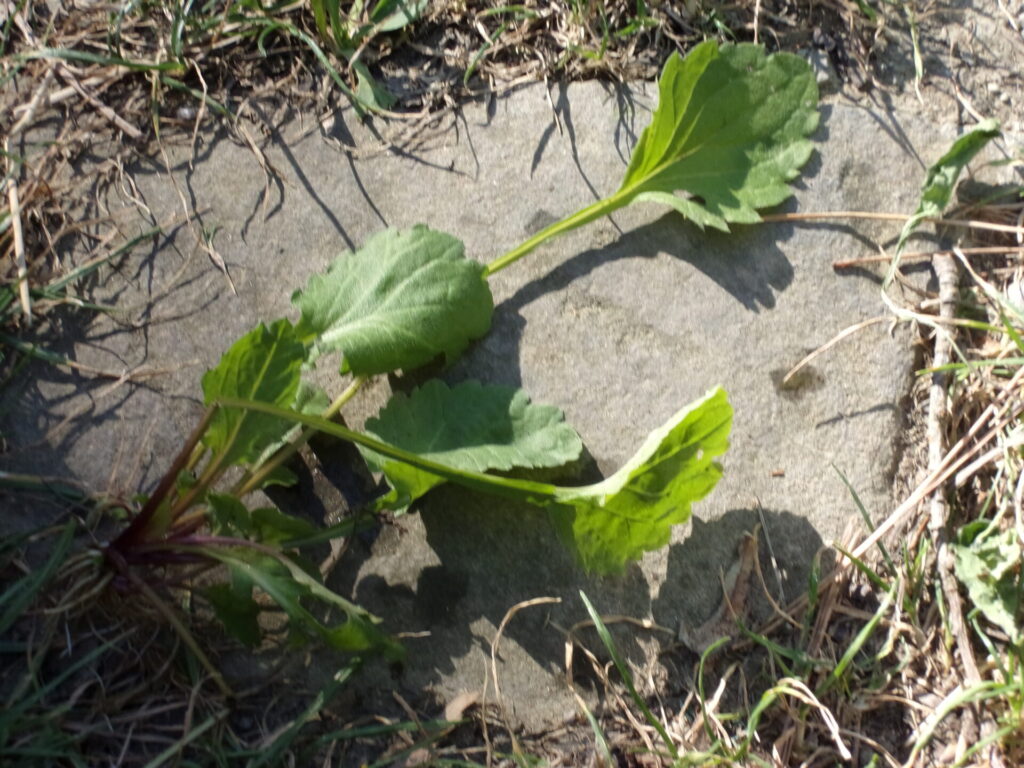
Conclusion
I had an excellent 4 weeks at Marroncello, despite the spraining of my ankle on day 10!
The weather had been favourable again, just like in February it was mainly dry. It was surprisingly warm and summer-like especially in the first few weeks!
There are always new things to learn about the crops, food and way of life! It would be good to grasp a bit more Italian before I go again, although speaking the language doesn’t come easy!!
